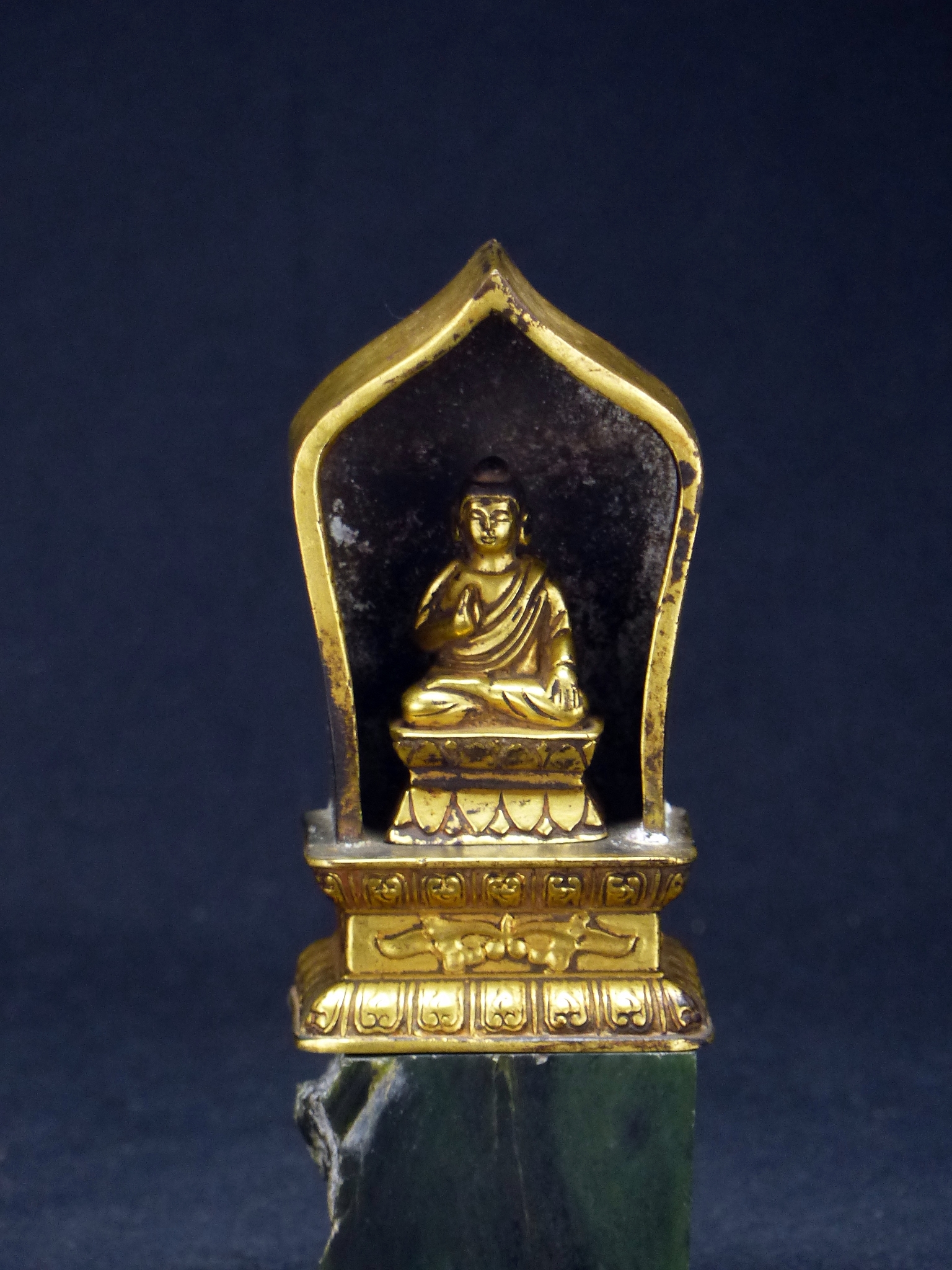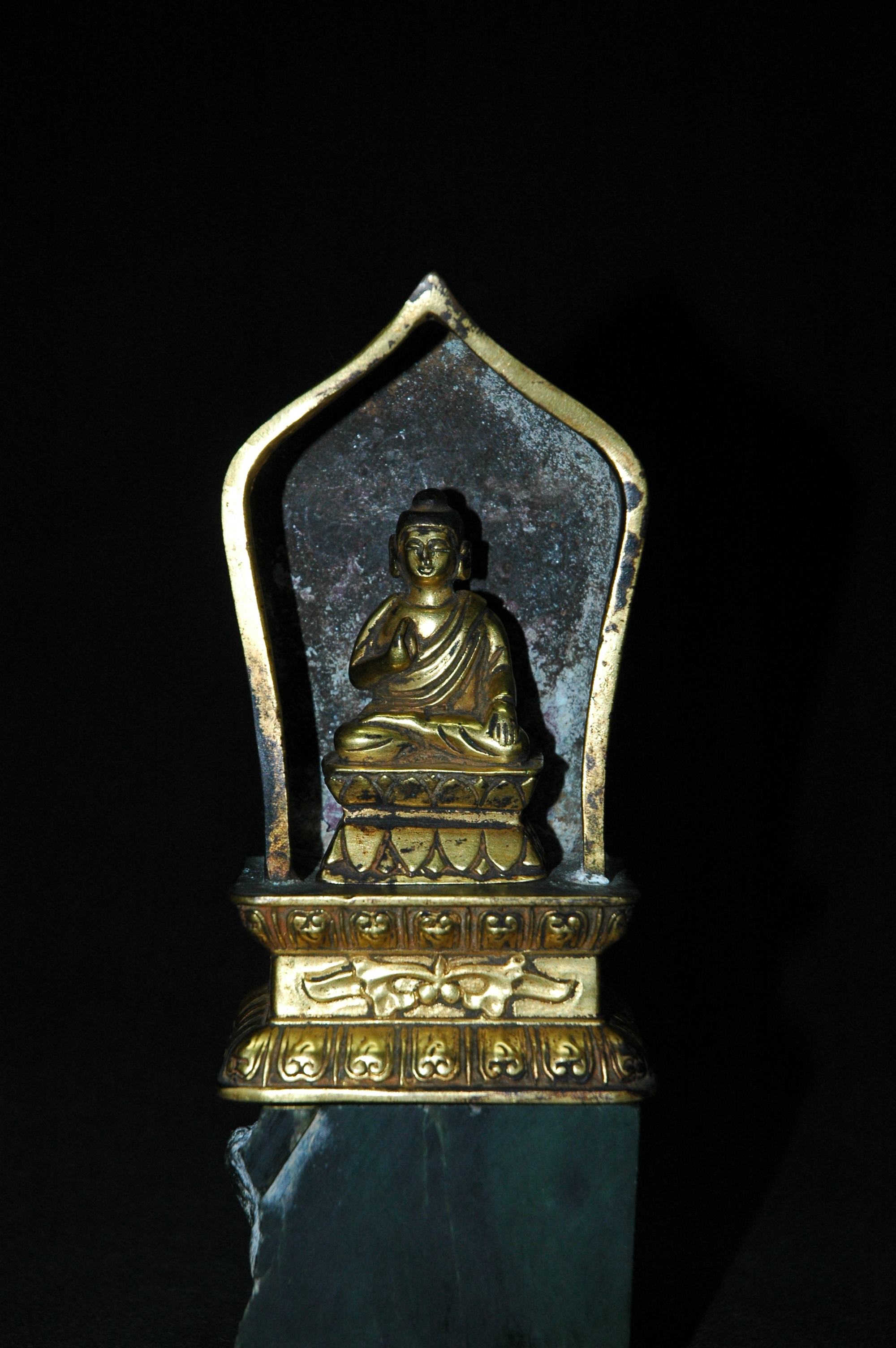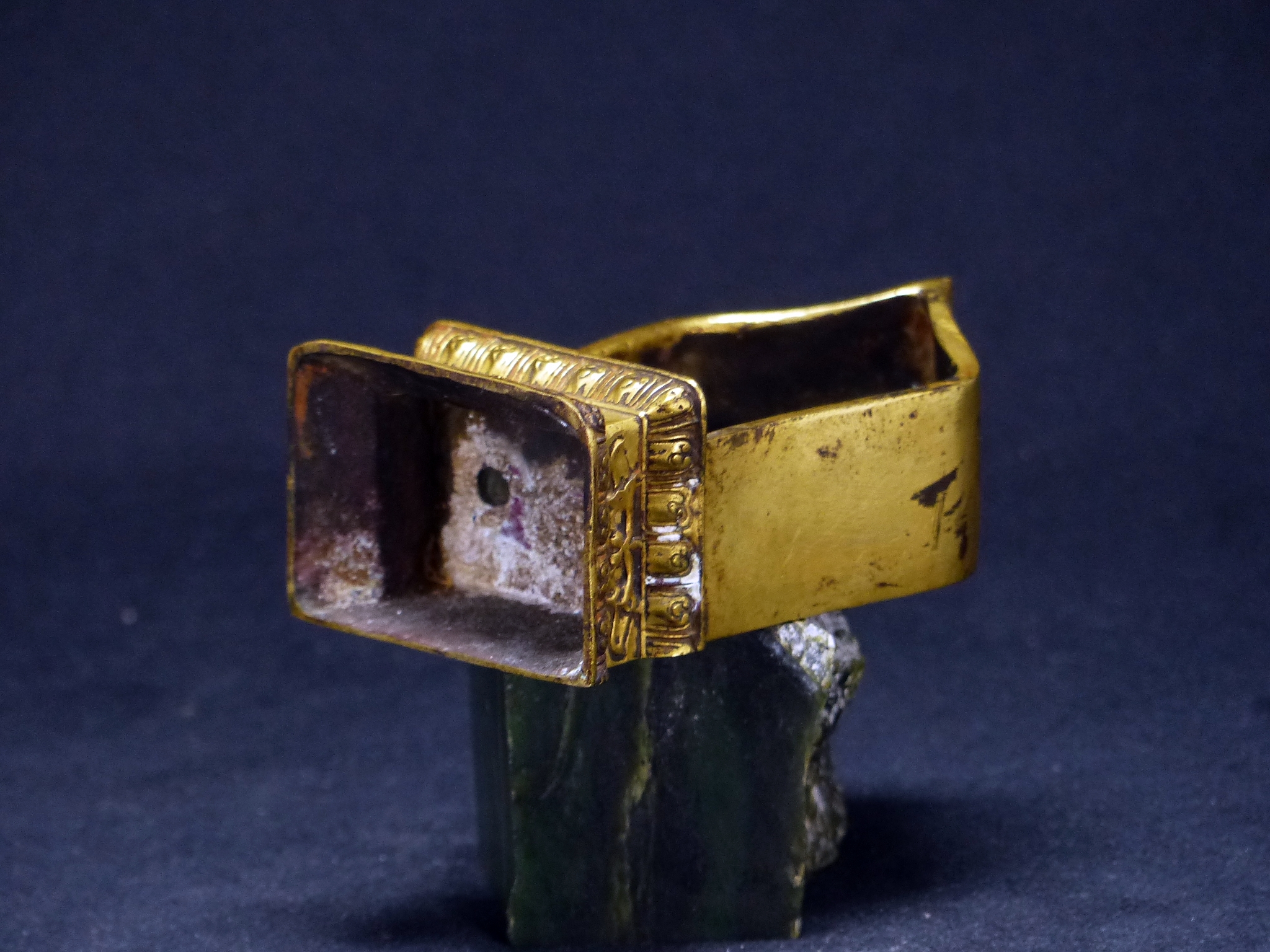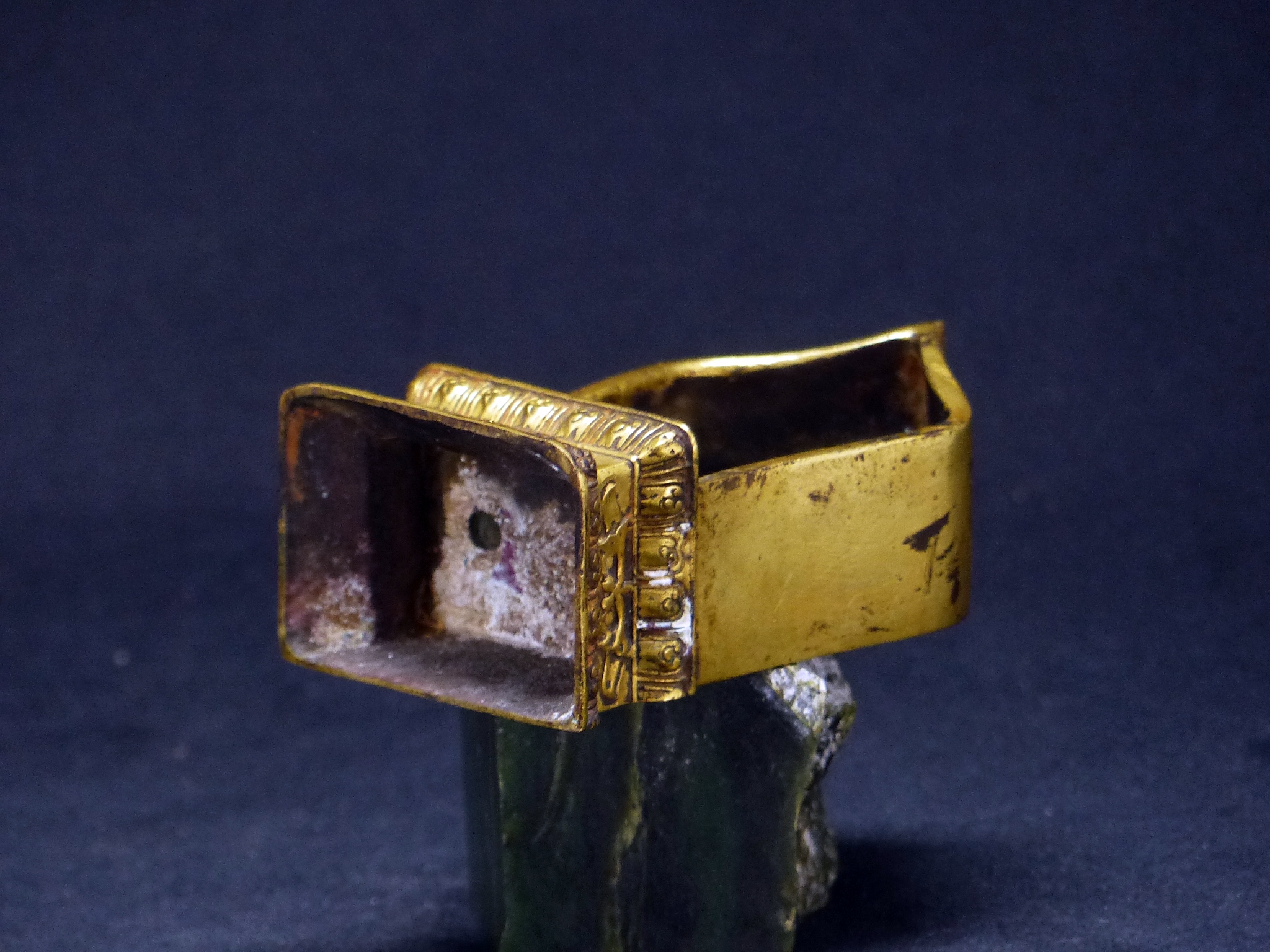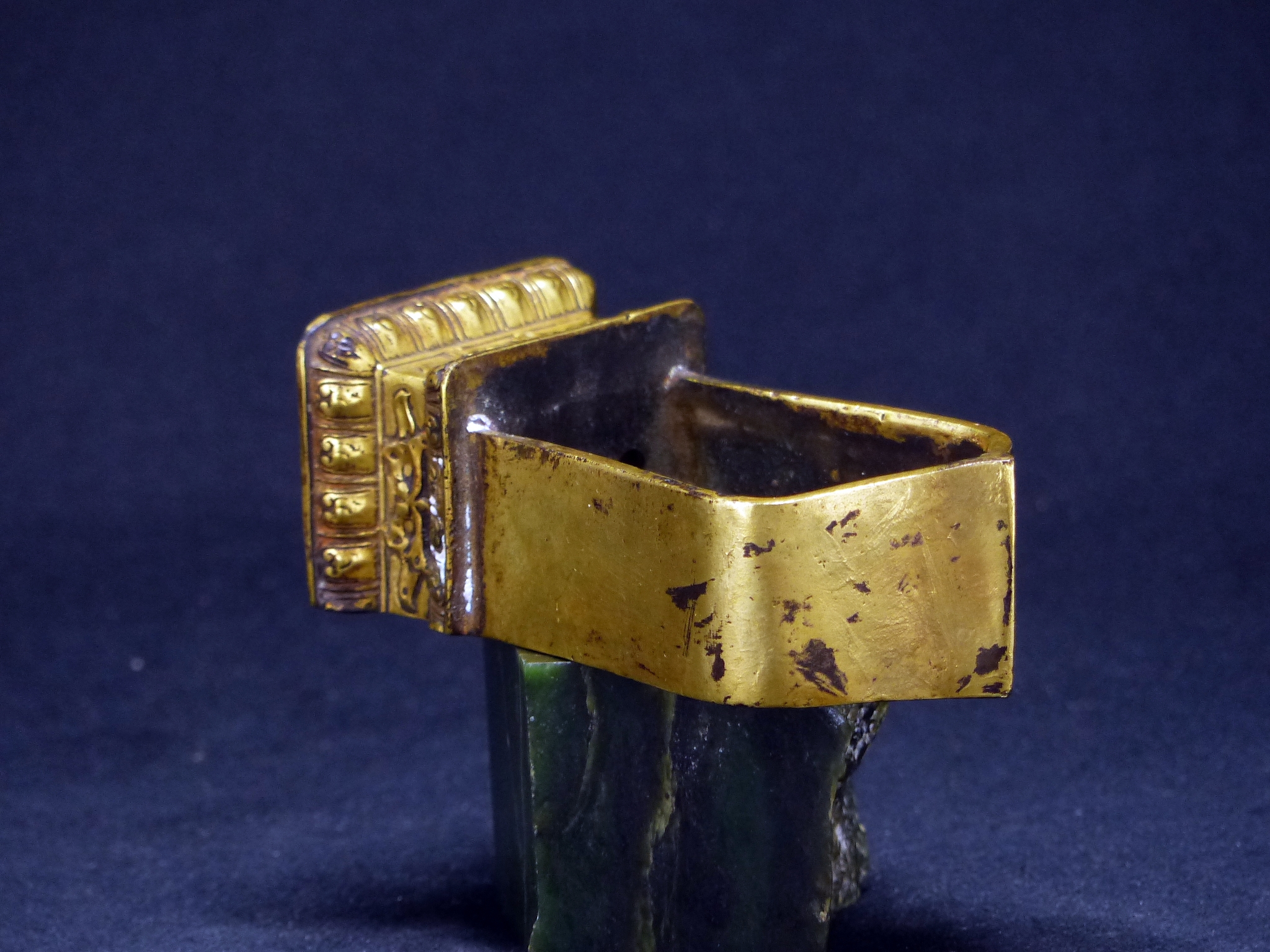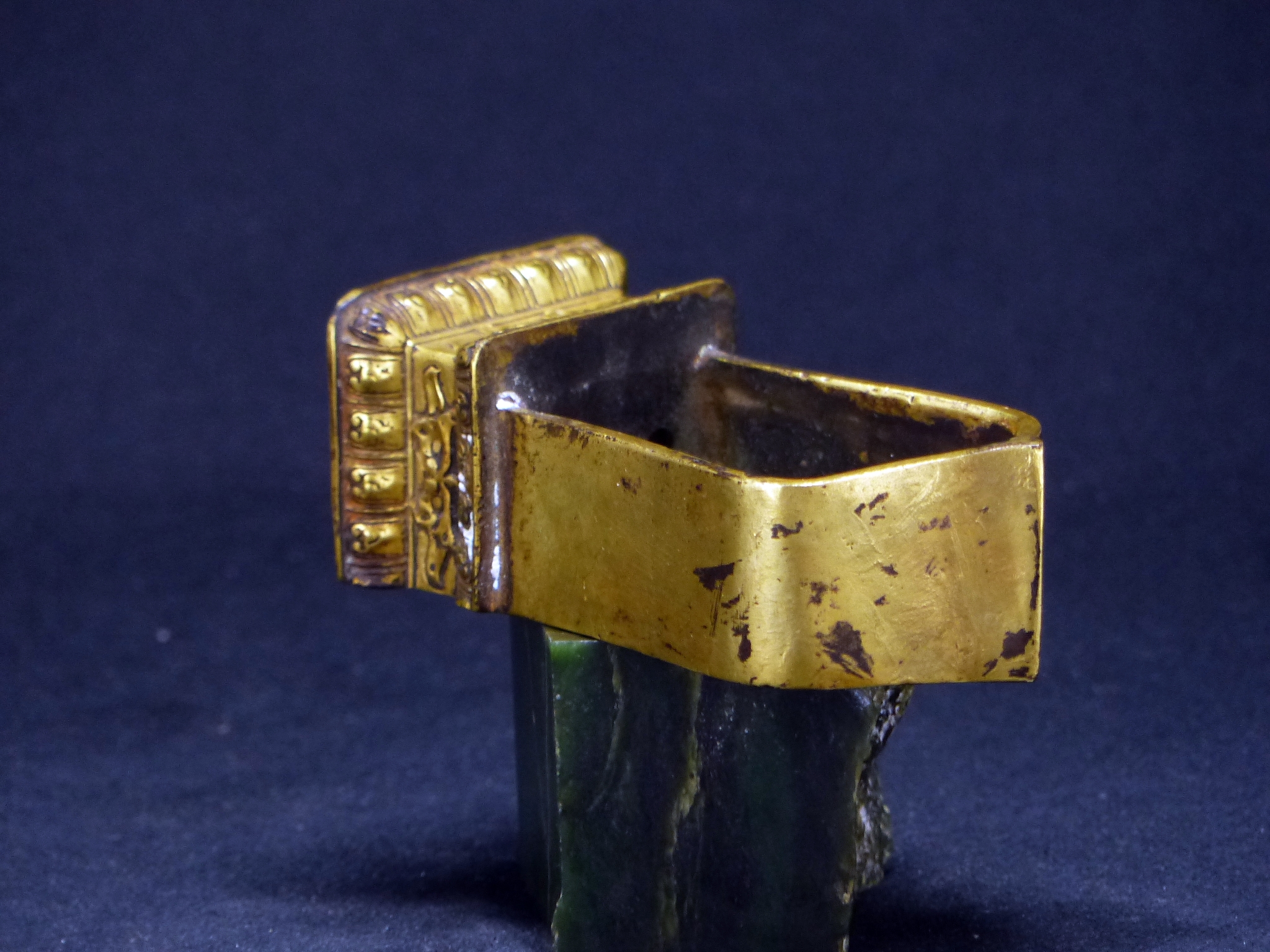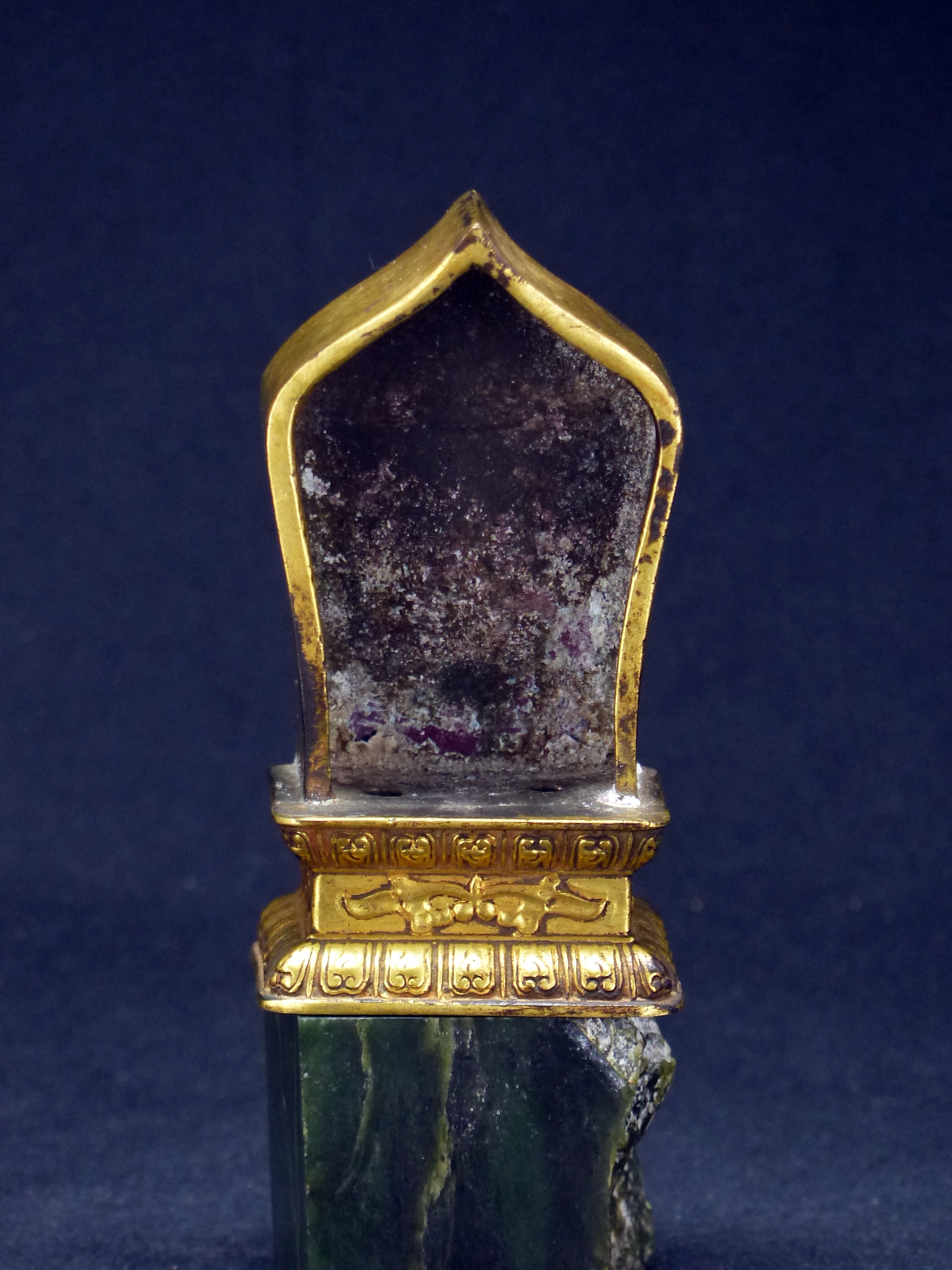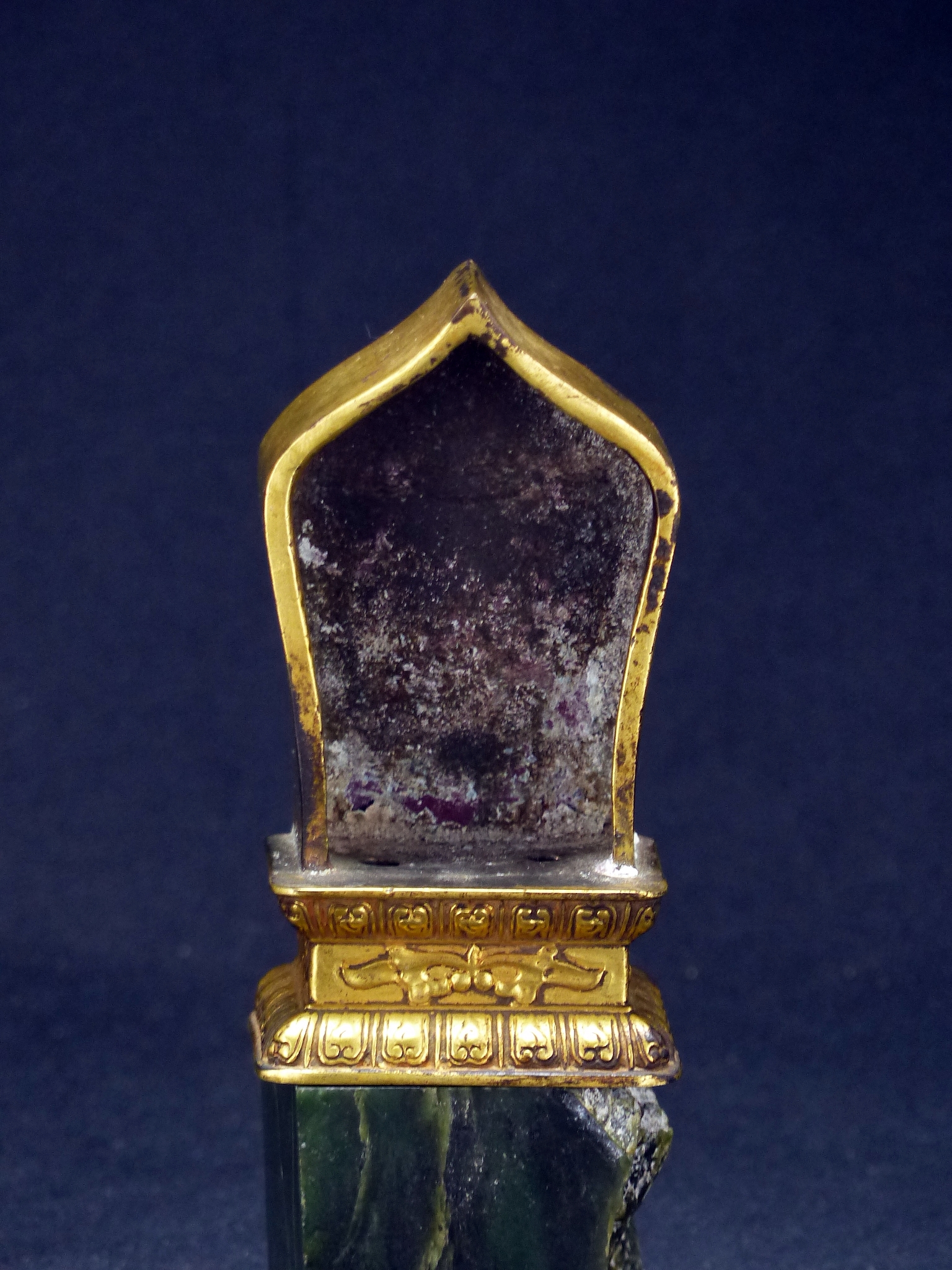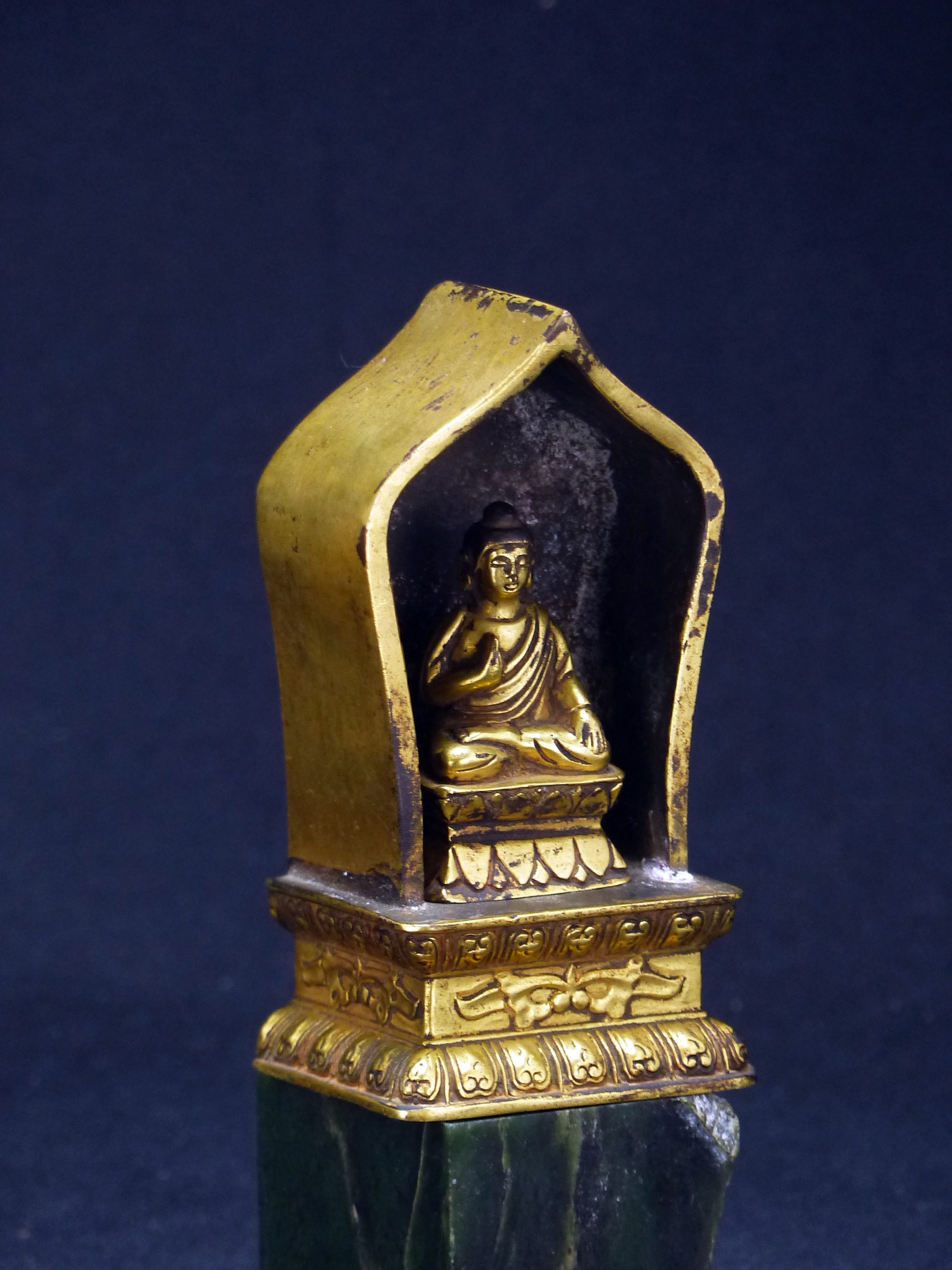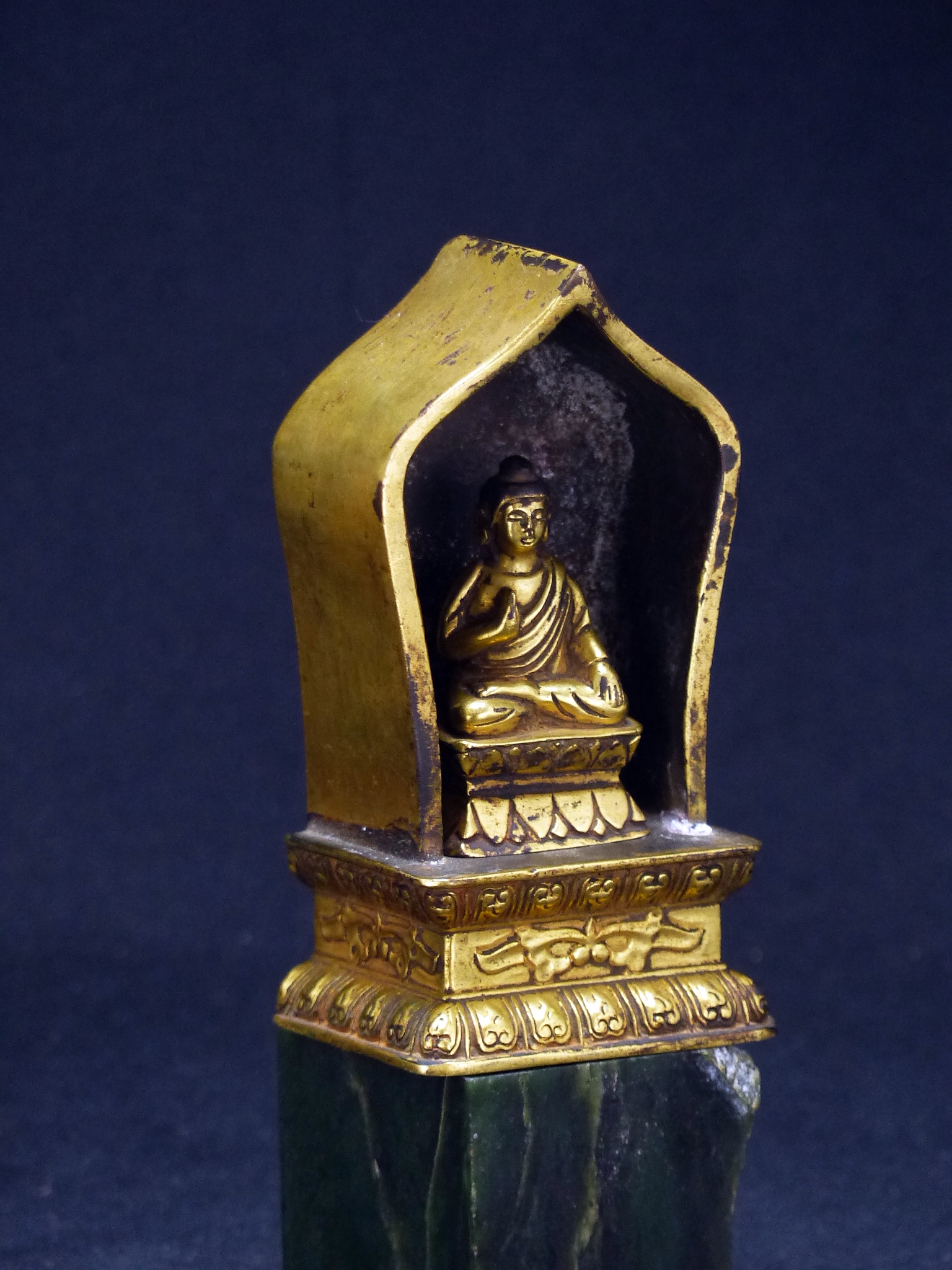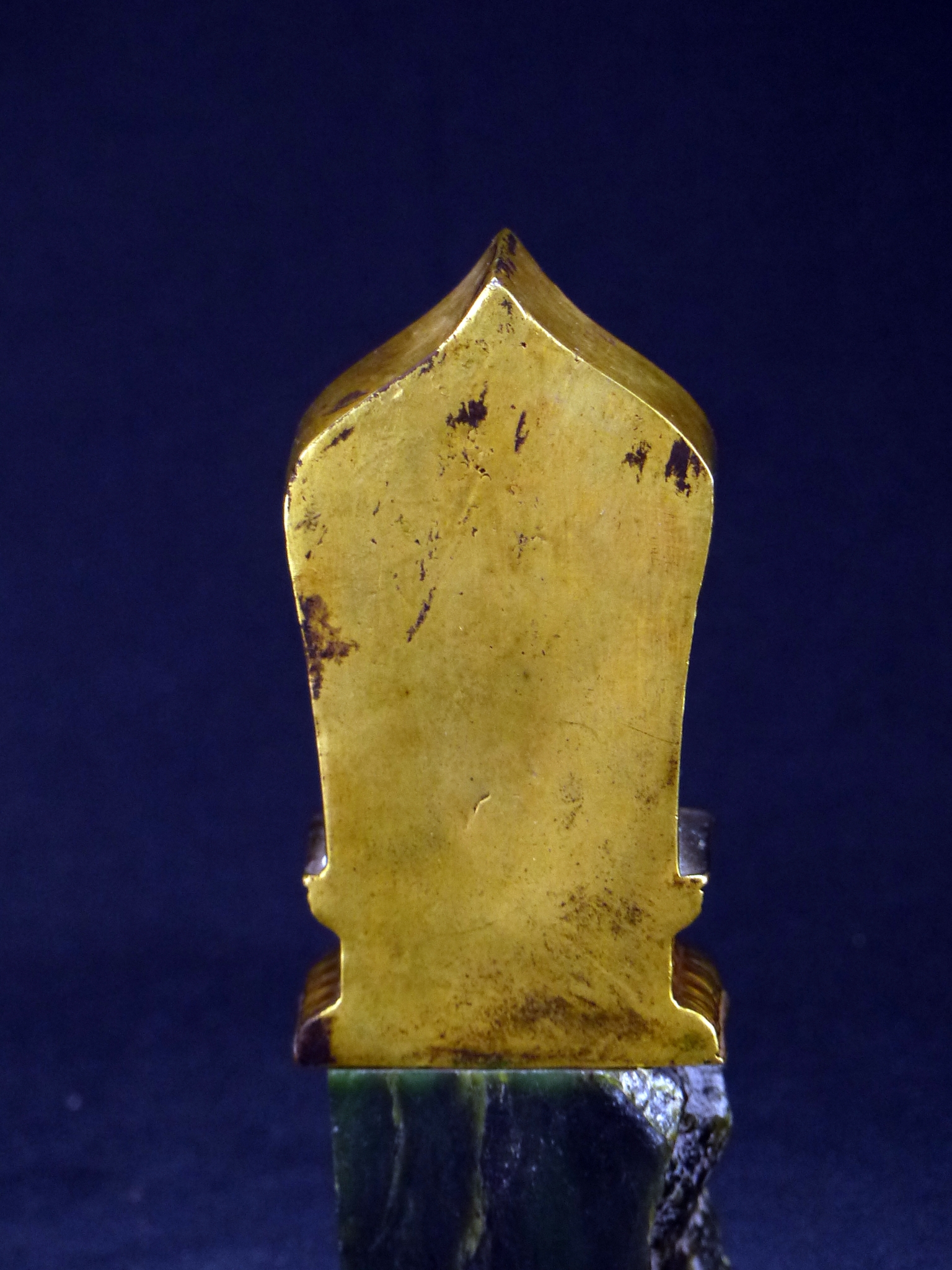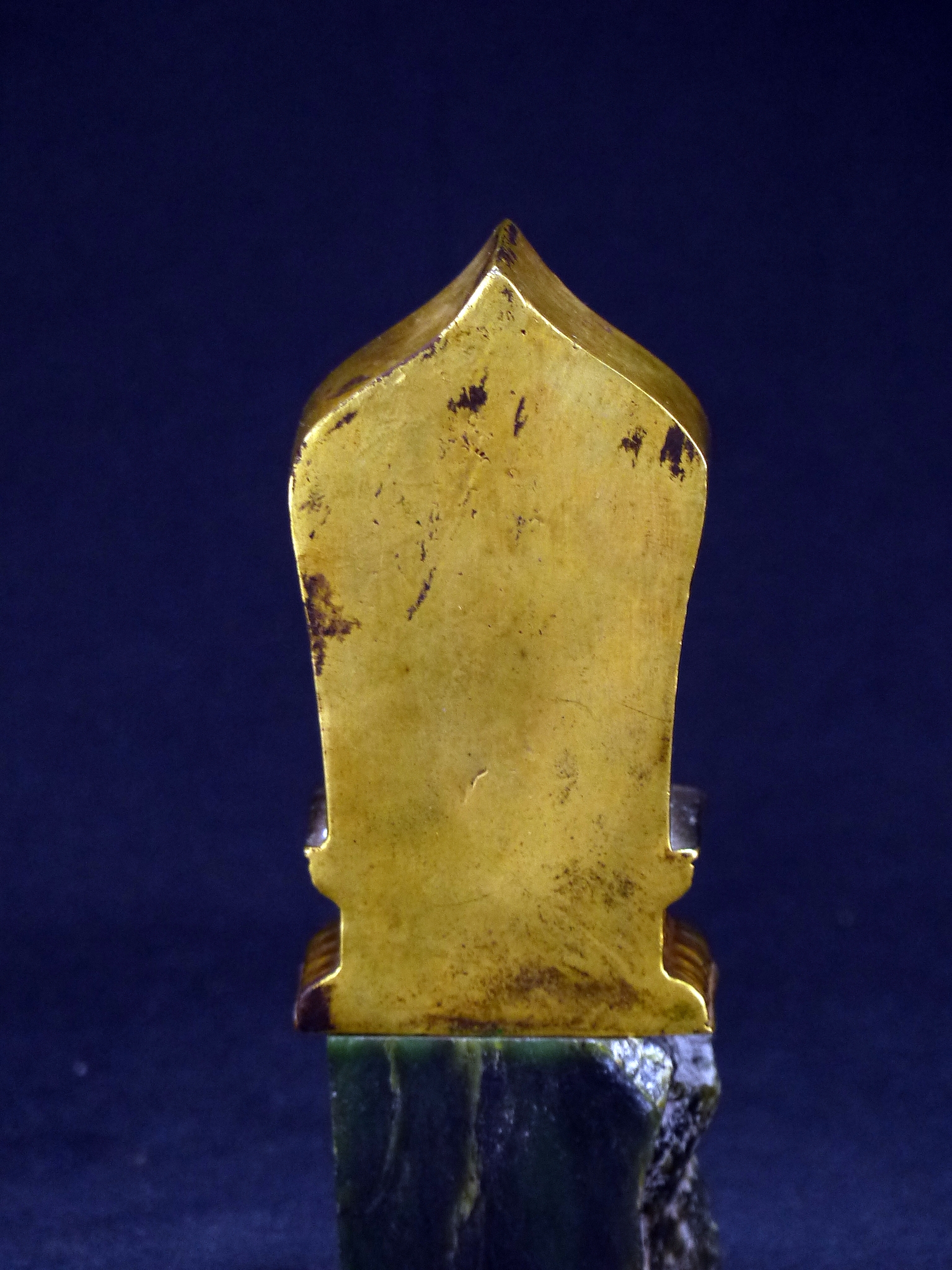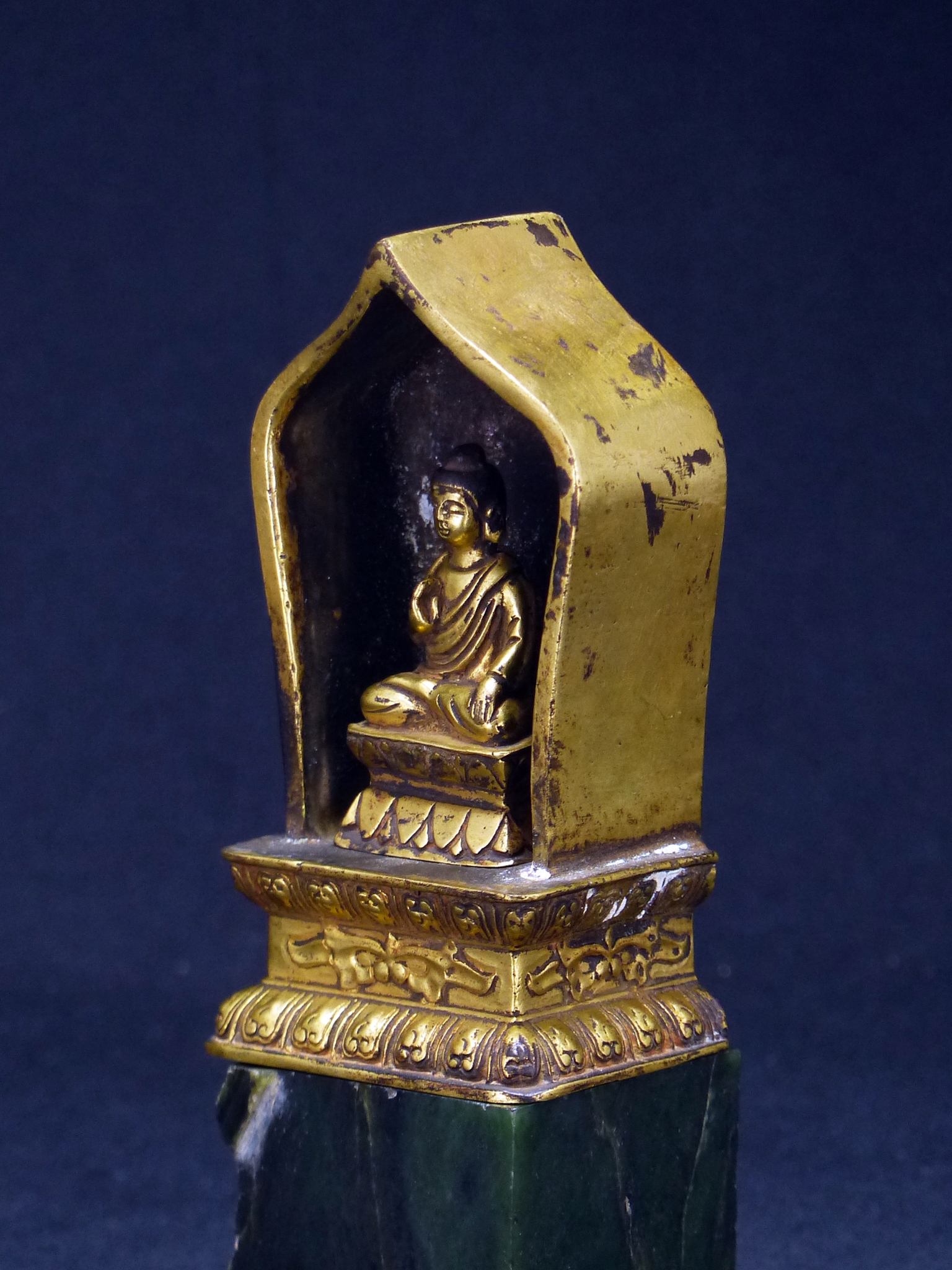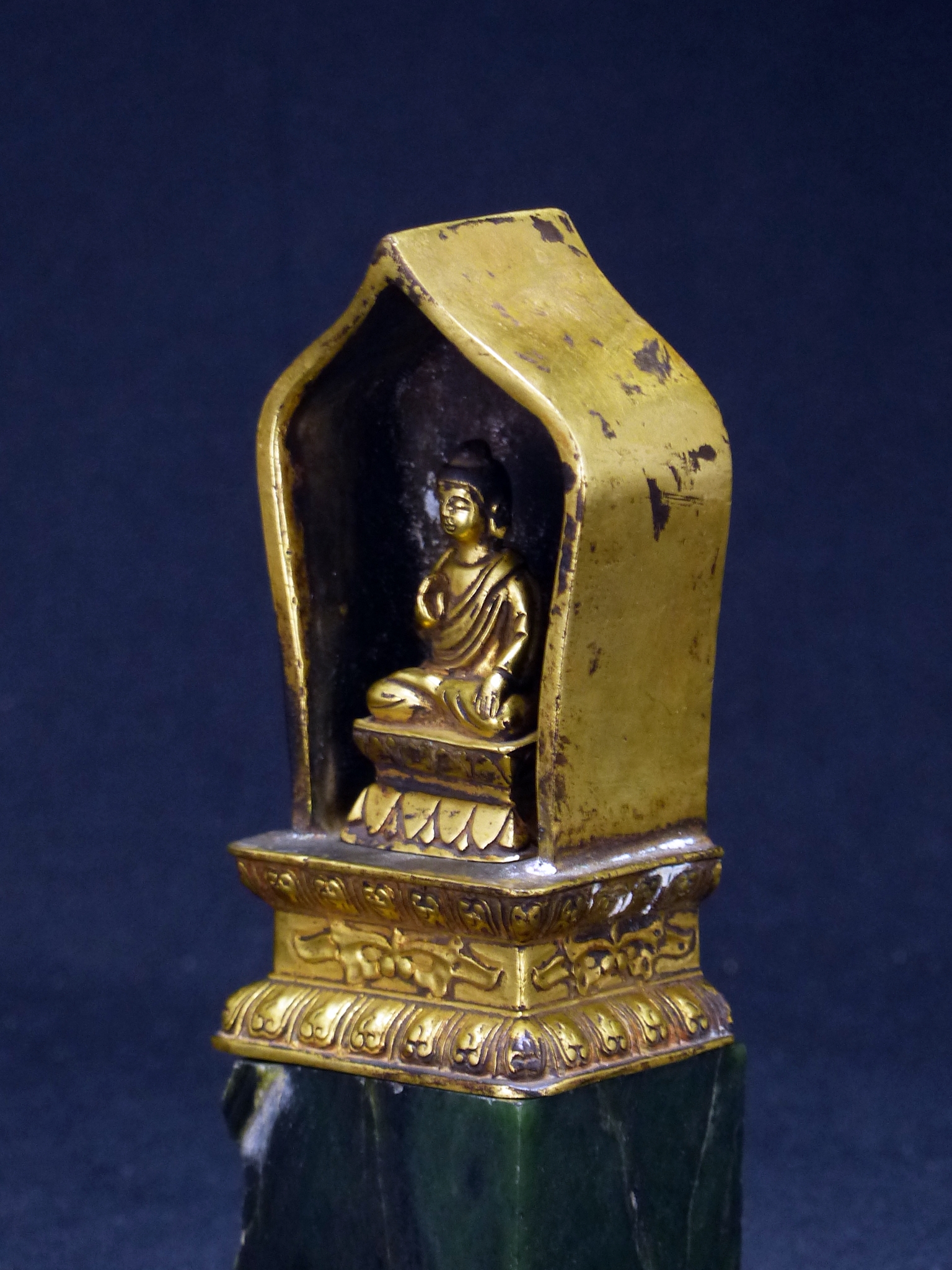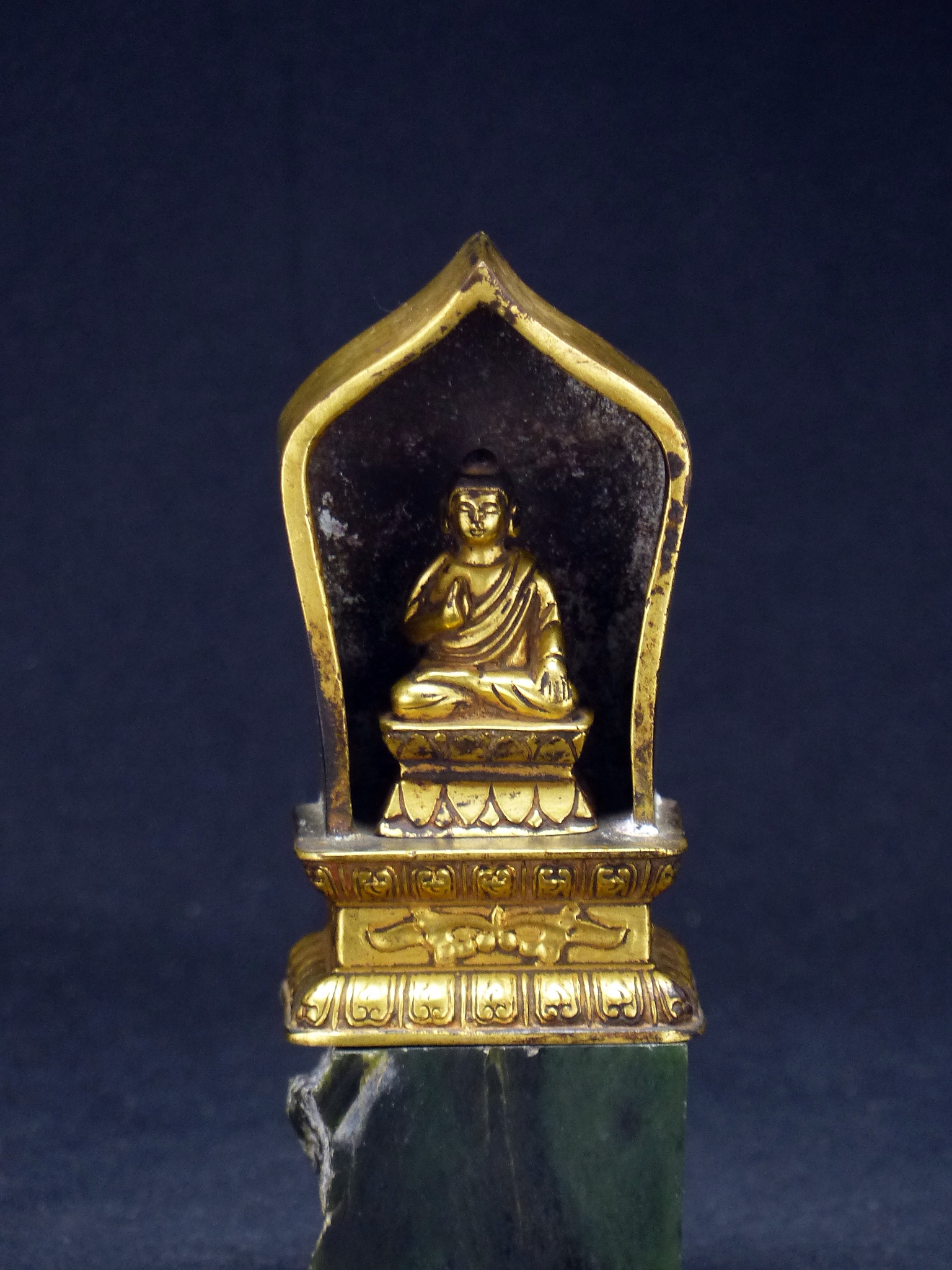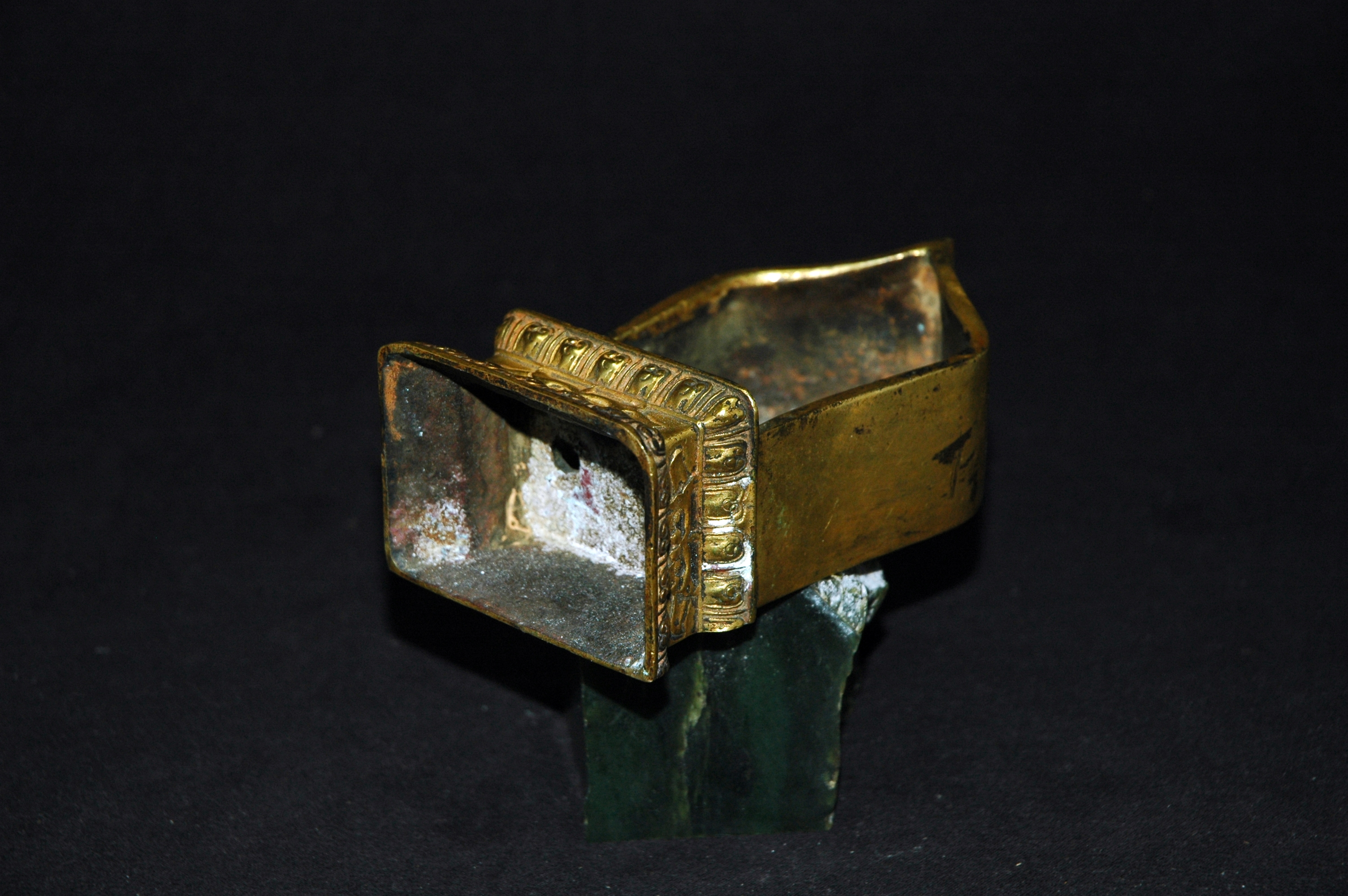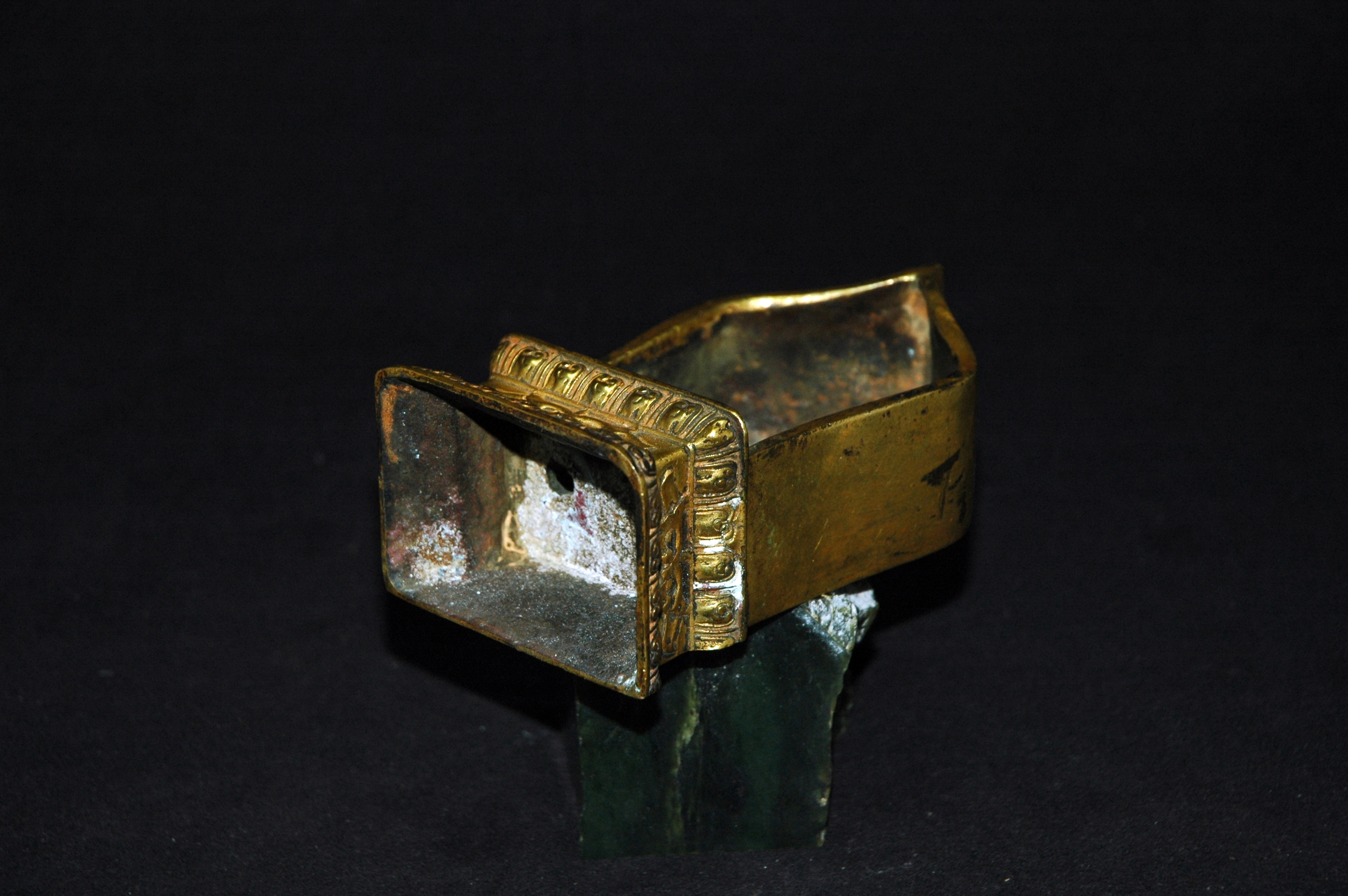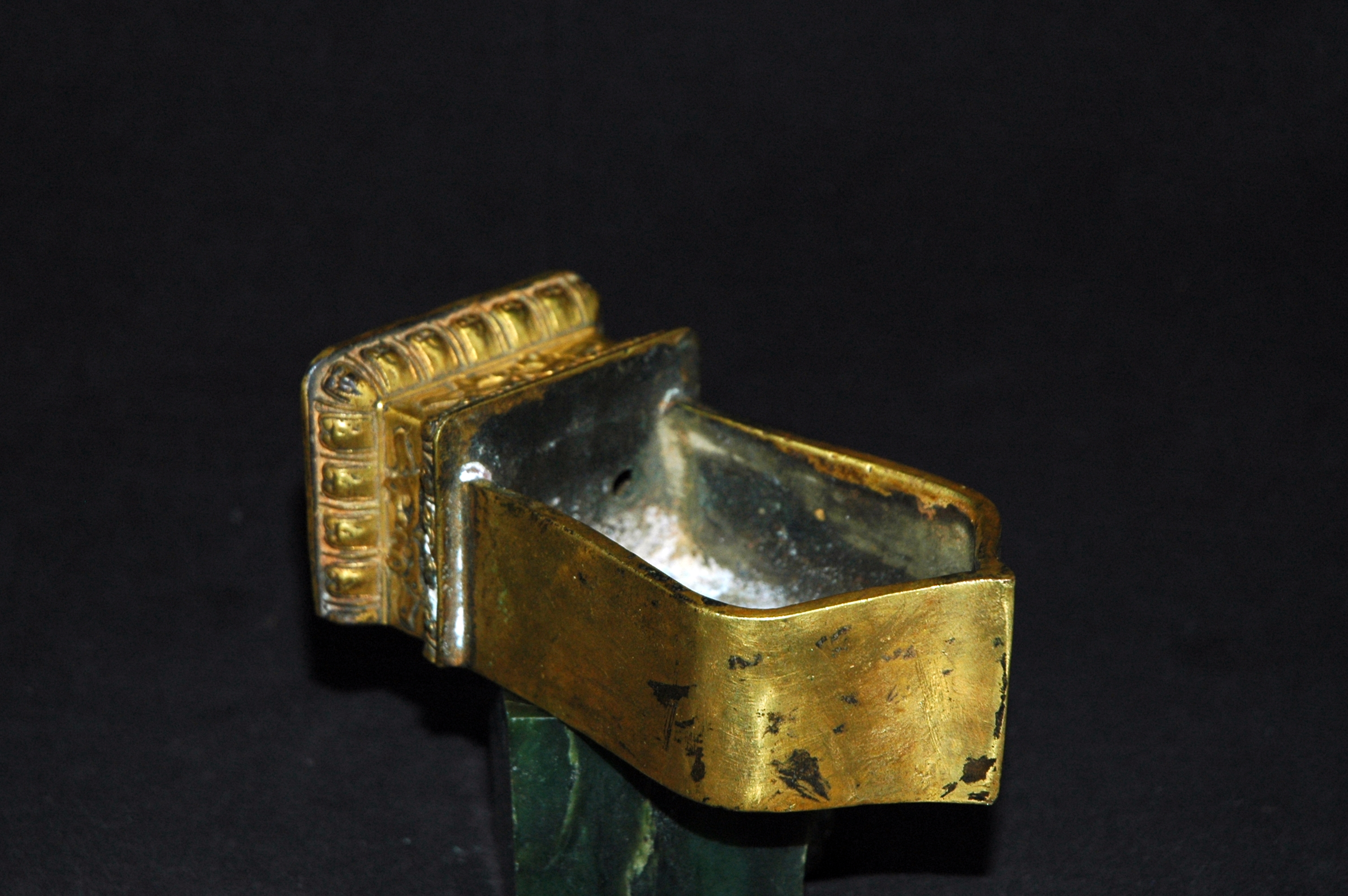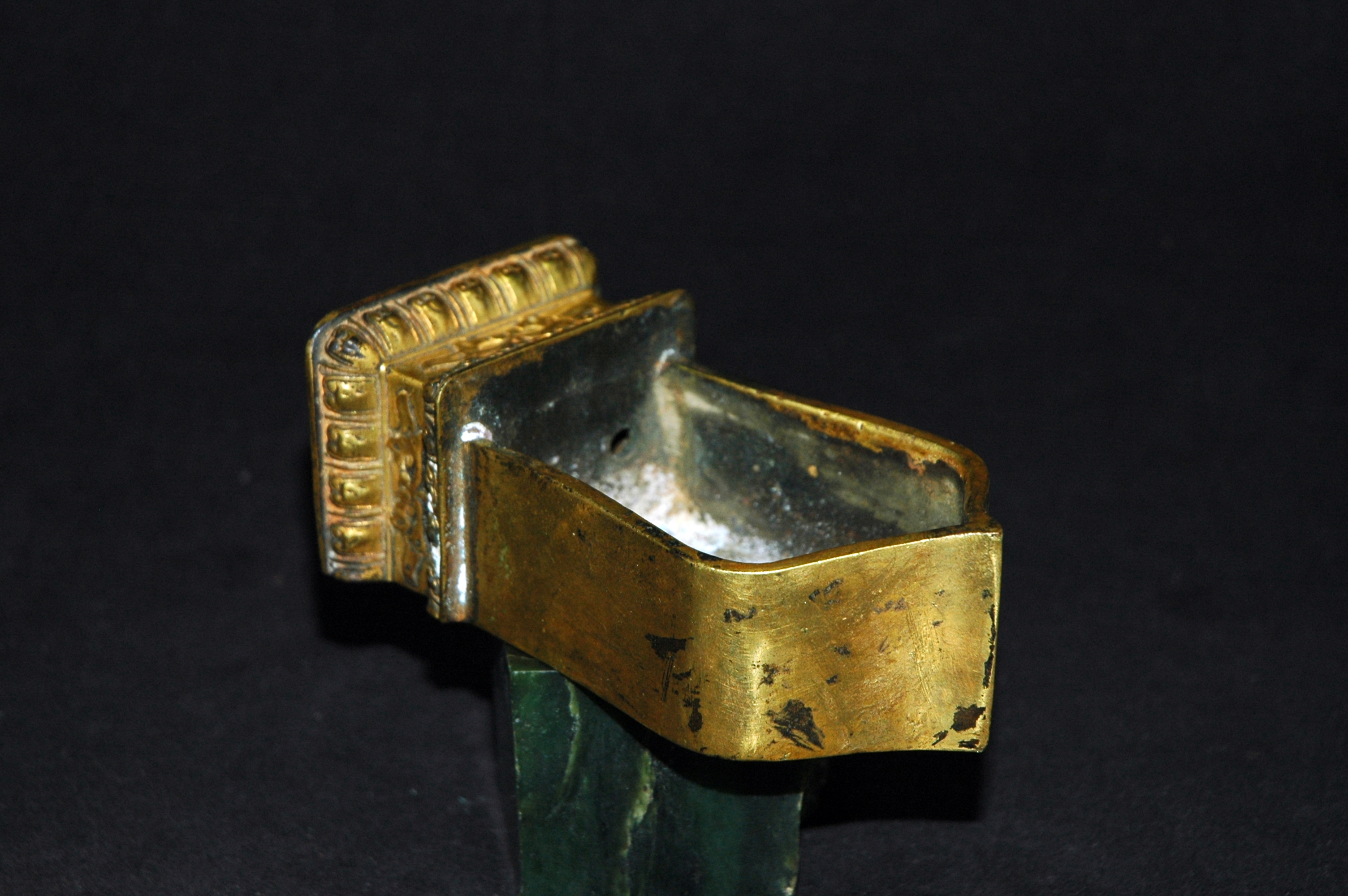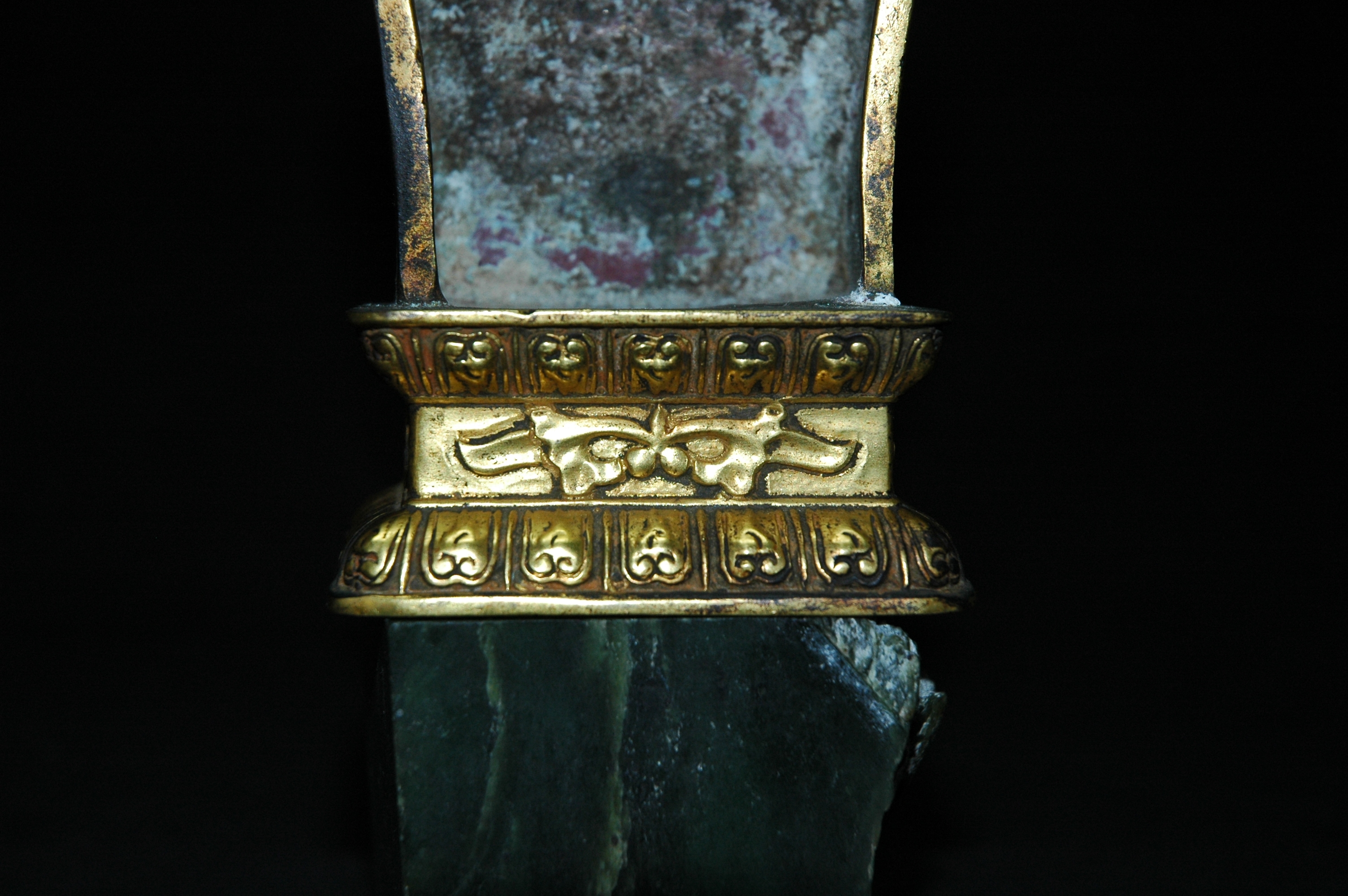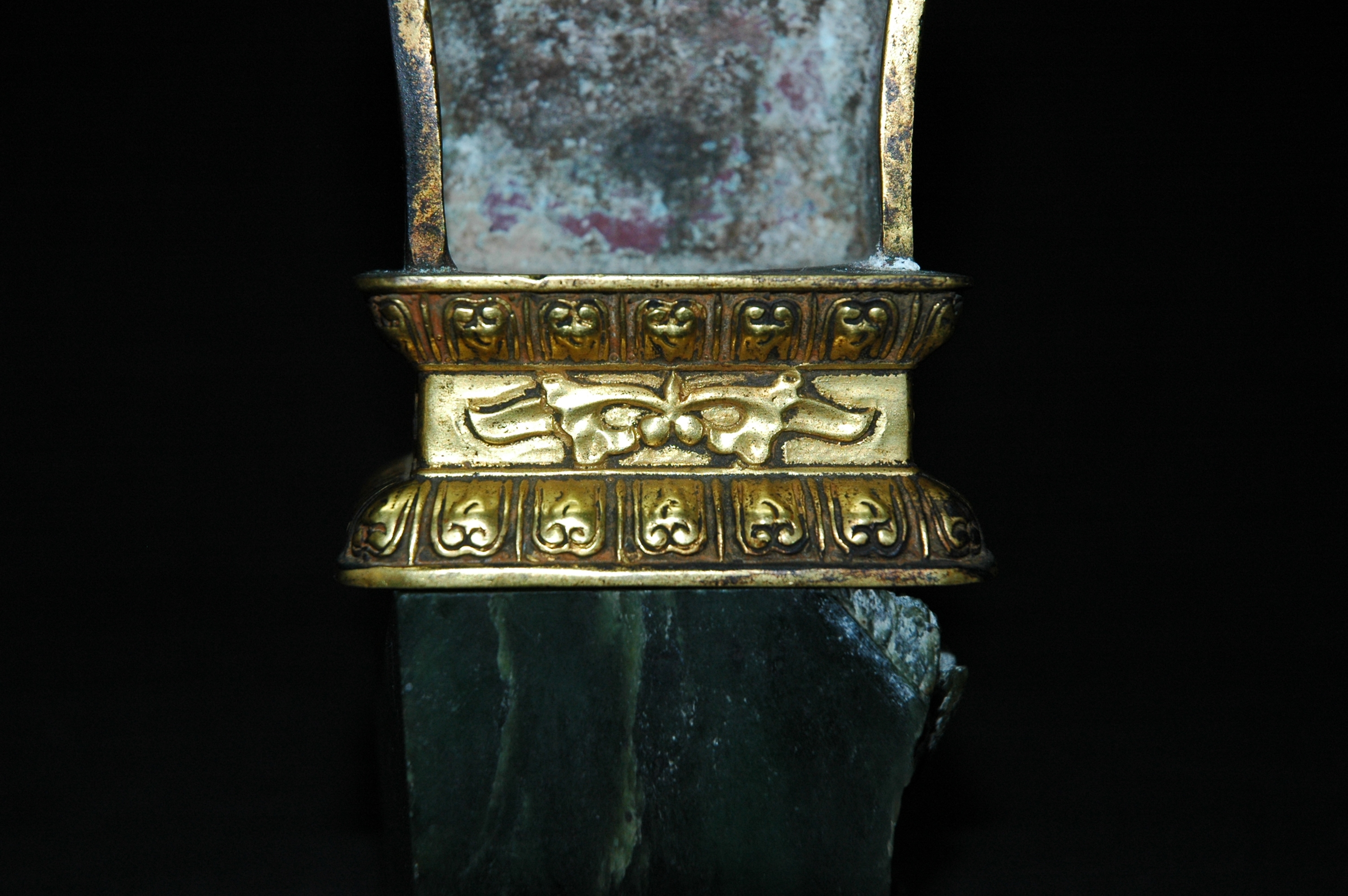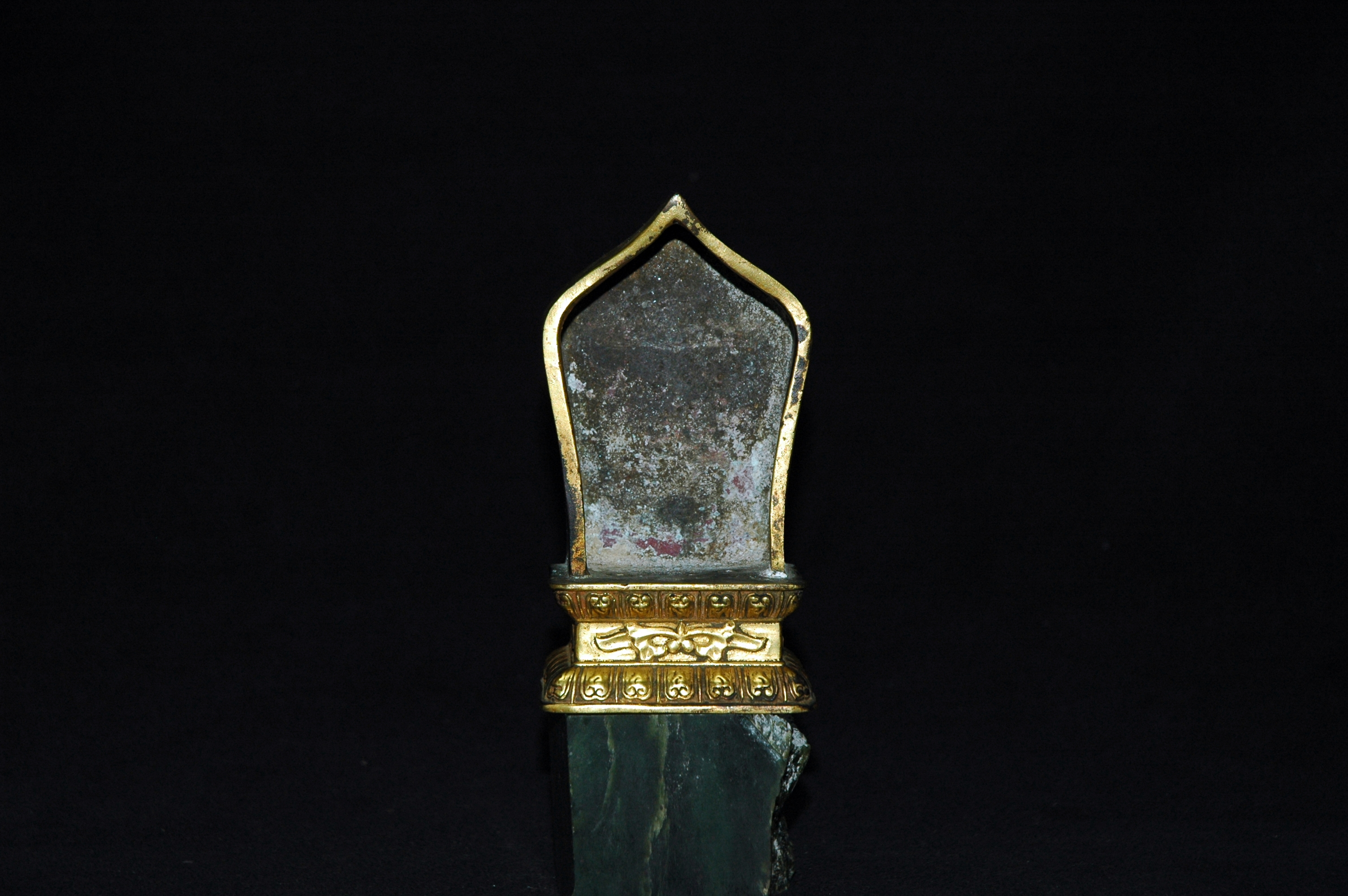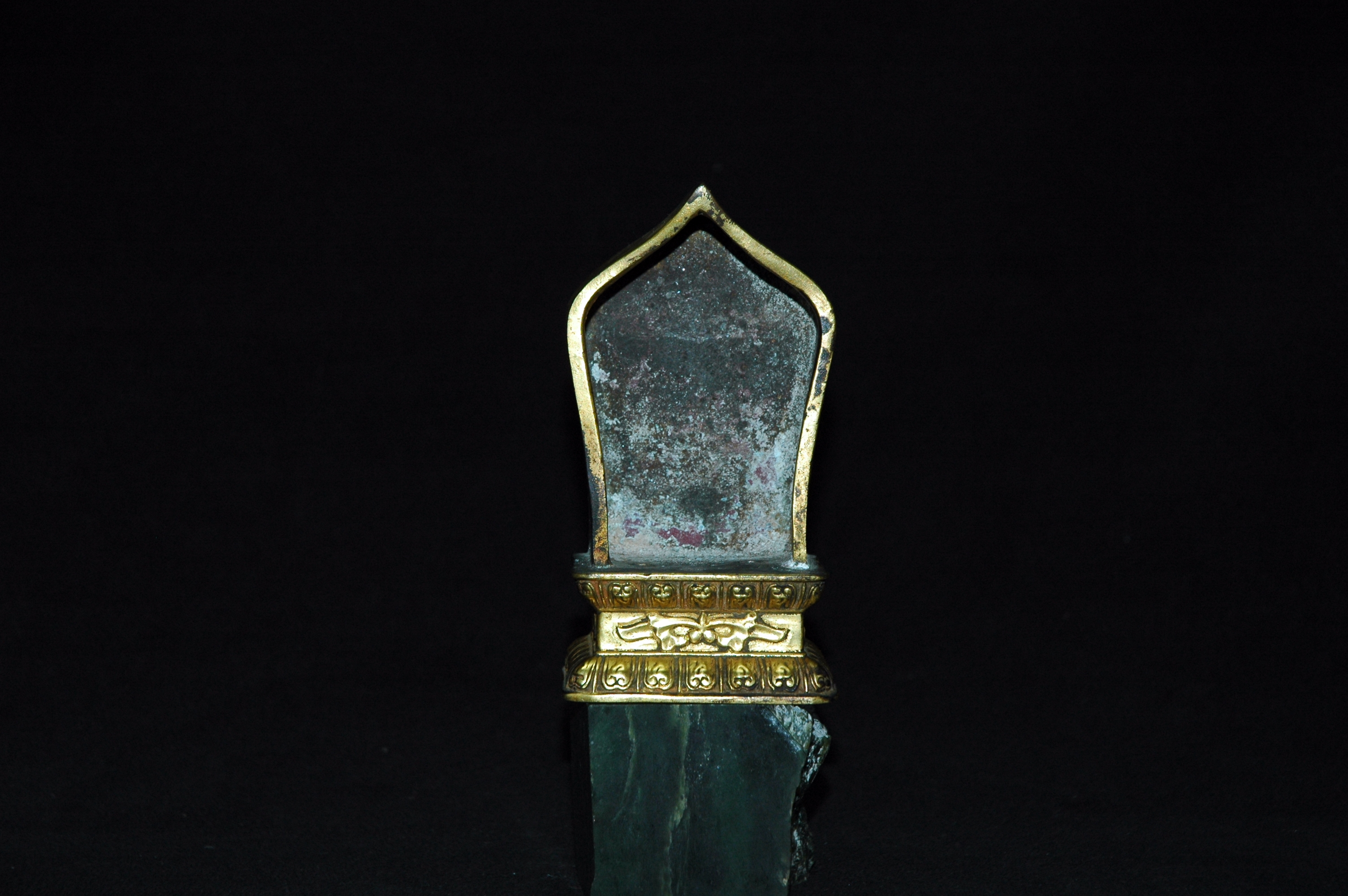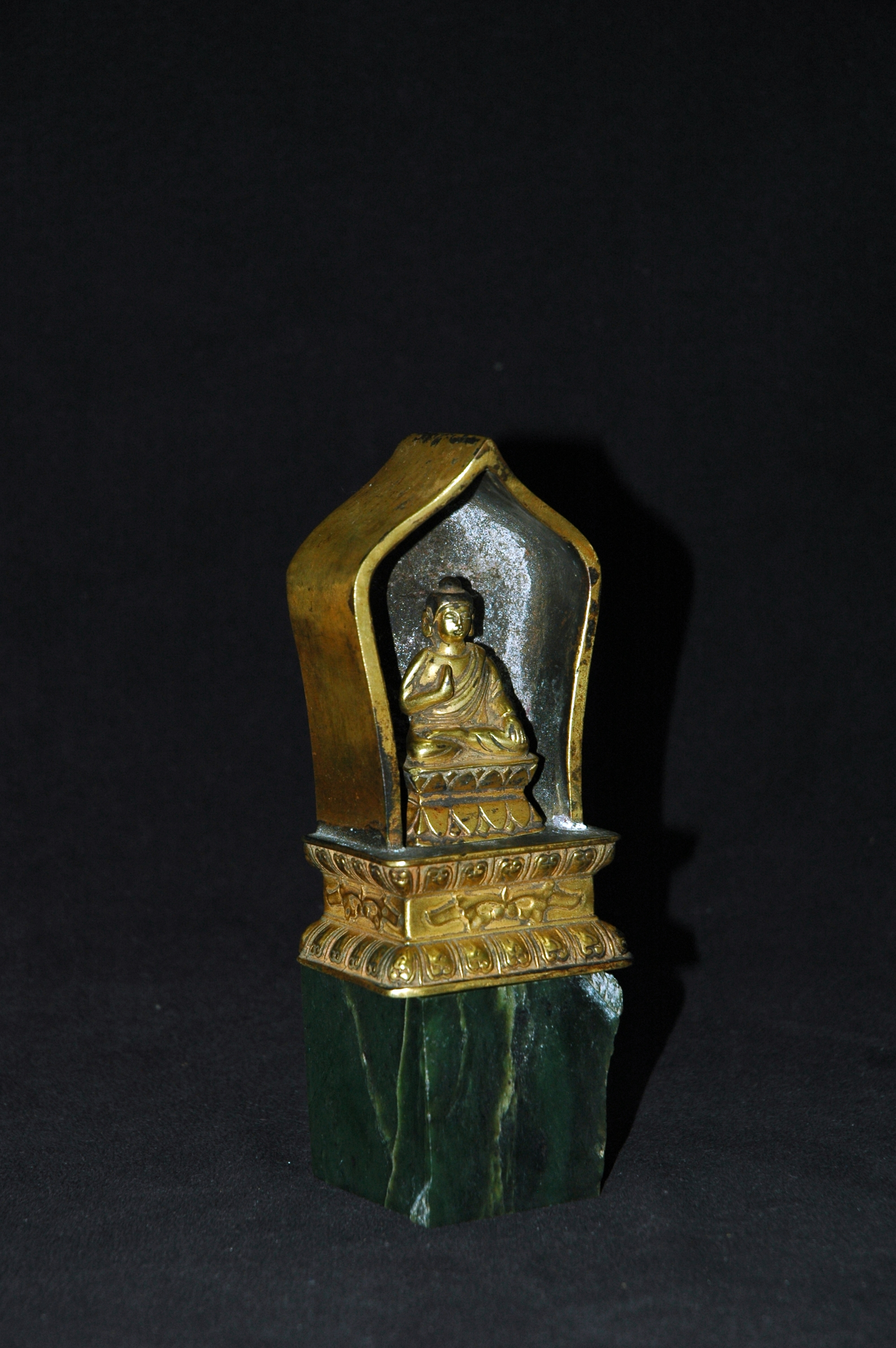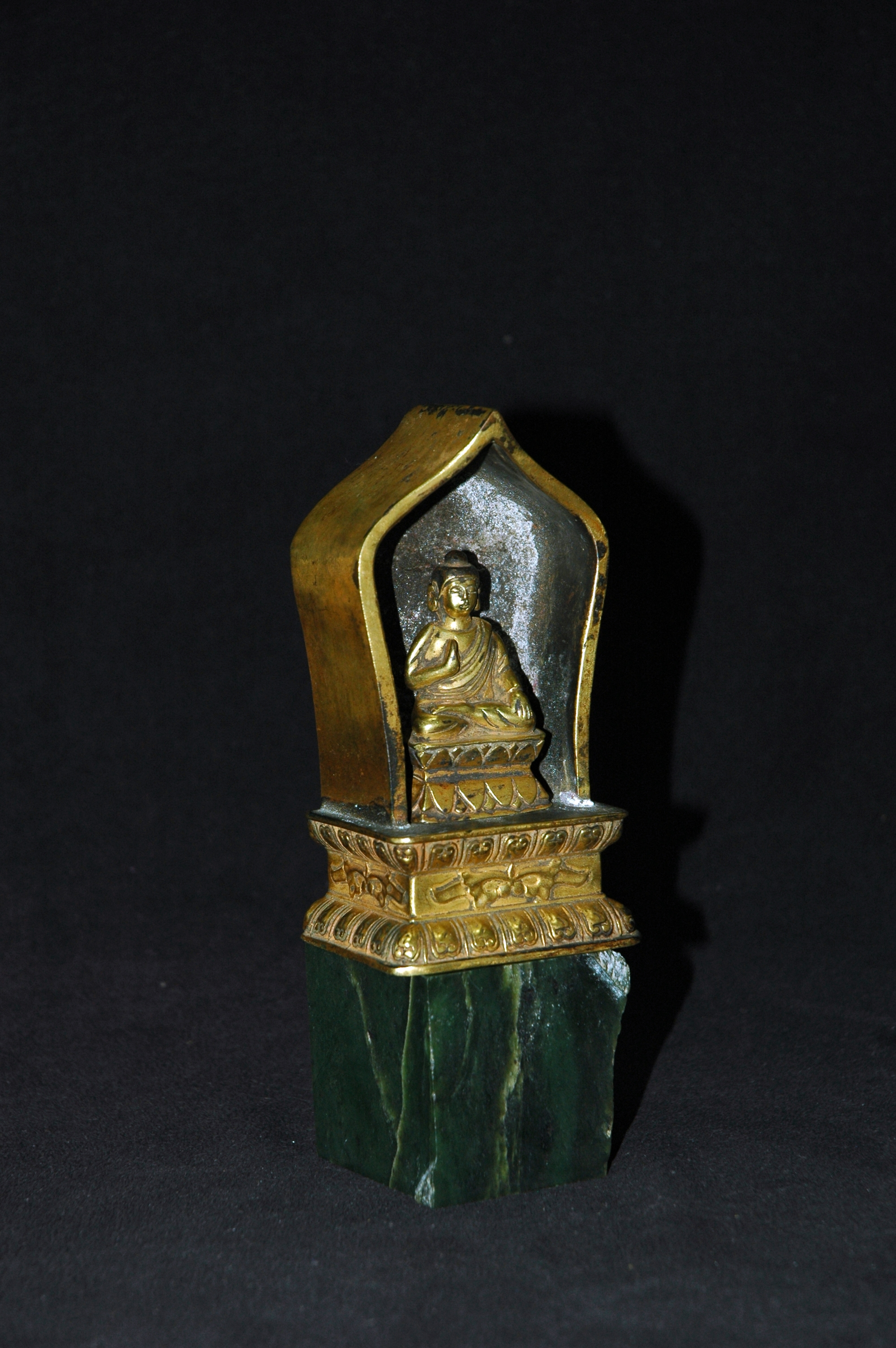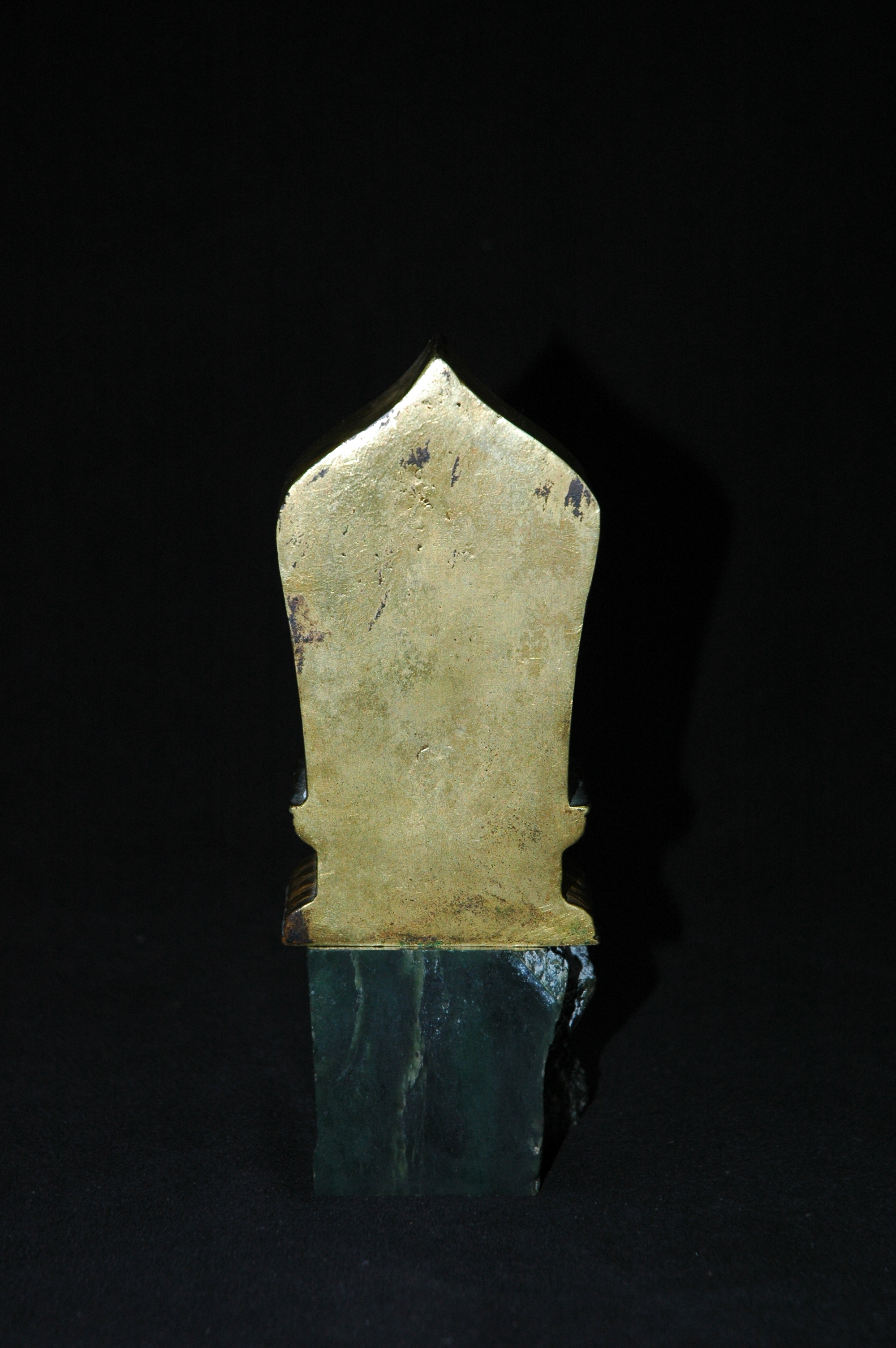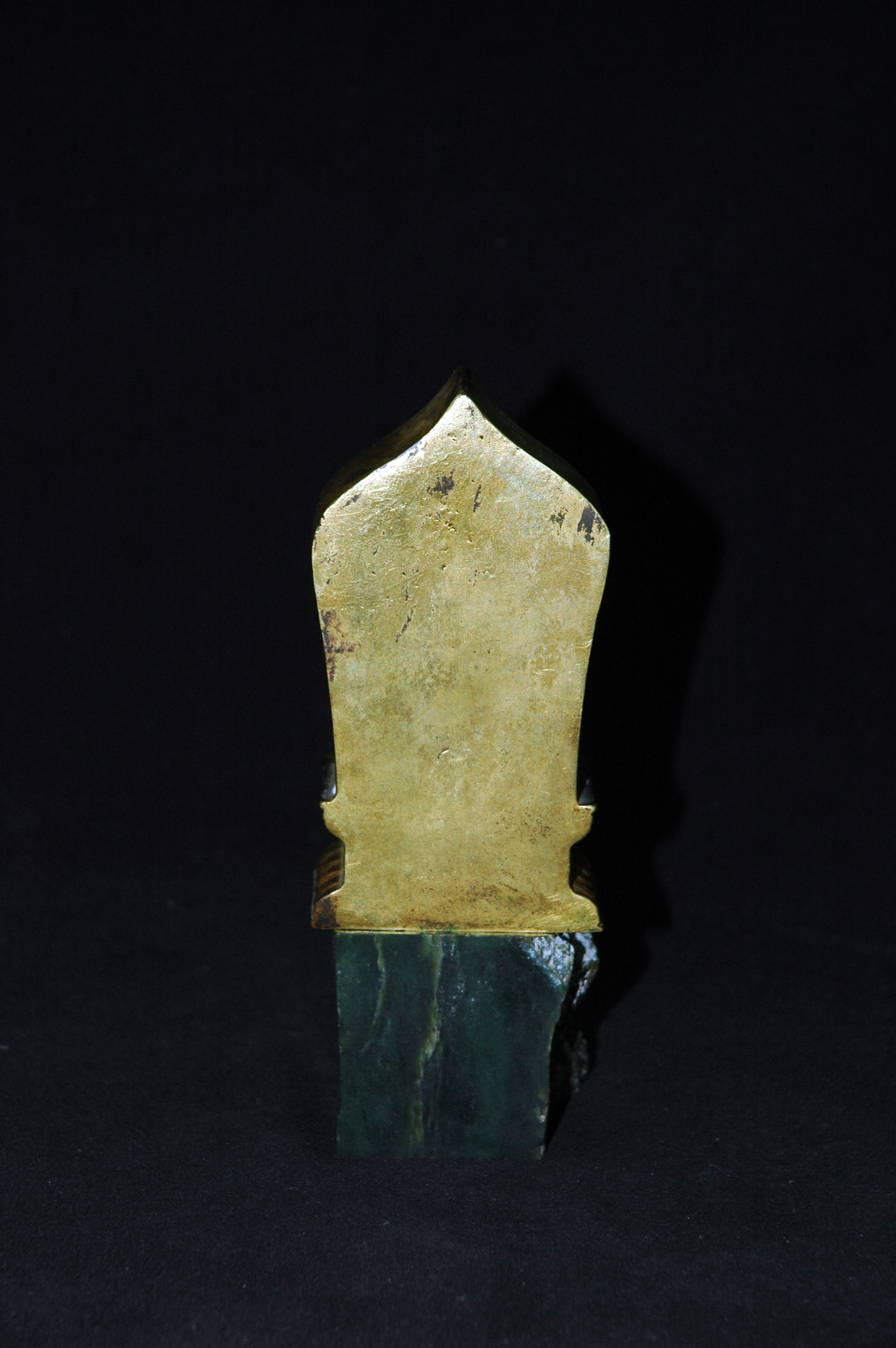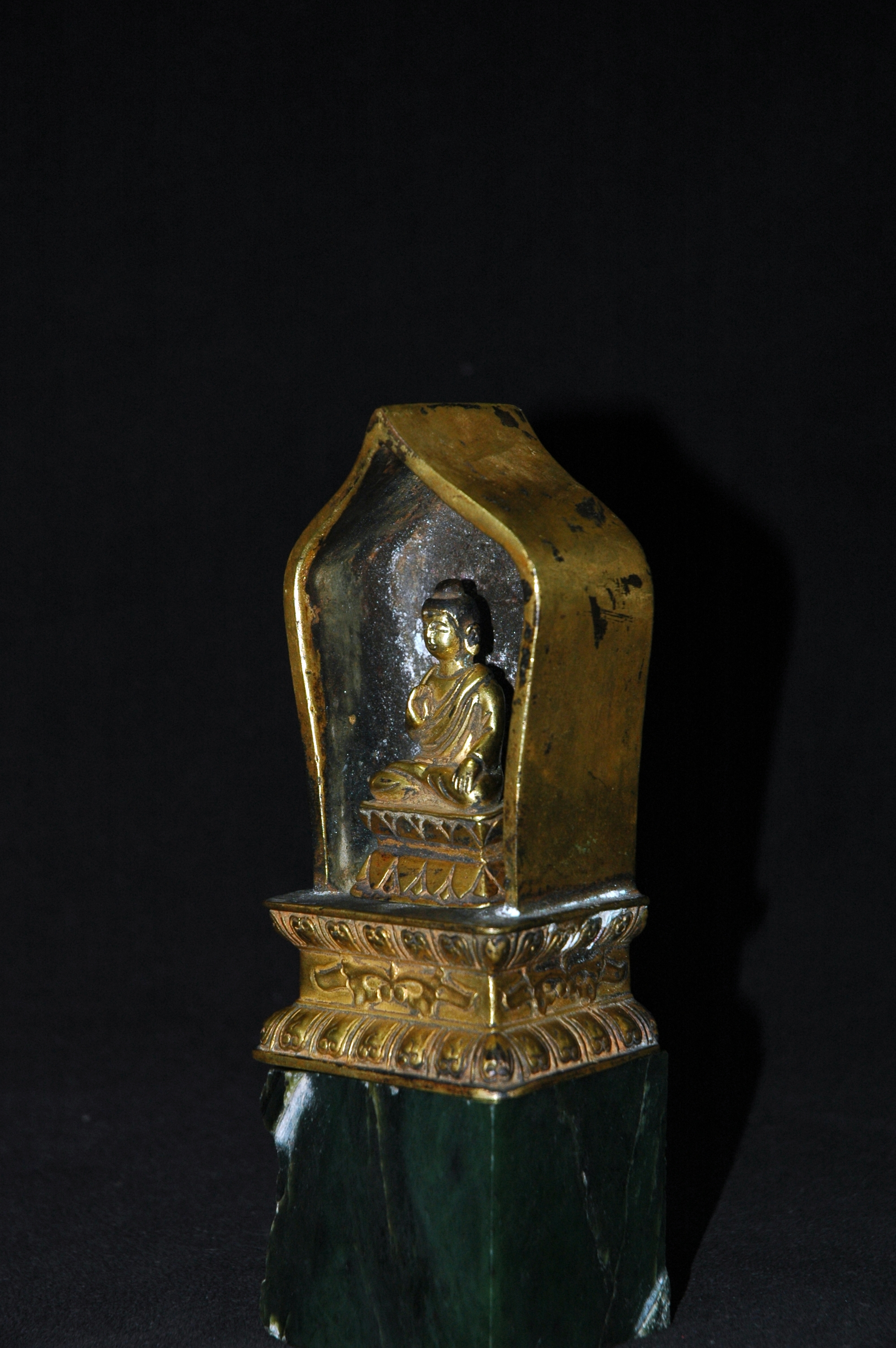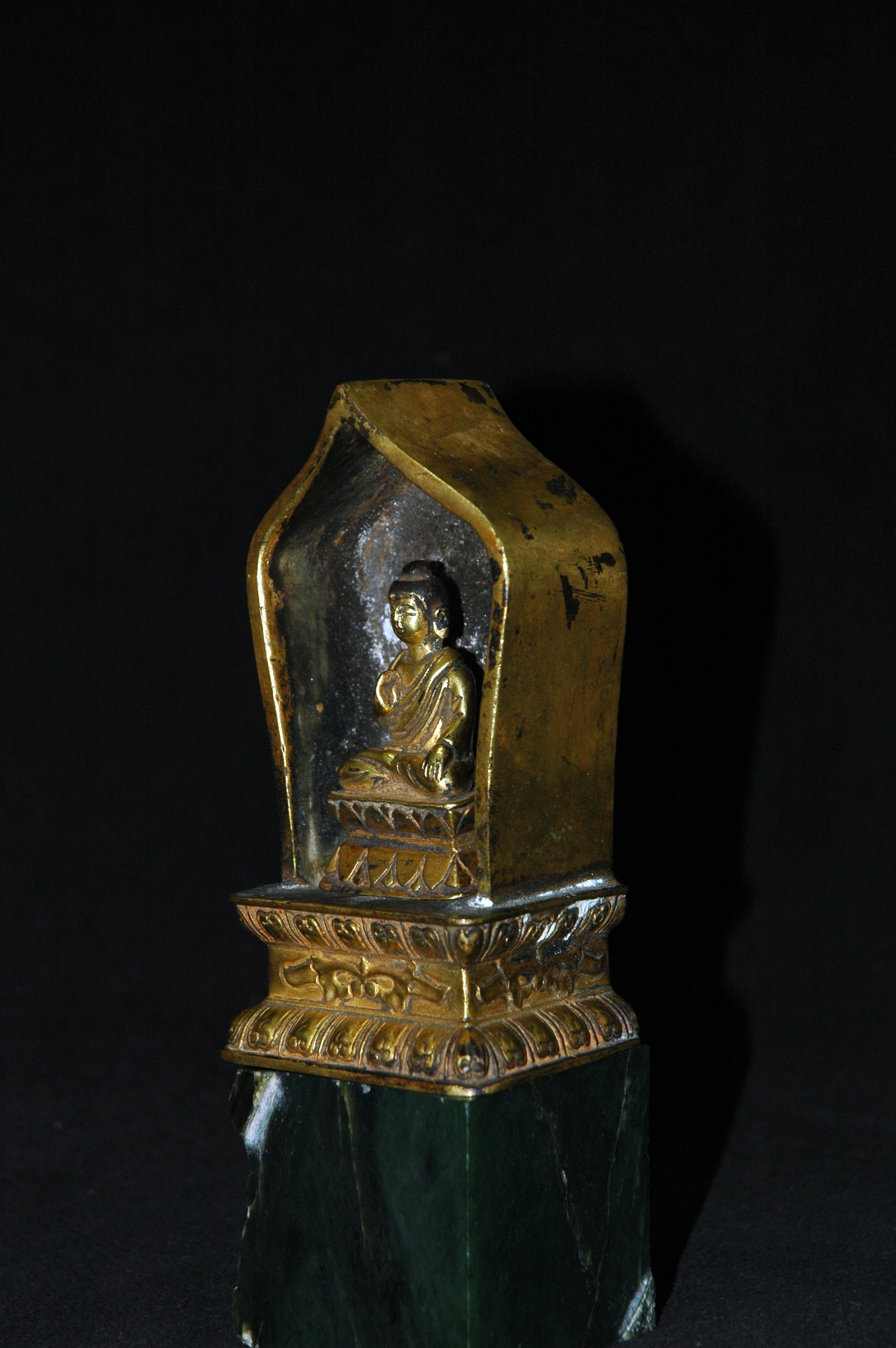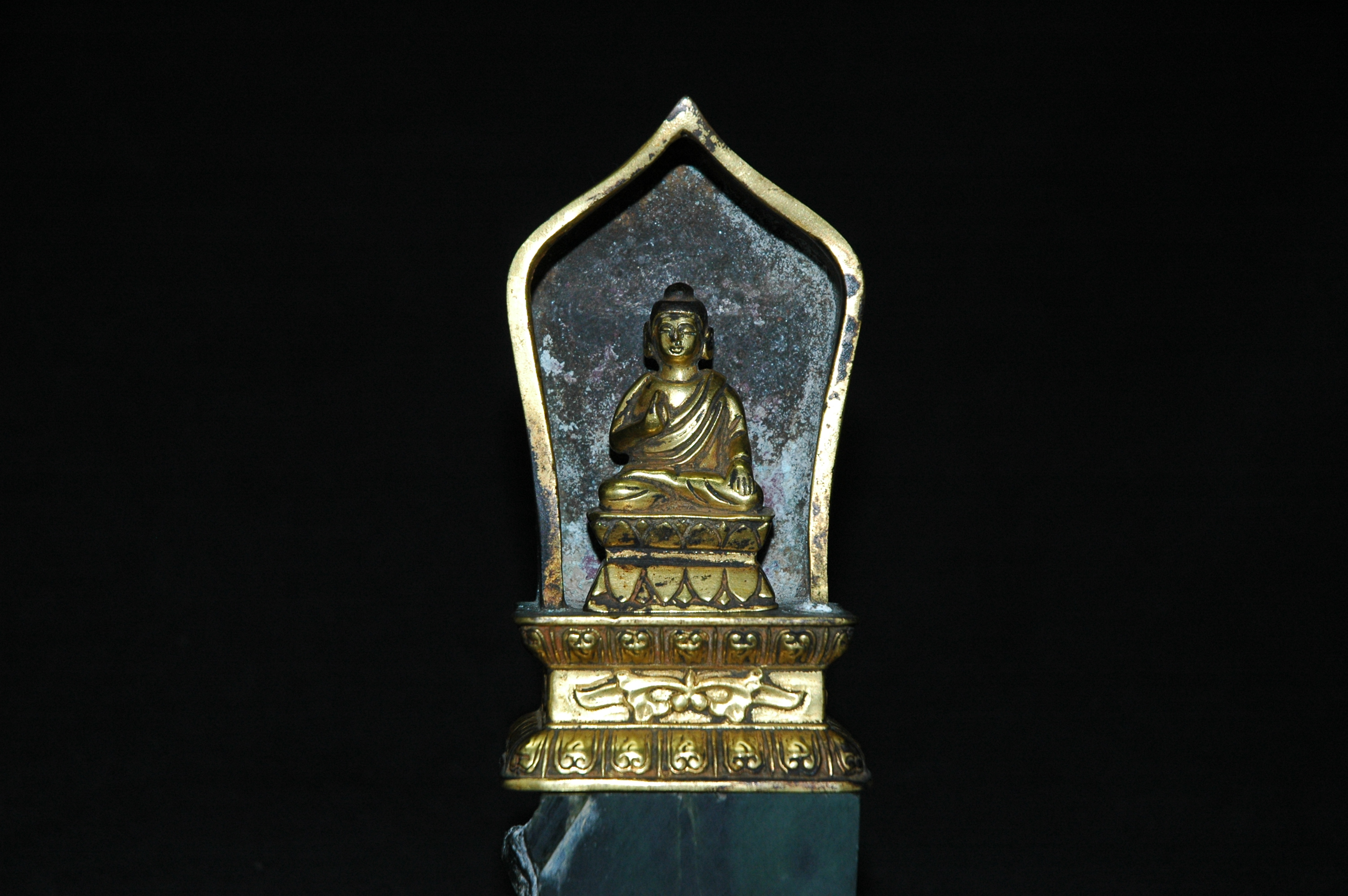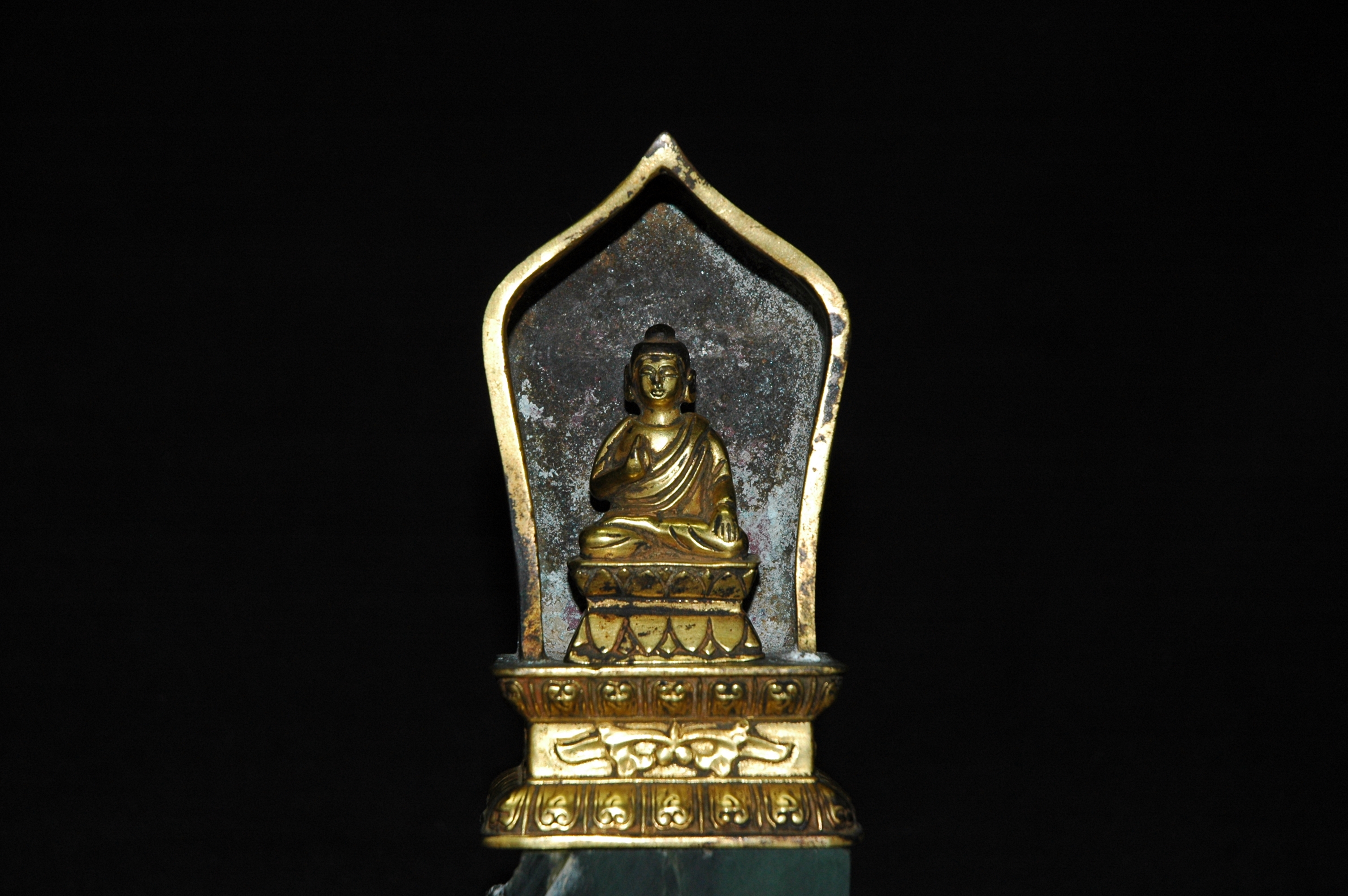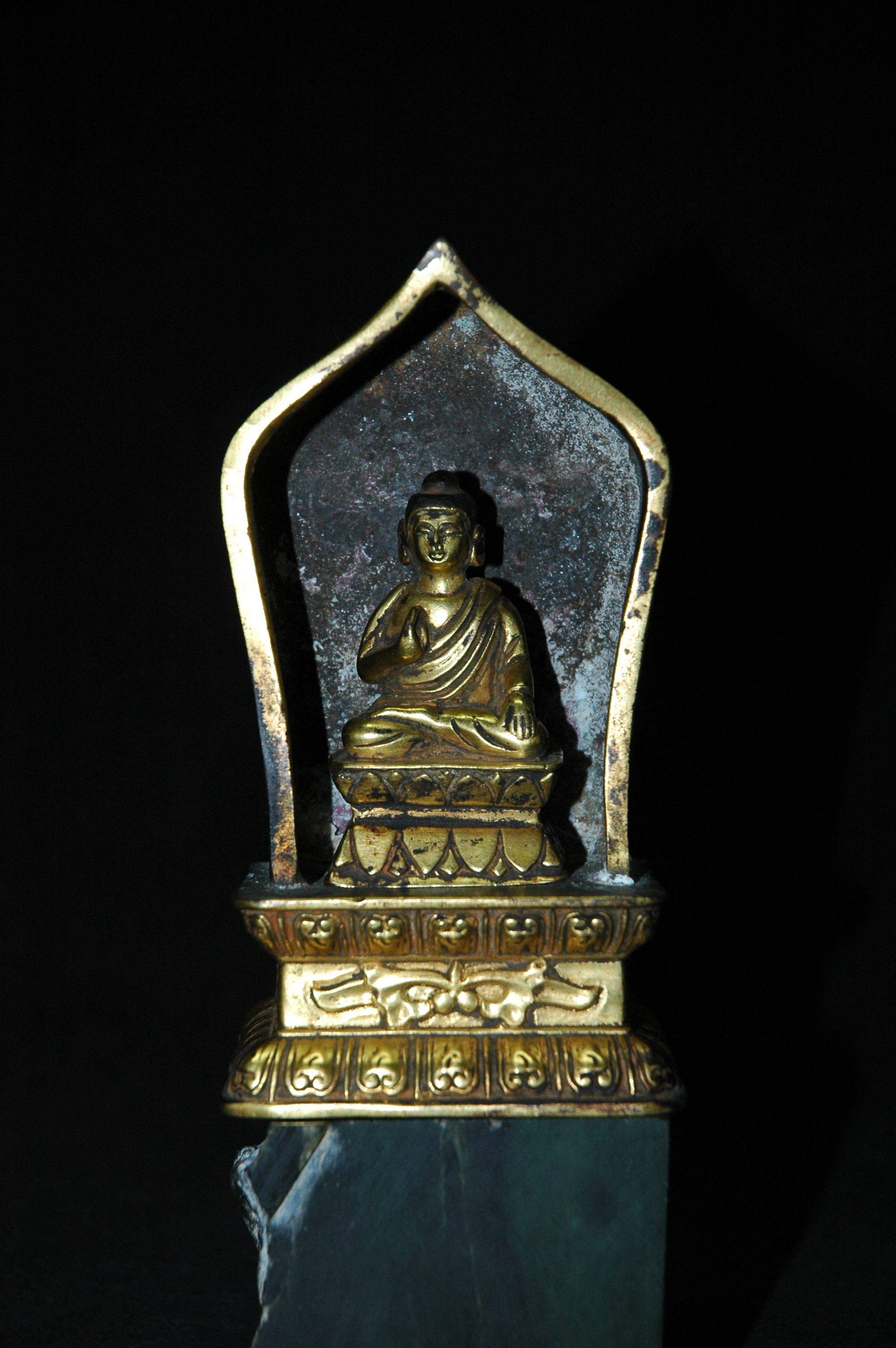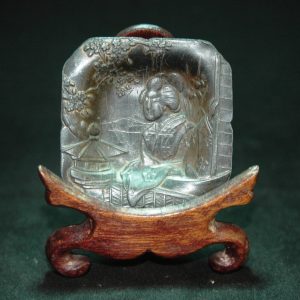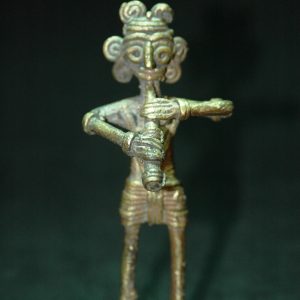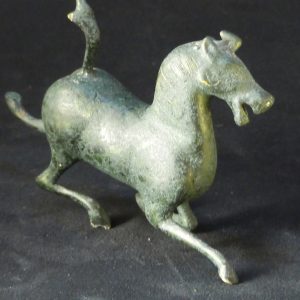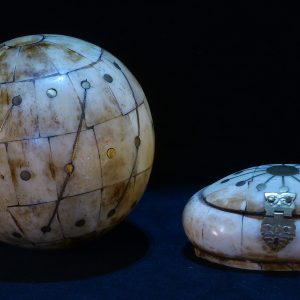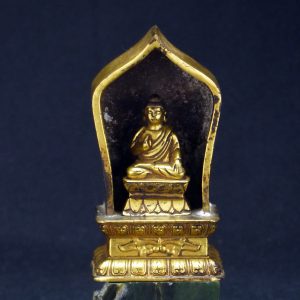Description
铜鎏金释迦牟尼佛祖摆件坐龛像 嘎乌
嘎乌(藏语:ga’u)為西藏人安放佛像等神聖物的小型佛龛。
嘎乌又称佛盒,为小型佛龛,通常制成小盒型,用以佩戴于颈上,龛中供设佛像。 密宗行人于出门时佩戴,一者祈求本尊加持,二者于修法时可取出供奉,为随身之密坛。
参考:佳士得
現場拍賣 21657
2023年11月30日
重要中國瓷器及工藝精品
拍品 2889 唐 鎏金銅佛坐像
A RARE SMALL GILT-BRONZE FIGURE OF A SEATED BUDDHA
TANG DYNASTY (AD 618-907)
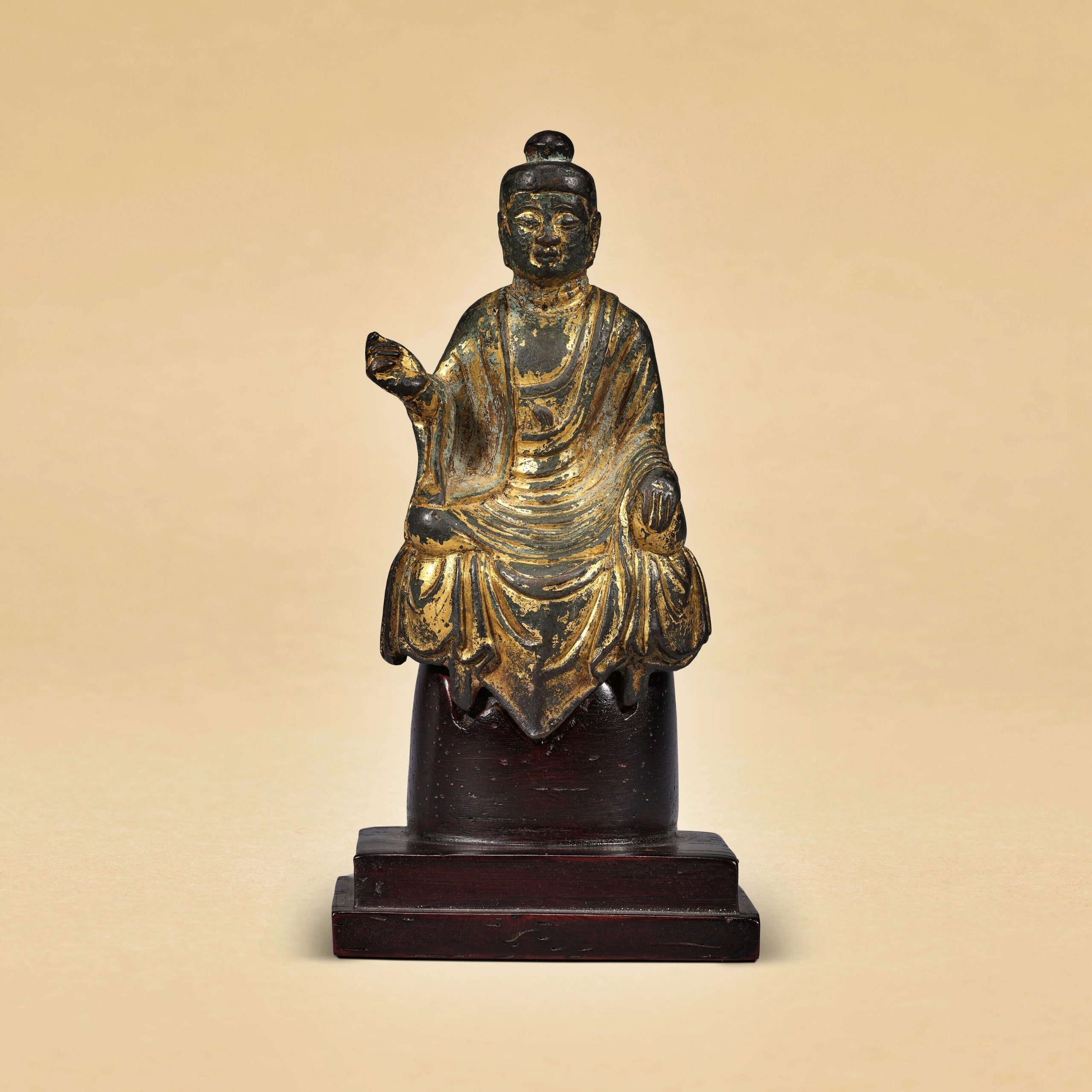
估價:港元 200,000 – 港元 300,000
成交價:港元 1,062,500
唐 鎏金銅佛坐像
TANG DYNASTY (AD 618-907)
2 ½ in. (6.5 cm.) high, wood stand
來源
James Marshall Plumer (1899-1960年)舊藏 (傳)
密歇根州私人舊藏 (傳)
紐約蘇富比,2014年3月19日,拍品176號
狀況報告
– 佛像右手拇指已失,食指尖端經打磨
– 表面有輕微凹痕、鎏金磨損及極輕微鏽蝕,屬正常現象
拍品專文
此鎏金銅佛結跏趺而坐,施安慰印,屬此年代佛造像中較為罕見。比較一施安慰印之坐佛,載於《金銅佛造像特展圖錄》,台灣,1987年,頁173,圖版76。台北故宮博物院亦藏有一近似例,手施降魔印並帶背光,館藏編號:贈銅000169。
比較一件尺寸較大、施無畏印之鎏金銅佛坐像,於2020年11月4日倫敦蘇富比拍賣,拍品148號;另一件坐佛身著較多摺之袈裟,2022年3月23日於紐約蘇富比拍賣,拍品292號。
参考:黑龙江省博物馆 藏品欣赏
唐渤海(698—926)镀金铜佛
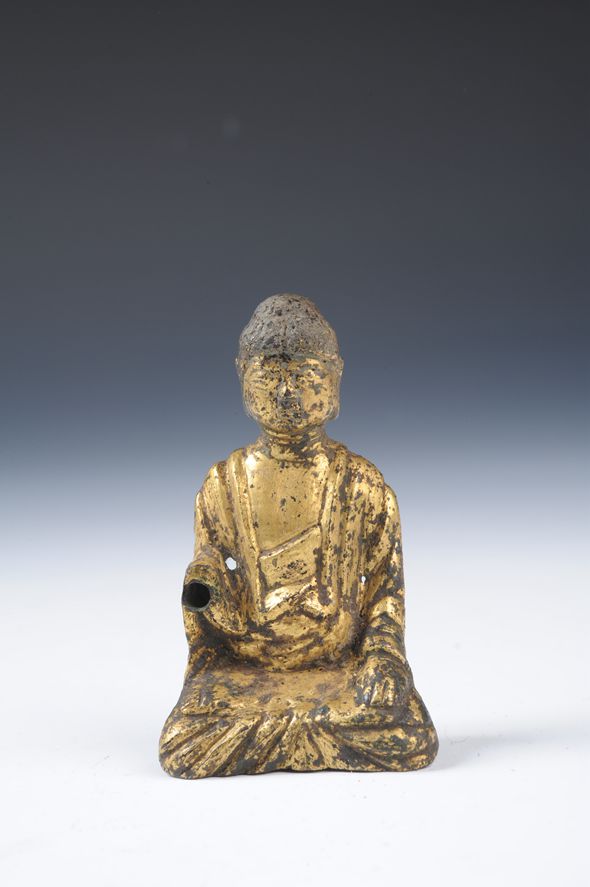
黑龙江省宁安市渤海上京龙泉府遗址出土
渤海的佛像种类很多,有铜、铁、陶和铜胎鎏金等不同质料,造型生动,代表着唐代渤海地区雕塑、彩绘和冶铸工艺水平,是研究渤海宗教文化及与中原地区文化交流的重要资料。
参考:故宫博物院
新00097155 雕塑
北魏正始四年
铜丘元达造释迦牟尼佛坐像
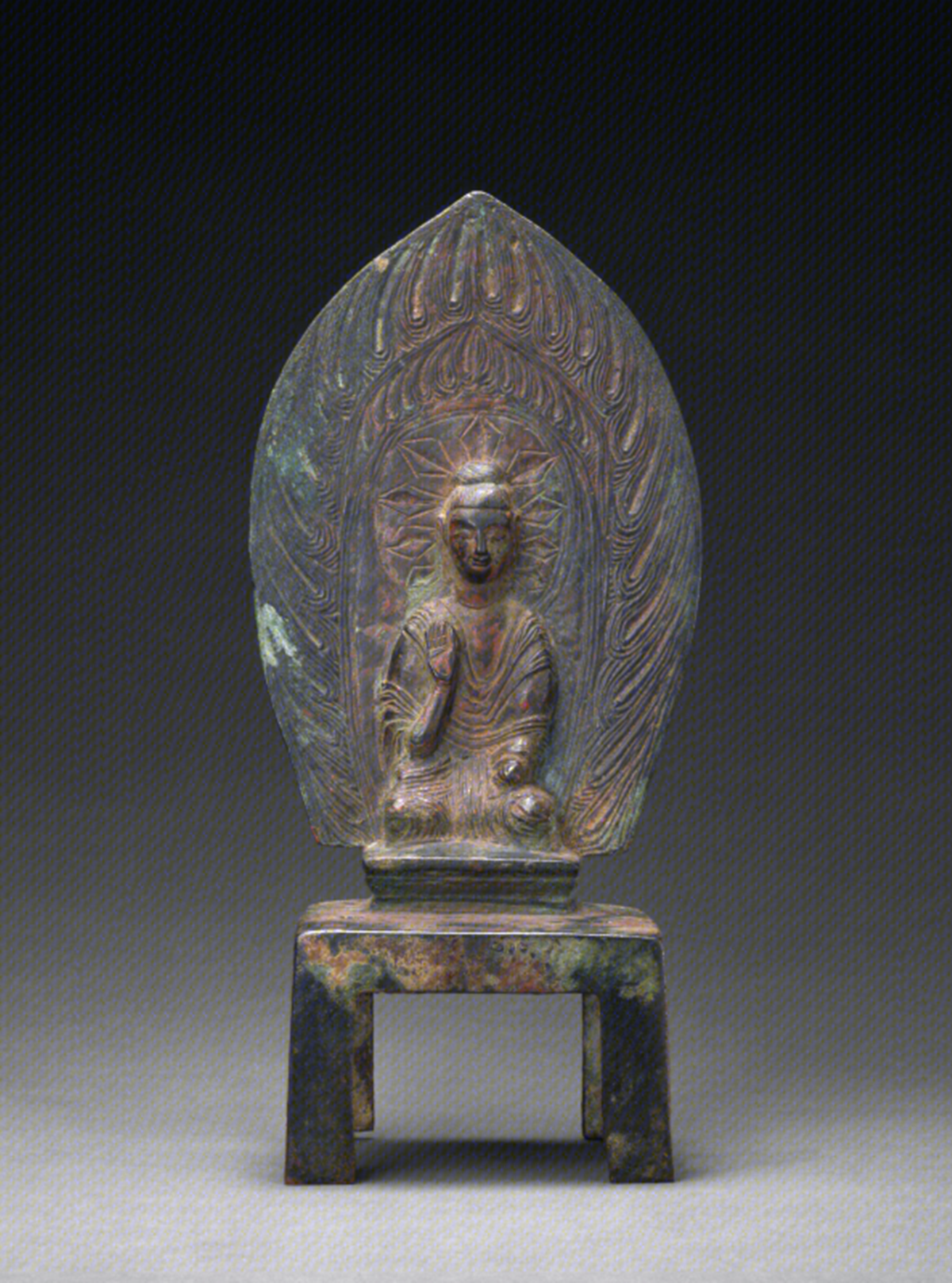
铜丘元达造释迦牟尼佛坐像
佳士得文章:热忱所在 佛教铜像
2017年8月24日 佳士得中国艺术品专家崔仕廷 (Tristan Bruck) 介绍一组于亚洲艺术周呈献的出色佛教铜像珍藏,并阐释其独特之处
「我研究过所有亚洲文化的艺术史,我认为佛教是亚洲各种文化的交汇之处。」身旁摆满手心大小的鎏金造像,佳士得亚洲艺术专家崔仕廷 (Tristan Bruck) 正在介绍一系列中国及韩国佛像;这些珍品述说着横跨600年的亚洲宗教艺术历史。
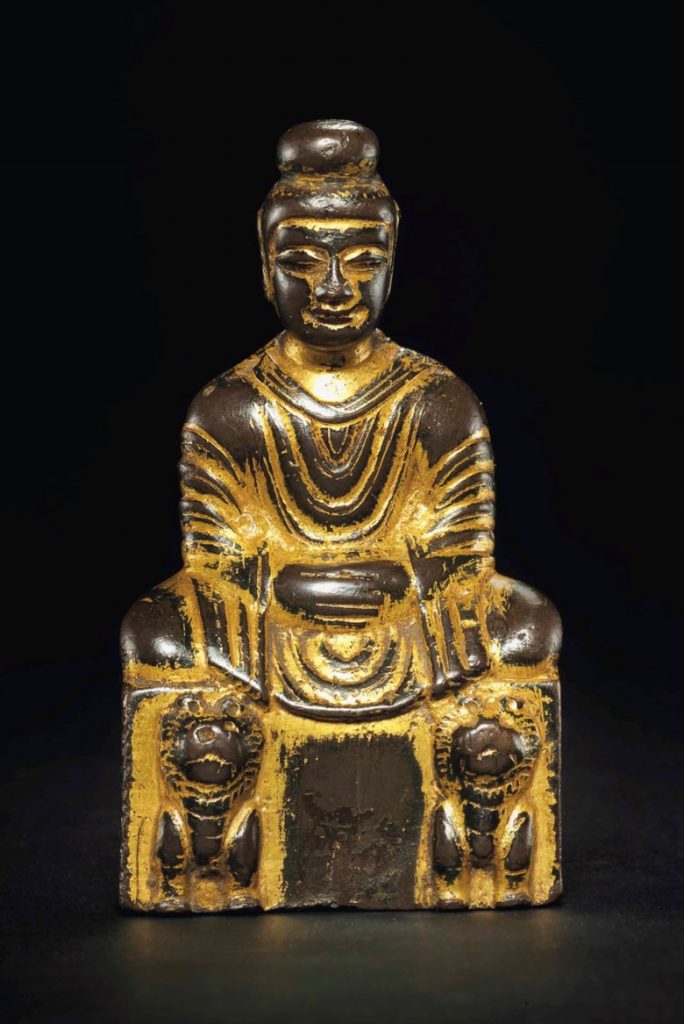
从一尊出自四世纪的佛像说起,这尊造像拥有印度 、古希腊及古罗马背景,从中可以得窥亚历山大大帝的征战历史,而雕像上刻有的一对狮子,是工匠从未亲眼见过的生物。然后登场的一尊佛像,则展现了理想化的佛陀形象。崔仕廷认为此系列于亚洲艺术周呈献的珍藏,让「我们得以一窥1500年前的平民生活。」
「佛像小巧轻盈,可放入口袋或鞍囊中,用于自行设坛敬拜。」
「早期的中国佛像来自僧侣和商贾,经丝路从中亚及印度带往中国。佛像小巧轻盈,可放入口袋或鞍囊中,用于自行设坛敬拜。」崔仕廷如是说,并同时介绍了在他眼前那些佛像的重要性及吸引之处。
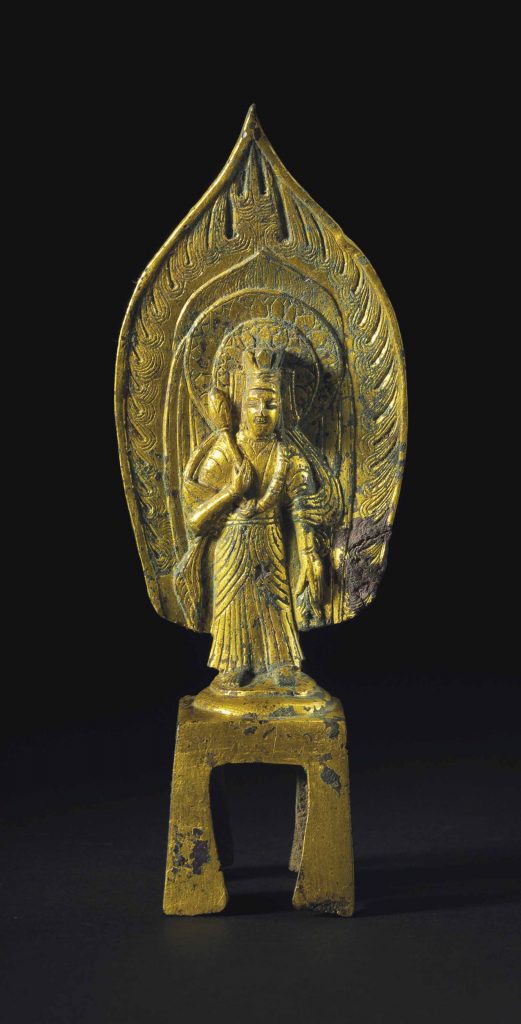
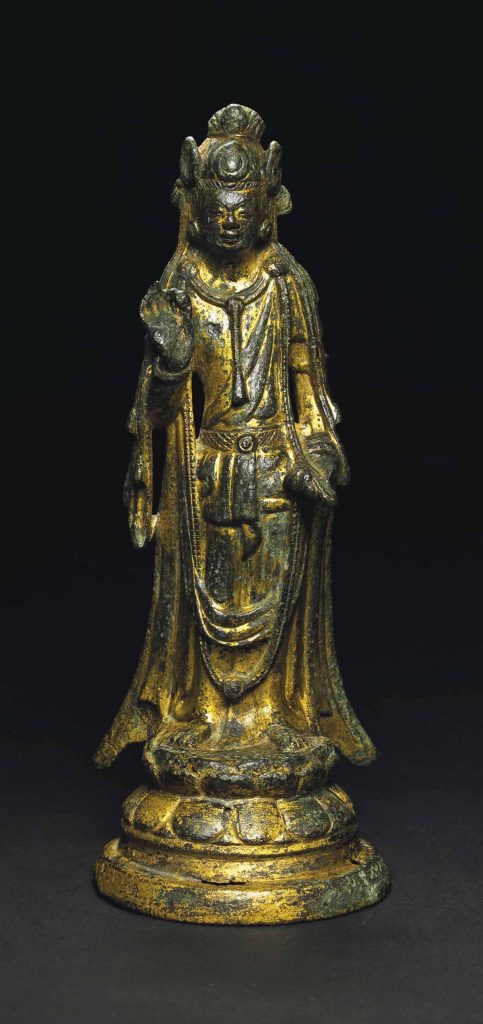
「佛教后来传入日本,」崔仕廷于短片中说,讲述了此组佛像所经历过的旅途。「各种文化以自己的方式诠释佛教;所以研究佛教艺术,便是研究亚洲艺术的历史。」
参考:佳士得
13 9月 2017| 现场拍卖 15939
观悟正道:日本珍藏早期佛教艺术
拍品 804 北魏 鎏金佛
A GILT-BRONZE FIGURE OF SHAKYAMUNI BUDDHA
NORTHERN WEI DYNASTY (AD 386-534), LATE 5TH CENTURY
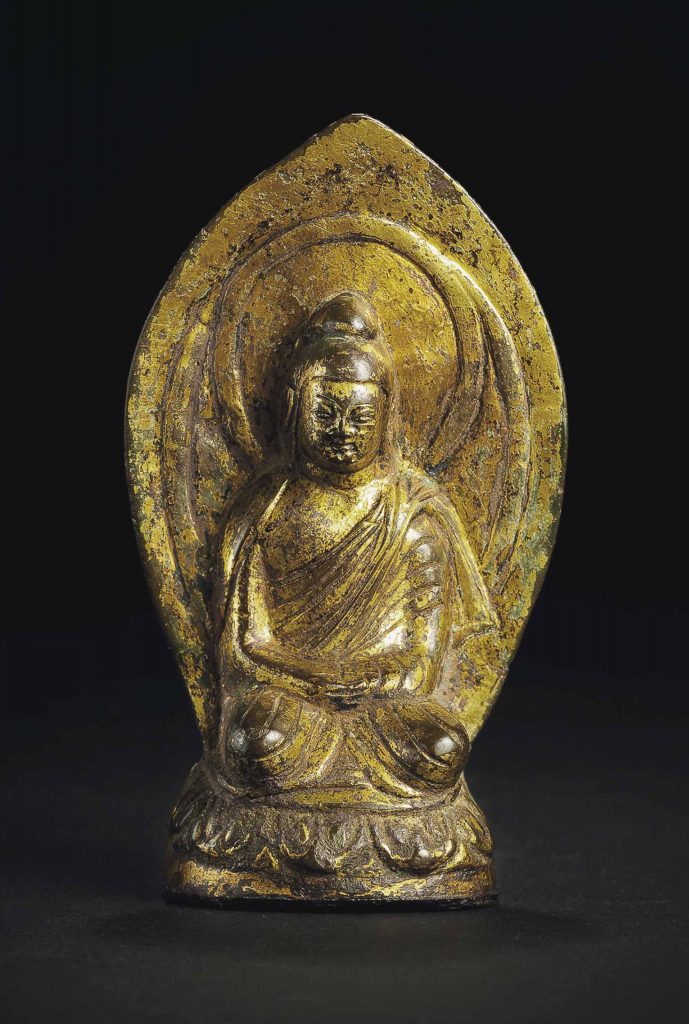
成交价 USD 60,000
估价 USD 6,000 – USD 8,000
A GILT-BRONZE FIGURE OF SHAKYAMUNI BUDDHA
NORTHERN WEI DYNASTY (AD 386-534), LATE 5TH CENTURY
细节
A GILT-BRONZE FIGURE OF SHAKYAMUNI BUDDHA
NORTHERN WEI DYNASTY (AD 386-534), LATE 5TH CENTURY
Buddha is shown seated in dhyanasana on a lotus base, with one end of the simple robe that is wrapped around the body draped over the left shoulder. The body is backed by a plain flame-shaped aureole surrounding a nimbus with raised border behind the head.
4 5/8 in. (11.7 cm.) high
来源
Private collection, Japan, acquired prior to 1930.
状况报告
We have sought to record changes in the condition of this piece acquired after its initial manufacture.
– There is wear to the gilding and some areas of encrustation.
– The stand is missing.
拍品专文
Compare the similar figure dated Northern Wei dynasty illustrated by Jin Shen in Hai wai ji Gang yai cang li dai fo xiang: zhen pin ji nian tu jian (Catalogue of Treasures of Buddhist Sculptures in Overseas Collections Including Hong Kong and Taiwan), Shanxi, 2007, p. 430 (top).
参考:佳士得
13 9月 2017| 现场拍卖 15939
观悟正道:日本珍藏早期佛教艺术
拍品 818 隋 鎏金立佛
A SMALL GILT-BRONZE FIGURE OF A BODHISATTVA
SUI DYNASTY (AD 581-618)
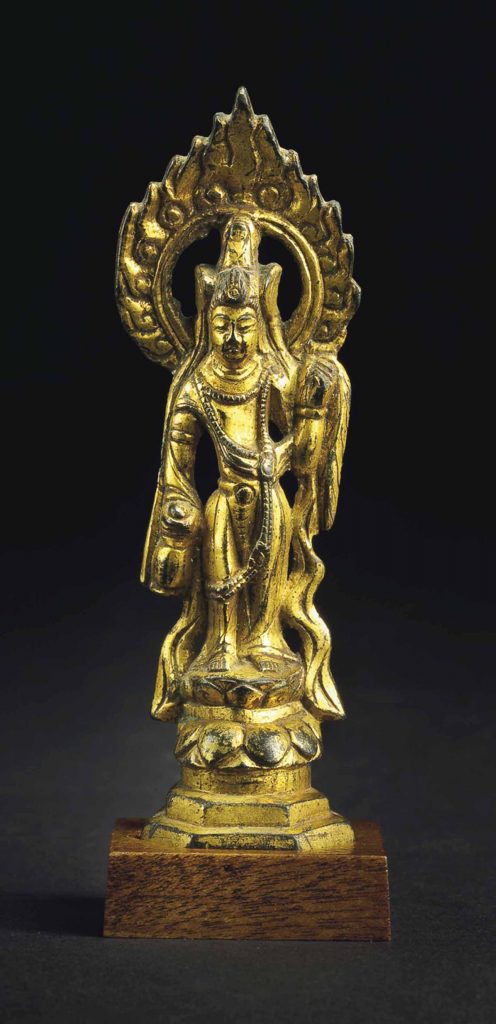
成交价 USD 23,750
估价 USD 6,000 – USD 8,000
A SMALL GILT-BRONZE FIGURE OF A BODHISATTVA
SUI DYNASTY (AD 581-618)
细节
A SMALL GILT-BRONZE FIGURE OF A BODHISATTVA
SUI DYNASTY (AD 581-618)
The bodhisattva Avalokiteshvara is shown standing in tribangha on a double lotus base raised on a tiered pedestal with faceted sides, holding a kamandalu (‘holy water’ bottle) in the pendent right hand and a willow branch in the raised left hand, and wearing a long, looped bead necklace, long swirling scarf and a ribbon-hung crown surmounted by a small figure of Amitabha Buddha, the head surrounded by a flame-form aureole with open nimbus center.
3 ½ in. (8.9 cm.) high, wood stand, Japanese wood box
出版
Kubosu Memorial Museum of Art, Gilt Bronze Buddhist Figures from Sui and Tang Dynasty, Osaka, 1993, p. 32, no. 82.
展览
Osaka, Kubosu Memorial Museum of Art, Gilt Bronze Buddhist Figures from Sui and Tang Dynasty, 1993, no. 82.
状况报告
We have sought to record changes in the condition of this piece acquired after its initial manufacture.
– There is some wear to the gilding.
– The back of the head is not gilded, which is original.
参考:佳士得
13 9月 2017 | 现场拍卖 15939
观悟正道:日本珍藏早期佛教艺术
拍品 801 十六国 鎏金佛
A SMALL EARLY GILT-BRONZE FIGURE OF SHAKYAMUNI BUDDHA
SIXTEEN KINGDOMS PERIOD (AD 304-439)
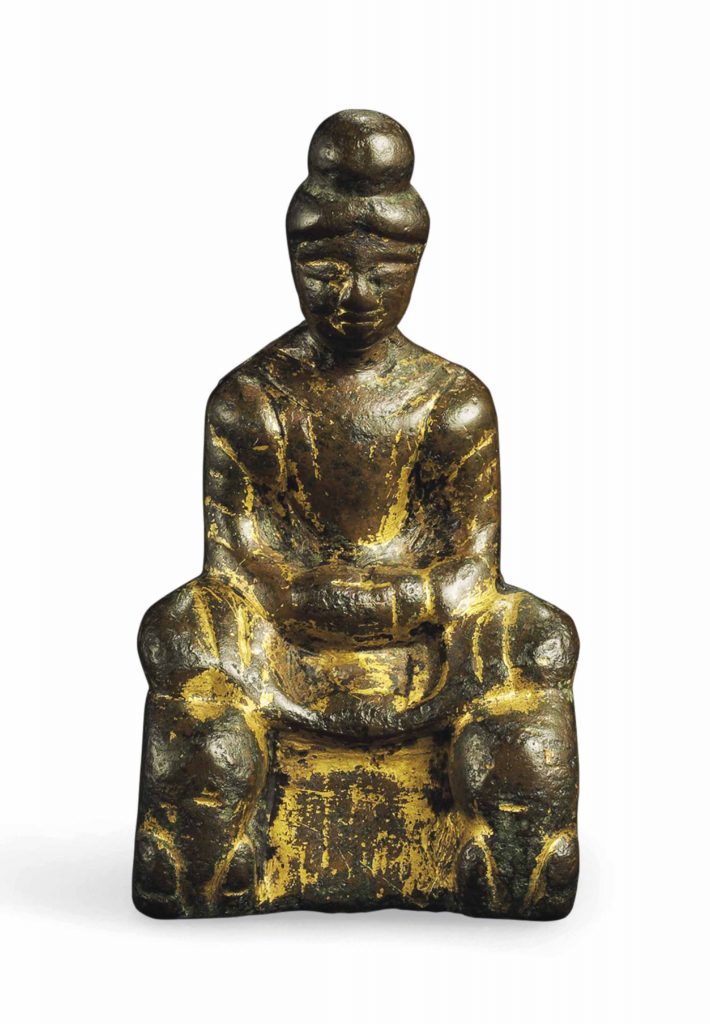
成交价 USD 17,500
估价 USD 5,000 – USD 7,000
A SMALL EARLY GILT-BRONZE FIGURE OF SHAKYAMUNI BUDDHA
SIXTEEN KINGDOMS PERIOD (AD 304-439)
细节
A SMALL EARLY GILT-BRONZE FIGURE OF SHAKYAMUNI BUDDHA
SIXTEEN KINGDOMS PERIOD (AD 304-439)
The figure is shown seated in dhyanasana on a lion throne, and wears a square shawl that is draped around the body. A small attachment tab projects from the back of the head.
3 1/8 in. (8 cm.) high, wood stand
来源
Private collection, Japan, acquired prior to 1930.
状况报告
We have sought to record changes in the condition of this piece acquired after its initial manufacture.
– There is extensive wear to the gilding and surface is somewhat worn.
– The aureole is missing.
– The pin for attachment is missing.
拍品专文
This figure belongs to a specific group of small sculptures of Shakyamuni Buddha made for personal devotion that found popularity during the fourth to fifth centuries in China. They are some of the earliest free-standing representations of Buddha made in China, and point to the direct spread of Buddhism from India into China.
参考:佳士得
13 9月 2017| 现场拍卖 15939
观悟正道:日本珍藏早期佛教艺术
拍品 812 西魏 鎏金立佛
The Property of Goto Shinshudo
A GILT-BRONZE FIGURE OF A BODHISATTVA
WESTERN WEI DYNASTY (AD 535-556)
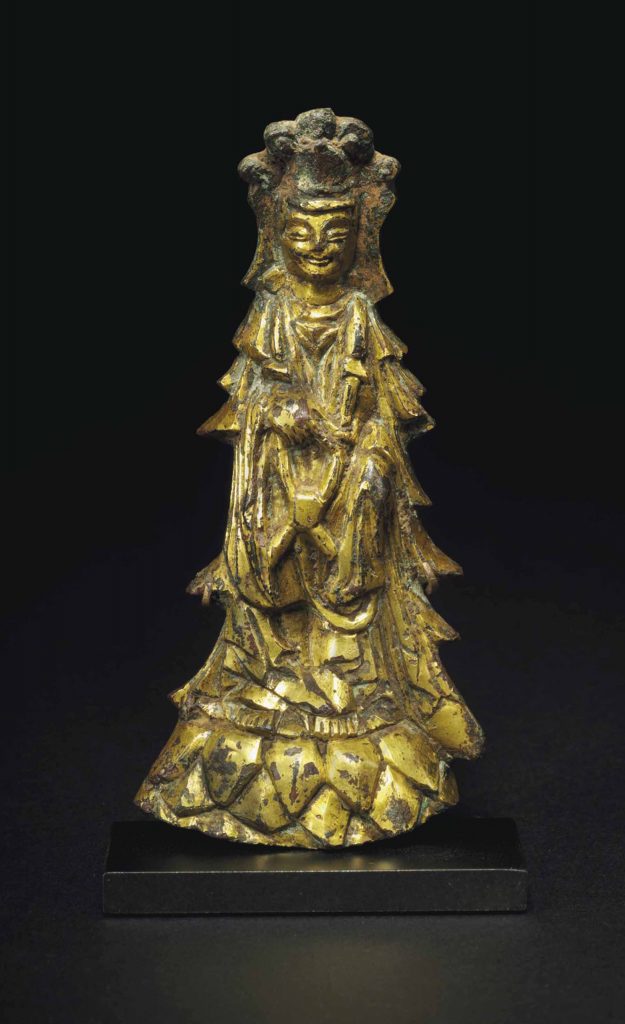
成交价 USD 118,750
估价 USD 20,000 – USD 30,000
A GILT-BRONZE FIGURE OF A BODHISATTVA
WESTERN WEI DYNASTY (AD 535-556)
细节
A GILT-BRONZE FIGURE OF A BODHISATTVA
WESTERN WEI DYNASTY (AD 535-556)
The figure is heavily cast and shown standing on a lotus base, the right hand holding a section of the long, looped necklace gathered by a disk below the waist of the layered robes, and the left hand holding the scarf draped over the left arm, while the ends of the robes and the scarves flare out to the sides. The face is cast with a gentle expression, and is framed by the ribbons that trail from the crown decorated with three globular ‘jewels’. Two pierced attachment tabs project from near the edge of the hollow back on the figure’s proper right side.
4 3/8 in. (11.2 cm.) high
来源
Mayuyama & Co., Tokyo, prior to 1983.
出版
Osaka City Museum, Art of the Six Dynasties, Osaka, 1975, p. 34, no. 3-180.
Osaka City Museum, Chinese Buddhist Sculpture, Osaka, 1984, p. 61, no. 89.
Kuboso Art Museum, Gilt Bronze Buddhas from the Six Dynasties period, Osaka, 1991, p. 92, no. 92.
Museum Yamato Bunkakan, Chinese Gilt Bronze Buddhist Figures, Nara, 2 October – 8 November, 1992, p. 70, no. 38.
Matsubara Saburo, Chugoku Chokokushi ron (The Path of Chinese Buddhist Sculpture), Tokyo, vol. 1, 1995, pl. 260b.
展览
Osaka, Osaka City Museum, Art of the Six Dynasties, 10 October – 9 November, 1975, no. 3-180.
Osaka, Osaka City Museum, Chinese Buddhist Sculpture, Osaka, 6 October – 11 November, 1984, no. 89.
Osaka, Kuboso Art Museum, Gilt Bronze Buddhas from the Six Dynasties period, 1991, no. 92.
Nara, Museum Yamato Bunkakan, Chinese Gilt Bronze Buddhist Figures, 2 October – 8 November 1992, no. 78.
状况报告
We have sought to record changes in the condition of this piece acquired after its initial manufacture.
– There is expected wear to the gilding.
– There is some encrustation on the front, primarily on the crown, and allover the un-gilded back.
– The bottom attachment tab may have been off an re-attached or some filler has been added around one side where it is attached to the back.
拍品专文
This figure of a bodhisattva would have been part of a large, complex Buddhist votive group, probably flanking a central figure of Buddha, as the two attachment tabs are positioned near one edge of the back. The treatment of the robes and scarves, which flare outward in an animated fashion from the sides, is one of the distinctive styles seen during the Northern Wei, Eastern Wei and Western Wei periods. A similar treatment of the robes, with flaring, wing-tipped drapery, can be seen on the figure of a gilt-bronze luohan (14.6 cm. high) in the Fogg Museum, Cambridge, illustrated by H. Munsterberg, Chinese Buddhist Bronzes, Vermont/Tokyo, 1967, frontispiece, where it is dated Northern Wei dynasty. This depiction of the robes and scarves creates an abstract, linear pattern that obscures the body. The current figure is very similar to another bodhisattva figure which forms the center of a complex votive group in the Art Institute of Chicago, illustrated by Matsubara Saburo in Chugoku Bukkyo Chokokushi ron (The Path of Chinese Buddhist Sculpture),Tokyo, 1995, vol. 1, pl. 296, where it is dated Western Wei (AD 535-556), as it is by Jin Shen in Zhongguo lida jinian foxiang tudian (Illustrated Chinese Buddha Images through the Ages), Beijing, 1995, p. 216, no. 158. Not only are the robes, scarves and necklace similar, but also the shape and features of the face and the crown with trailing ribbons. Like the current figure, the bodhisattva in the published group stands on a lotus base, but is surrounded by subsidiary figures, all raised on a stand with open sides that is inscribed with a dedicatory inscription by Kang Sheng dated to AD 539.
参考:苏富比
Arts d’Asie Online
9 November 2021 • 12:00 CET • Paris
Property from a French private collection
法國私人收藏
168
A gilt-bronze Buddha, Ming dynasty
明 鎏金銅佛坐像
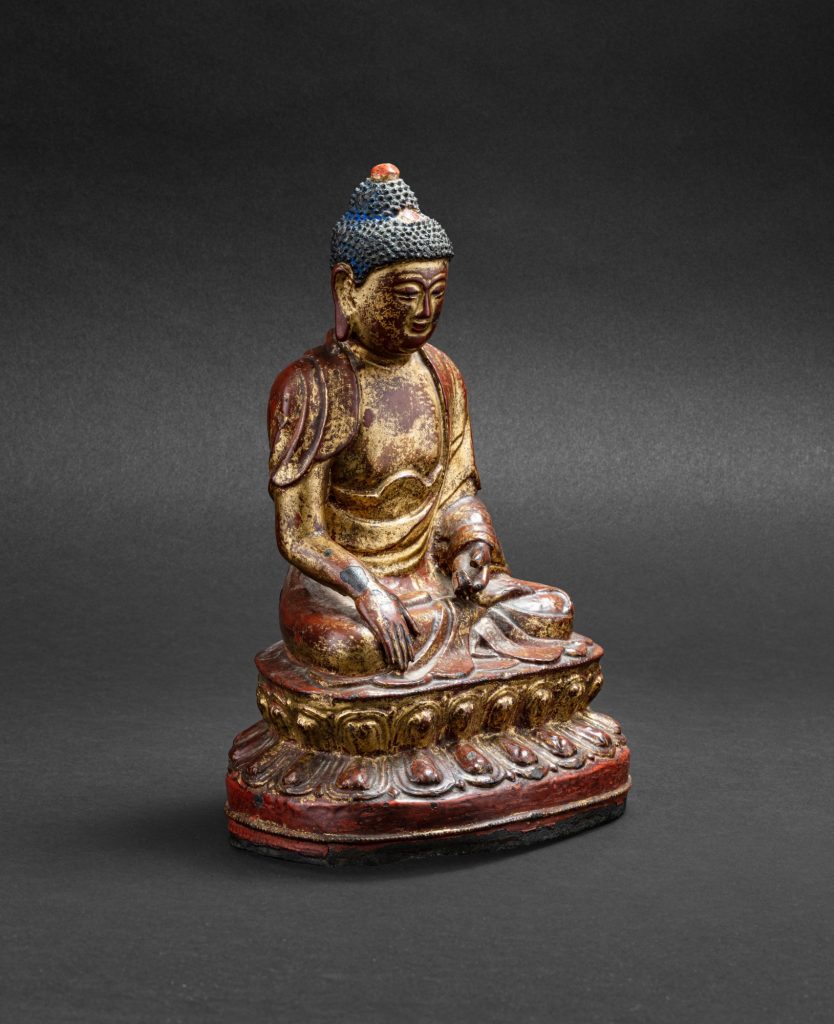
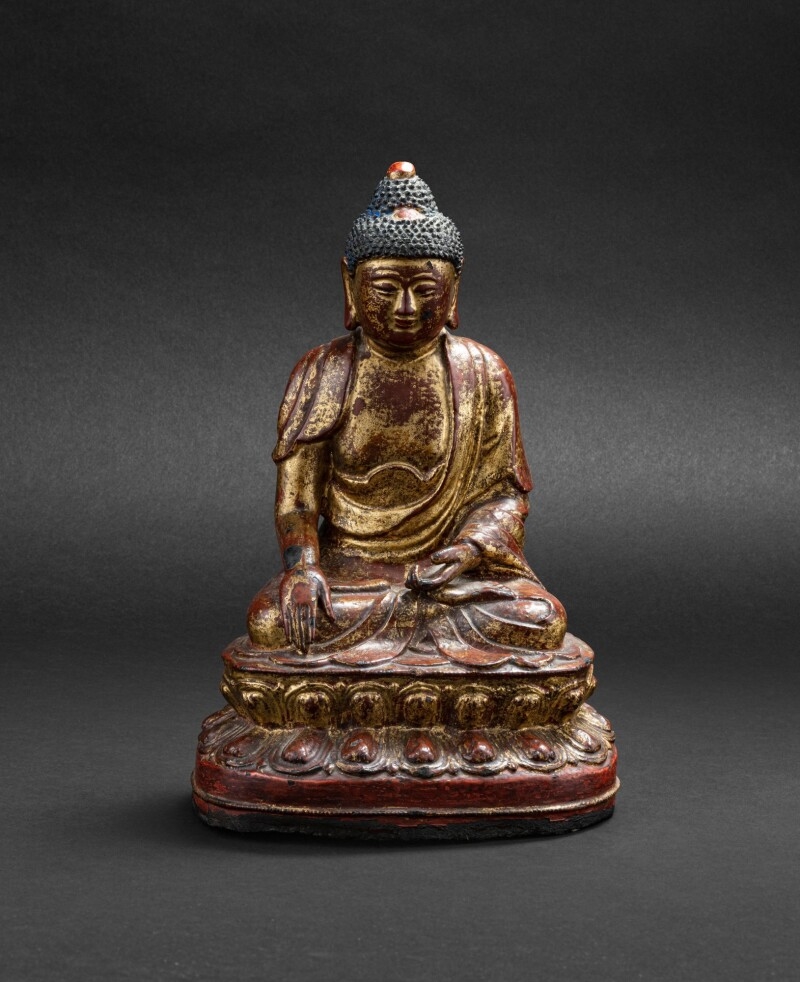
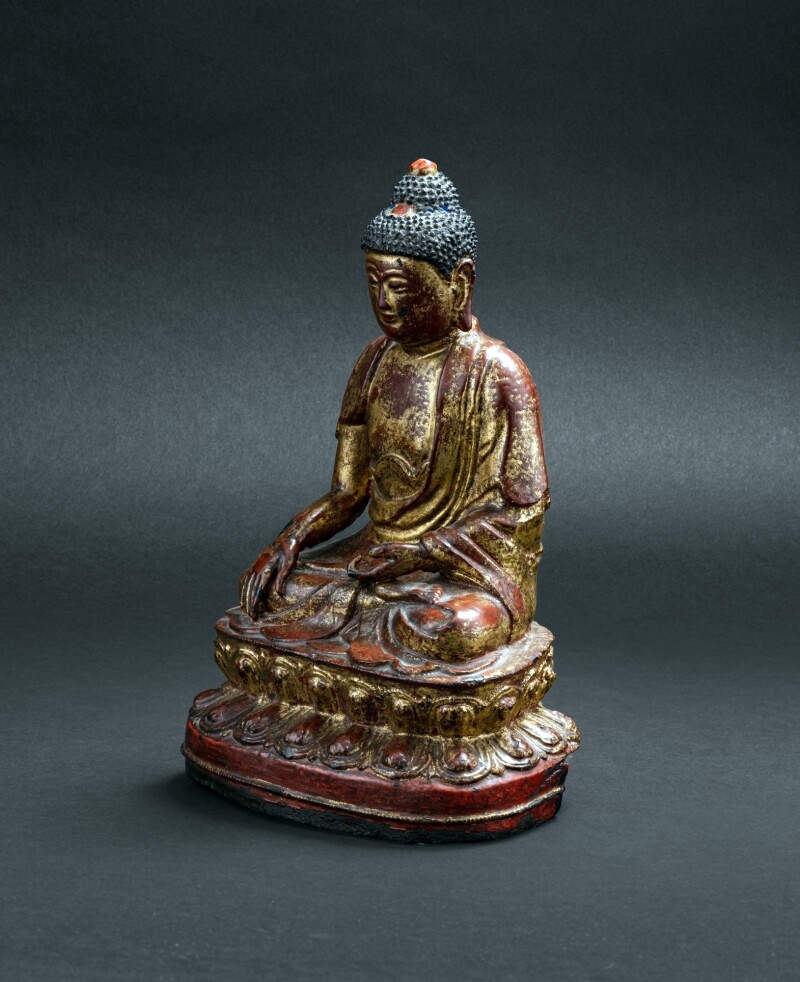
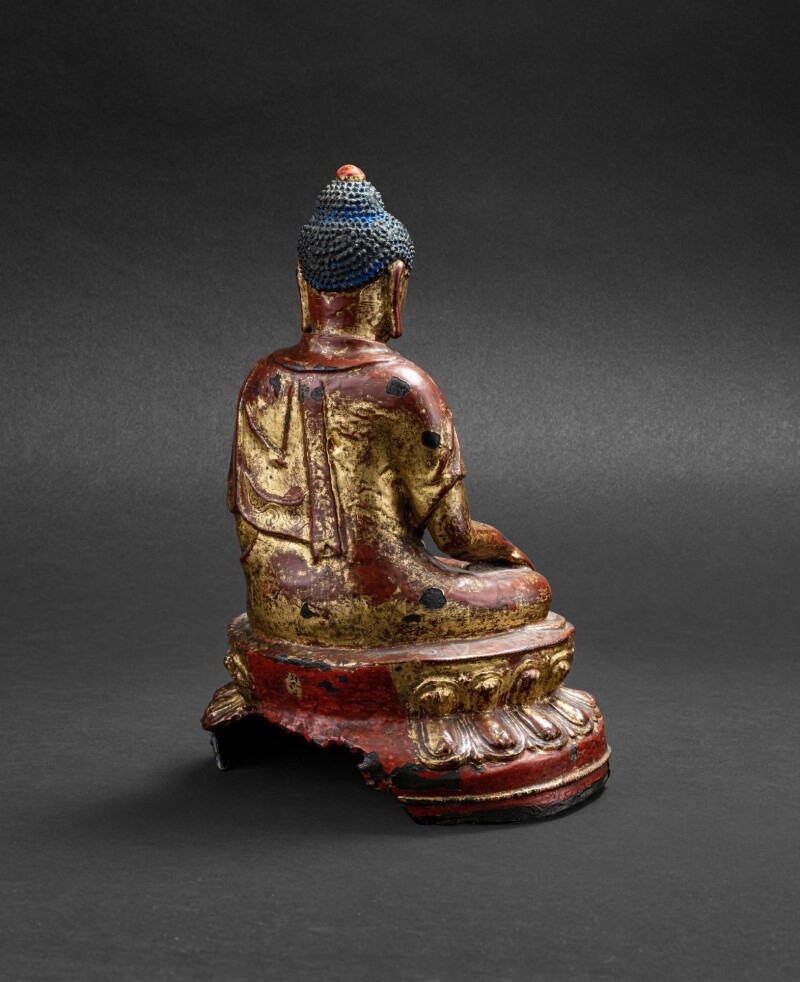
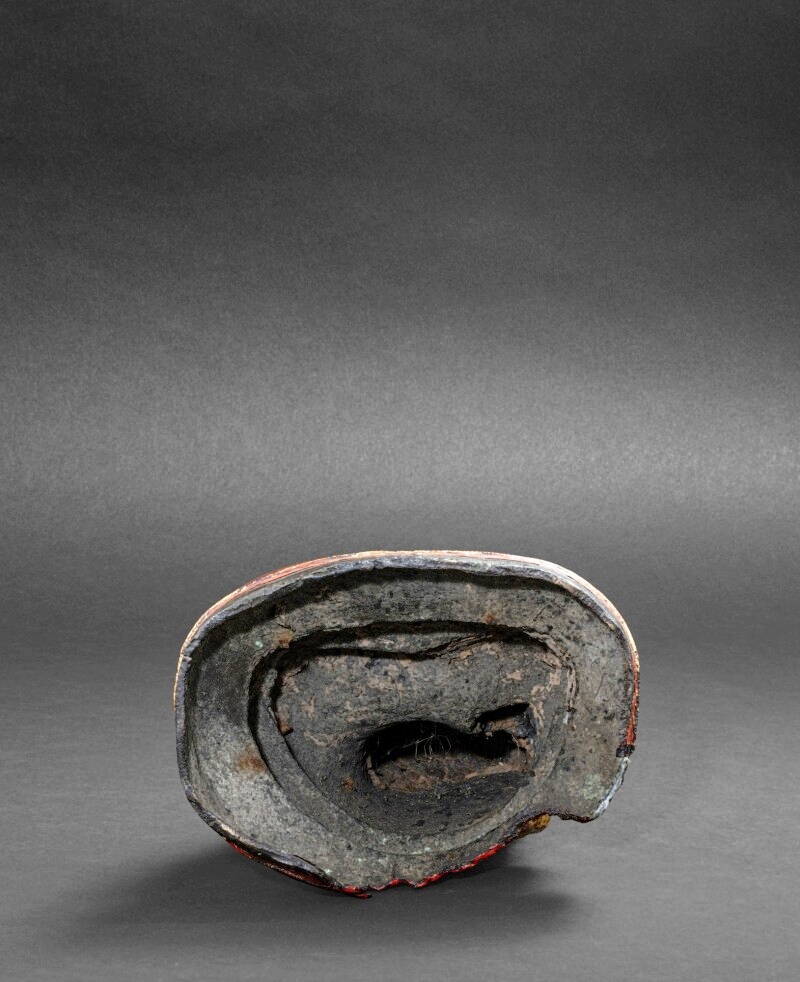
Estimate: 1,200 – 1,500 EUR
Lot sold: 5,292 EUR
Description
Property from a French private collection
A gilt-bronze Buddha
Ming dynasty
seated in vajrasana on a double lotus base, the right hand in bhumisparsa mudra and the left in avakasha mudra, unsealed
32.2 cm, 12¾ in.
Collection particulière française
Figure de bouddha en bronze doré, dynastie Ming
法國私人收藏
明 鎏金銅佛坐像
Condition Report
A section of the cast at the back of the lotus base is broken and missing, otherwise the buddha is generally in good condition.
There is rubbing to the gilding and expected surface wear as visible on the catalogue photo.
蓮花座背部見部分破損及缺失,除此以外,品相良好。如圖所見,鎏金及表面均見磨損,屬正常。
参考:佳士得
19 3月 2014 | 现场拍卖 3484
般若妙相:虔诚信仰艺术精品
拍品 1601
A RARE SMALL GILT-BRONZE FIGURE OF SHAKYAMUNI BUDDHA
PROPERTY FROM A DISTINGUISHED PRIVATE COLLECTION
十六国时期 铜鎏金释迦牟尼佛小坐像
CHINA, SIXTEEN KINGDOMS PERIOD (304-439)
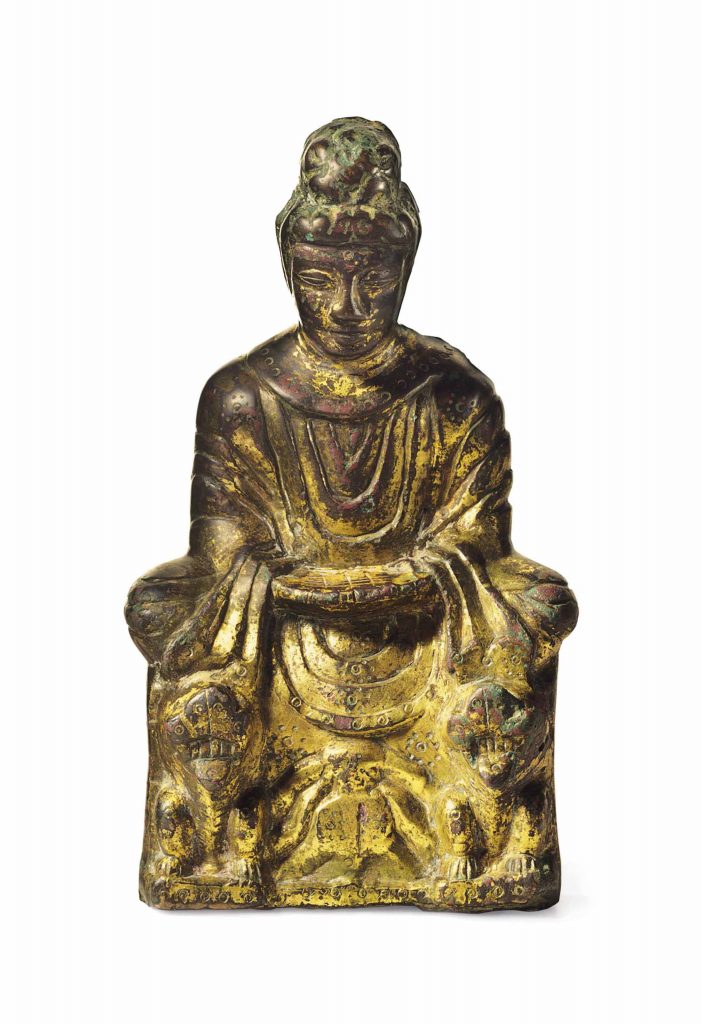
成交价 USD 245,000
估价 USD 200,000 – USD 300,000
十六国时期 铜鎏金释迦牟尼佛小坐像
CHINA, SIXTEEN KINGDOMS PERIOD (304-439)
来源
Acquired from a private collection, Japan, in the 1980s.
Sotheby’s New York, 22 September 2005, lot 8.
出版
Sumitomo Collection, Gilt Metal Buddhist Figures. The Essence of Buddhist Art in East Asia, Kyoto, March 2004, p. 11, no. 2.
Comprehensive Illustrated Catalogue of Chinese Buddhist Statues in Overseas Collections, vol. 1, Beijing, 2005, p. 17.
状况报告
There are two small holes in the back of the figure that are the result of the casting process. There is a tiny circular hole on the ends of the base. There is expected wear to the gilding, and some green encrustation.
拍品专文
This small, well-cast figure is a fine example of a specific group of small sculptures of Shakyamuni Buddha made for personal devotion that found popularity during the fourth to fifth centuries in China. They are some of the earliest free-standing representations of Buddha made in China, and point to the direct spread of Buddhism from India into China. This group of figures retains the stylistic influences of earlier Indian representations, such as the pose, the type of garment with parallel folds, and the treatment of the hair, with wavy curls covering the ushnisha. This iconography is apparent in a seated figure of Buddha in the center of the cover of a Gandharan gilt-bronze reliquary, dated circa 100-150 CE, now in the Peshawar Museum of Art, and illustrated by Denise P. Leidy, Donna Strahan, et al., in Wisdom Embodied: Chinese Buddhist and Daoist Sculpture in the Metropolitan Museum of Art, New York, 2010, p. 7, fig. 4. The robes of this latter figure have a more natural, and fluid appearance, which is characteristic of Gandharan and Mathuran sculpture of second-century date, but these softer lines evolved into the simplified, more abstract linear folds of the robes of the Chinese figures, such as those of one of the earliest-known Chinese figures of this type in the Brundage Collection, Asian Art Museum of San Francisco, which is dated 338 CE, and is illustrated by Hugo Munsterberg in Chinese Buddhist Bronzes, Vermont/Japan, 1967, p. 37, pl. 1. The Brundage figure has a plain rectangular base, but other similar figures are seated on a “lion” throne, similar to that of the present figure. These include an example dated to the early fifth century, in the Nelson- Atkins Museum of Art, also illustrated by Munsterberg, pl. 2, and another very similar figure dated to the Sixteen Kingdoms period, late fourth to early fifth century, in the Metropolitan Museum of Art, illustrated in Wisdom Embodied, op. cit., pp. 48-50, no. 1. As with the base of the present figure, two lions flank a vase of flowers or a lotus, and this representation, too, is based on Gandharan and Mathuran iconography of second and third century date. Several similar Chinese gilt-bronze figures seated on a similar “lion” throne are illustrated by Saburo Matsubara in Chugoku Bukkyo chokokushi shiron, vol. 1, Early Six Dynasties, Tokyo, 1995, pls. 10-14.
参考:佳士得
18 9月 2014 | 现场拍卖 2872
中国瓷器及工艺精品
拍品 1023 明洪武丙子年 鎏金释迦牟尼佛造像
A MINIATURE GILT-BRONZE FIGURE OF SHAKYAMUNI BUDDHA
MING DYNASTY, HONGWU BINGZI CYCLICAL YEAR, CORRESPONDING TO 1371, AND OF THE PERIOD
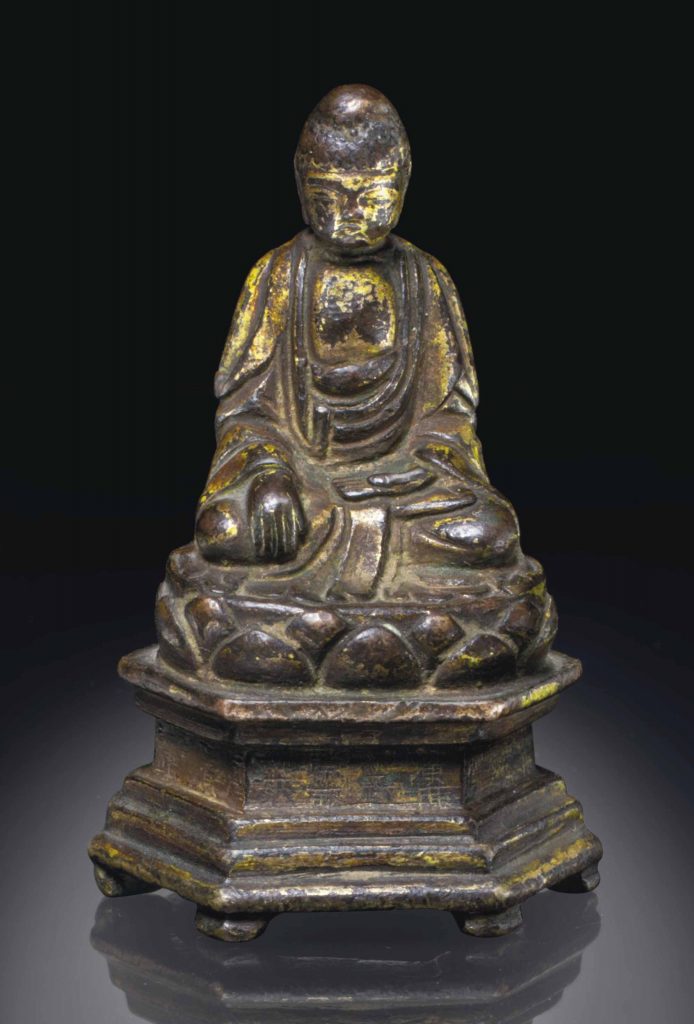
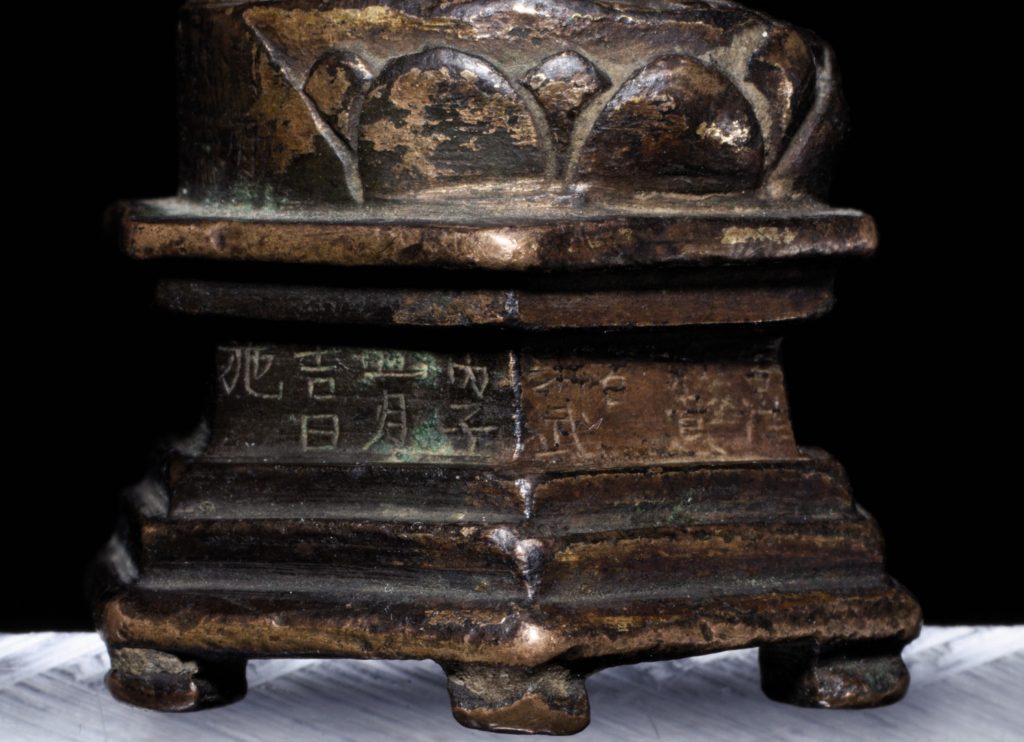
成交价 USD 47,500
估价 USD 5,000 – USD 7,000
A MINIATURE GILT-BRONZE FIGURE OF SHAKYAMUNI BUDDHA
MING DYNASTY, HONGWU BINGZI CYCLICAL YEAR, CORRESPONDING TO 1371, AND OF THE PERIOD
细节
A MINIATURE GILT-BRONZE FIGURE OF SHAKYAMUNI BUDDHA
MING DYNASTY, HONGWU BINGZI CYCLICAL YEAR, CORRESPONDING TO 1371, AND OF THE PERIOD
The figure is shown seated on a lotus plinth in dhyanasana with right hand lowered in bhumisparsa mudra and left hand in dhyanamudra, the whole raised on an hexagonal pedestal finely incised with a dedication, including the cyclical date, first month of the bingzi year. Another inscription is incised on the back of the lotus plinth.
2¼ in. (5.7 cm.) high
状况报告
We have sought to record changes in the condition of this piece acquired after its initial manufacture.
– there are minor nicks, scratches, and surface abrasions, with associated loses and gilding in discret areas, including the lower back, center of the chest, and face, as is visible in the printed catalogue
拍品专文
The inscription on the pedestal base, Hongwu bingzi yiyue jiri shi, ‘made on an auspicious day in the first month of the bingzi year (29th year) during the Hongwu reign,’ is similar to the inscription dated to the fourth month of the bingzi year, inscribed on a similar miniature gilt-bronze Buddha sold at Christie’s Hong Kong, 27 November 2007, lot 1806, which also bears a lengthy dedicatory inscription, referring to the figure as being part of a group totaling 5,048 made for worship by future devotees. Another of these figures dated to the 29th year of the Hongwu reign is illustrated in Gems of Beijing Cultural Relics Series: Buddhist Statues I, Beijing, 2001-2004, p. 73, pl. 34.
参考:佳士得
19 3月 2015 | 現場拍賣 11421
錦瑟華年 – 安思遠私人珍藏
第四部分:中國工藝精品 ─ 金屬器、雕塑及早期瓷器
拍品 759
A SMALL GILT-BRONZE FIGURE OF BUDDHA
唐 鎏金銅佛坐像
CHINA, TANG DYNASTY (AD 618-907)
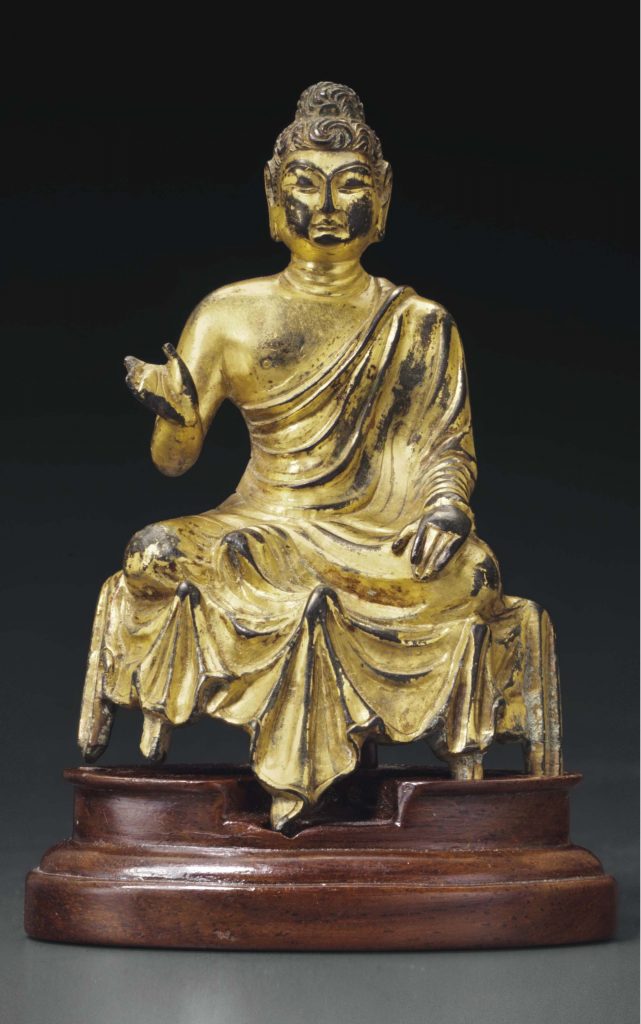
成交價 USD 161,000
估價 USD 20,000 – USD 30,000
來源
Christian Humann (d.1981), New York, named the Pan-Asian Collection by 1977.
The Collection of Robert H. Ellsworth, New York, acquired in 1982.
狀況報告
We have sought to record changes in this piece acquired after its initial manufacture.
-minor nicks and scratches and wear to gilding overall
-some losses including to the fingertips of the right hand
參考:國立故宮博物院
中國 四~五世紀 銅鎏金佛坐像

資料識別:贈銅000422N000000000
資料類型:銅器、金屬器
描述:坐佛表情稚拙,身著通肩式僧衣,結跏趺坐,雙手作禪定印,頸肩衣緣清晰,衣褶作平行的弧形線,造型輪廓秀氣,和中國四世紀後期北方坐佛的造型有相近之處。尊像與蓮座當為分鑄後接合,表面鎏金可能為後代重新處理過,銅質沉重,造像兩側隱約有鑄造線,似為合模而成,蓮座、五官和衣褶都有明顯刀刻痕跡,風格樸拙。
日期:301 A.D.-500 A.D.
格式:高12.6公分 寬6.5厚5.4公分
關聯:《法象風規-彭楷棟先生遺贈文物特展》
参考:苏富比
中國藝術珍品
08 十月 2019 • 香港
拍品 3625
十六國四至五世紀初 鎏金銅犍陀羅式釋迦牟尼佛坐像
A RARE EARLY GANDHARAN-STYLE GILT-BRONZE VOTIVE FIGURE OF SHAKYAMUNI BUDDHA SIXTEEN KINGDOMS, 4TH – EARLY 5TH CENTURY
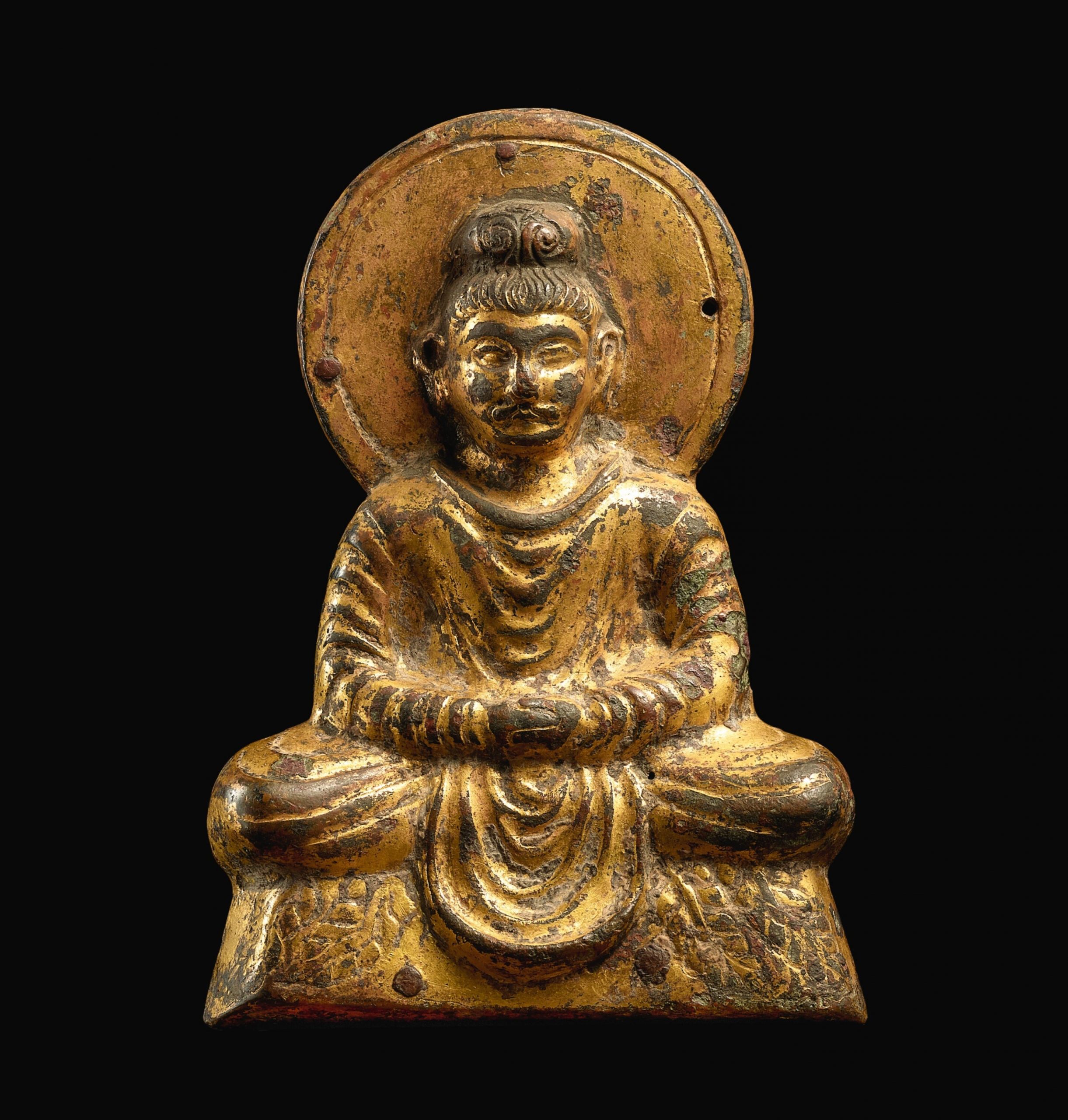
估價 900,000 – 1,200,000 HKD
已售出 1,125,000 HKD
描述Description
cast seated in dhyanasana on a slightly trapezoidal plinth with the hands held in dhyanamudra, clad in a monastic robe falling in geometricised banded layers of drapery inspired by Guptan figures, the serene face surmounted by a high domed usnisha before a halo, the recessed reverse with a loop for attachment to the fitted wood stand
参考:故宫博物院【八成金带座佛龛】


八成金带座佛龛,清,通高12.5厘米,长8.6厘米,宽4.6厘米。
佛龛八成金质,正面镶玻璃,周边为累丝缠枝莲花纹。佛龛顶部、底部及侧面均饰累丝卷草纹。背面有银质插门,周边亦为累丝缠枝莲花纹。插门上刻汉文“乾隆三十一年(1766年)九月初三日,钦命阿嘉胡士克图认看供奉利益番造手持金刚”31字以及满文、藏文题记。佛龛下部有金座,束腰式,錾刻莲瓣纹。座底刻佛花一朵。佛龛内供奉一尊小佛像,佛的头部描金,右手持金刚杵一。
此佛龛质地优良,小巧精致,是藏族僧人和信徒们为了表示虔诚,随身携带用以随时随地供佛的小佛龛。
撰稿人:杨捷
关键词: 累丝 缠枝 缠枝莲花纹 缠枝莲 卷草纹 卷草 束腰 錾刻 莲瓣纹 描金 金刚杵




佛龛是供奉佛像、神位等的小阁子,如佛龛、神龛等,一般为木制,中国古代的石窟雕刻一般是神龛式,小龛又称椟。龛原指掘凿岩崖为空,以安置佛像之所。据《观佛三昧海经》卷四记载,一一之须弥山有龛室无量,其中有无数化佛。《大毗婆沙论》卷一七七记载:底沙佛至山上,入吠琉璃龛,敷尼师檀,结跏趺坐,入火界定。现今各大佛教遗迹中,如印度之阿旃塔,爱罗拉,我国云冈、龙门等石窟,四壁皆穿凿众佛菩萨之龛室。后世转为以石或木,作成橱子形,并设门扉,供奉佛像,称为佛龛;此外,亦有奉置开山祖师像。
佛龛八成金质,正面镶玻璃,周边为累丝缠枝莲花纹。佛龛顶部、底部及侧面均饰累丝卷草纹。
背面有银质插门,周边亦为累丝缠枝莲花纹。插门上刻汉文“乾隆三十一年(1766年)九月初三日,钦命阿嘉胡士克图认看供奉利益番造手持金刚”31字以及满文、藏文题记。佛龛下部有金座,束腰式,錾刻莲瓣纹。
座底刻佛花一朵。佛龛内供奉一尊小佛像,佛的头部描金,右手持金刚杵一。
参考:故宫博物院【金嵌松石佛龛】

金嵌松石佛龛,清,通高15.7厘米,长10厘米,宽8.5厘米。
参考:北京保利2016春季拍卖会
自在菩提——中国金铜佛造像
北京保利国际拍卖有限公司
2016年6月01日-05日
北京四季酒店A厅
Lot.8111 18世纪 财宝天王及嘎乌

Estimate CNY 680,000 ~ 880,000
Size 佛高7.5;盒高11.5cm
Description
汉藏风格(北京宫廷),铜鎏金|嘎乌属于宗教用具,为藏语音译,多指挂在项上的或背挎式的佛盒饰物。嘎乌内大多装有佛像、护法神像或护身符。实为随身携带的佛龛。佛龛是藏人出门在外时携带,佛龛内放置着袖珍佛像或其它圣物,以便能够获得福运,禳灾驱邪,从中可以看出藏传佛教的修习方式影响到藏语人民的日常生活。嘎乌的质地有金质、银质、铜质等金属嘎乌,也有木质的。|本件鎏金双面嘎乌是财宝天王嘎乌,嘎乌盒盖刻有咒文,盒内沿有一圈精美的卷草纹雕刻装饰。财宝天王是专门保护众生的财富,是世上一切财富的守护者,是掌管财宝富贵、护持佛法的善神。头戴宝冠,身穿铠甲,身后帛带蜿蜒飘逸。天王宽额阔耳,面色微怒。左手捉持能吐无尽宝藏之吐宝鼠,右手持胜利宝幢,象征能赐无尽财富。游戏坐于伏地红鬃白狮子上,狮口大张,威猛无比。下承单层莲座,莲花整饬,制作精美。财宝天王嘎乌寓意吉祥且工艺精美,金水饱满靓丽,做工精细,是一件不可多得的清代宫廷精品。
参考:門得揚2017韵雅妙赏第七期
門得揚拍賣股份有限公司
门得扬艺术空间(台北市内湖区阳光街321巷60号2楼)
9月1日至9月8日
Lot.231 銅鎏金無量壽佛及嘎烏 清代

Size 高10.5公分
Description
臺灣資深藏家舊藏
参考:唐 纯金四门塔(法门寺博物馆藏)

塔是随着佛教的传入而出现的一种建筑形式,主要用来保存舍利。此塔用纯金铸成,由塔身和塔座构成。塔身为单层,下部錾出砌石纹样的台基,台基的四侧门下錾刻出象征性的条石垂带踏步,阑额錾连珠菱形锦纹。塔顶为四角攒尖形,塔檐叠涩外桃,四侧坡面均錾饰瓦纹,塔刹为硕大的火焰宝珠。塔体饰忍冬和阔叶卷草,塔坐四侧壁錾饰一周仰莲瓣。
参考:故宫博物院
【周府造铜鎏金佛坐像】

【周府造铜鎏金佛坐像】
周府造铜鎏金佛坐像,明洪武二十九年(1396年),高6厘米。
释迦像发作螺髻,手施禅定、与愿印,身著袈裟,结跏趺坐于莲台上。莲台下为六角束腰须弥座,须弥座束腰间刻发愿文云:“周府欲报四恩,命工铸造佛相,一样五千四十八尊,俱用黄金镀之,所以广陈供养,崇敬如来,吉祥如意者。洪武丙子四月吉日施。”
周府可能是周王府简称。《明史·卷一百十六》载,朱元璋第5子朱橚,初封吴王,洪武十一年(1378年)改封周王,十四年(1381年)就藩开封。二十二年(1389年),朱橚弃藩就凤阳,帝怒,使居京师,二十四年(1391年)归藩。后因有谋逆嫌疑,复召还京,锢之。成祖入南京,复爵。洪熙元年(1425年)薨。
这种铜鎏金佛造像,除北京故宫博物院有数件收藏外,还见于上海、北京及日本等公私收藏。从鎏金、发愿文保存情况看,应以此件为佳。上述造像反映出明代王府热衷佛教造像的现象。
撰稿人:冯贺军
关键词: 鎏金 与愿印 结跏趺坐 束腰 须弥座 发愿文 四恩 丙子 朱元璋 就藩 造像
参考:苏富比
PROPERTY FROM A JAPANESE PRIVATE COLLECTION
592 唐 銅鎏金彌勒佛坐像
A GILT-BRONZE FIGURE OF MAITREYA, TANG DYNASTY





Estimate:25,000 – 30,000 USD
Lot sold:31,500USD
Description
A GILT-BRONZE FIGURE OF MAITREYA
TANG DYNASTY
唐 銅鎏金彌勒佛坐像
crisply cast, seated with the proper right hand raised in the fear-allaying abhaya mudra, the head and face beautifully rendered with a peaceful countenance, the body dressed in generous robes secured around the waist and draped over the seat in voluminous pleats and folds, the back of the head with an aperture for a mandorla, wood stand, Japanese wood box (5)
Height 4⅞ in., 12.4 cm
Condition Report
There is evident loss to gilding with surface encrustation. The tip of the figure’s right index finger is abraded.
鎏金大部分已失,表面有結晶。右食指有磨損。
Literature
Saburo Matsubara, Chinese Buddhist Sculpture: A study based on bronze and stone statues other than works from cave temples, Tokyo, 1966, pl. 236d.
出版
松原三郎,《中国仏教彫刻史研究》,東京,1966年,圖版236d
Catalogue note
Compare similar gilt-bronze figures of seated Maitreya Buddha attributed to the Tang: one with a mandorla aperture cast to the back of the body, preserved in the Sano Art Museum, Mishima, also illustrated in Saburo Matsubara, Chinese Buddhist Sculpture: A study based on bronze and stone statues other than works from cave temples, Tokyo, 1966, pls 294b-c, and another with a high pedestal base, illustrated in ibid, pl. 294a. Another similar figure from a Japanese private collection was exhibited in the Special Exhibition: Gilt Bronze Buddhist Statues from Eastern Asia, Yamato Bunkakan, Nara, 1999, cat. no. 34, and sold in these rooms, 21st September 2006, lot 117.
参考:苏富比
PROPERTY FROM A JAPANESE PRIVATE COLLECTION
588 北魏太和二年(478年) 銅鎏金佛坐像
A GILT-BRONZE FIGURE OF A SEATED BUDDHA,
NORTHERN WEI DYNASTY,
DATED TAIHE SECOND YEAR, CORRESPONDING TO 478






Estimate:200,000 – 300,000 USD
Lot sold:252,000USD
Description
A GILT-BRONZE FIGURE OF A SEATED BUDDHA
NORTHERN WEI DYNASTY, DATED TAIHE SECOND YEAR, CORRESPONDING TO 478
北魏太和二年(478年) 銅鎏金佛坐像
seated in vajraparyankasana with the hands held in dhyana mudra, the hair and top knot with finely cast striations, dressed in a simple robe with finely rendered pleats over one shoulder, the back with an aperture for a mandorla, supported on a square base with an incised pattern along the top edge above a stepped and waisted standard further supported by a quadruped base, the front incised with two figures bearing leafy branches, the remaining three sides inscribed and dated, modern stand, Japanese wood box (5)
銘文:
太和二年九月廿一日 益都縣人宋桃根妻范勝二仁造須彌像一軀 𩔊使男女上者生天生者□足𩔊𩔊□心如生西方安洛固社常與佛會
Height 6⅛ in., 15.6 cm
Condition Report
In overall good condition. With wear to gilding, surface abrasion, accretion, oxidation, and small areas of encrustations. An area of loss of gilding and indentation to the back of the figure.
整體品相良好,鎏金稍有使用痕跡,表面有磨損、積污、氧化、及銅銹結晶。背面有一凹處及一小處鎏金失。
Catalogue Note
Striking for its rich gilding, this figure belongs to an exclusive group of exquisitely cast images of the Buddha made in the Northern Wei dynasty, when bronze casting of Buddhist images reached a new peak. Its serene expression, quiet meditative pose and heavy drapery are testaments to the continued influence of Indian sculptures and the gradual sinicization of the form.
Under the direct patronage of the foreign Tuoba royal family, which established the Northern Wei dynasty, Buddhism flourished in China. In an effort to prove their legitimacy to the Chinese throne they enthusiastically supported Buddhism, sponsoring the construction of temple grottoes and the making of Buddhist images. This piece is inscribed with a cyclical date corresponding to 478, corresponding to of Emperor Xiaowen’s reign (r. 471-499). The son of Emperor Xianwen, he was crowned Emperor at the age of two under the regency of Grand Empress Dowager Feng. A gradual process of sinicization began under her rule, and accelerated once Emperor Xiaowen consolidated power in the early 480s. They both encouraged Tuoba clan members to adopt Han culture, forced the use of Chinese language and clothing, and later moved the capital to Luoyang, the former capital of the Eastern Han dynasty.
The deliberate adoption of Han Chinese culture had a profound effect on the artistic expression of the period, as craftsmen began to develop an independent Chinese style. This piece displays this gradual shift; the figure’s monastic robe clings to the body and falls in symmetrical pleats in a manner reminiscent of Buddhist sculpture from Gandhara, however the use of abstraction in the formalized linearity of the garment’s folds and the idealization of the bodily form both indicate the development of a distinct Chinese Buddhist visual mode which prioritizes the Buddha’s exemplary spirituality over his human dimensions.
Gilt-bronze figures of this type, depicting the Buddha seated with the arms on the lap are unusual, although a similar figure also dated 478, but with the robe covering both shoulders, in the Shanxi Provincial Museum, is illustrated in Matsubara Saburō, Chūgoku bukkyō chōkoku shiron/The Path of Chinese Buddhist Sculpture, Tokyo, 1995, vol. I, pl. 66b, together with a slightly smaller and more crudely made figure dated in accordance with 478, pl. 54d.
Portable figures of Buddhist deities from the reign of Emperor Xiaowen are discussed in the seminal paper by Matsubara Saburō, ibid., vol. 1, p. 15, where he lists twenty dated examples, ranging from the 1st (477) year of Taihe to the 21st year (497) of the reign. He analyses their form, content of their inscriptions and name of their donors, and suggests that Hebei province was the leading production center for these figures, continuing its dominance from the previous century.
本像鎏金華美、鑄工精妙,屬北魏佛像珍品。其面容慈悲,作冥想姿態,佛袍厚重,見印度造像遺韻。
拓跋族建立北魏後大力支持佛教,令其得以蓬勃於中土,同時興建大型石窟及佛像,意在鞏固中原統治。本像署太和二年款,即魏獻文帝之子孝文帝時期。北魏孝文帝,兩歲登基並由馮太后攝政,期間北魏開始漢化。孝文帝親政後,漢化更為迅速。馮太后及孝文帝皆命百姓學習漢語、改穿漢服,全面改易漢俗,並遷都至東漢故都洛陽。
社會改易漢俗,藝術風格亦因而演變。本像佛袍貼近軀體,衣褶左右對稱垂下,隱有犍陀羅佛像風格。層疊衣袍則具抽象線條感,軀體不仿人體比例,力求臻美造型以彰佛法善妙,此乃中式風格。
相類坐姿手勢之銅鎏金佛像頗為少見。可參考一例,亦紀太和二年,佛袍披雙肩,山西博物院藏,圖載於松原三郎,《中國仏教彫刻史論》,東京,1995年,卷1,圖版 66b,同書另載一例,尺寸較小,工略遜於本品,紀太和二年,圖版54d。
松原三郎曾撰重要文章論述孝文帝年間佛像,前述出處,卷1,頁15,文章列舉二十尊紀年例,製於太和元年至二十一年間。作者對其佛像造型、銘文及捐贈善信名號等加以研究分析,並推論河北應為此類佛像之重要產地。
参考:苏富比
PROPERTY FROM A JAPANESE PRIVATE COLLECTION
587 十六國 銅鎏金佛坐像
A SMALL GILT-BRONZE FIGURE OF BUDDHA, SIXTEEN KINGDOMS PERIOD



Estimate:20,000 – 30,000 USD
Lot sold:25,200USD
Description
A SMALL GILT-BRONZE FIGURE OF BUDDHA
SIXTEEN KINGDOMS PERIOD
十六國 銅鎏金佛坐像
the seated figure with a high ushinisha and straight hairline above elongated brows and eyes, dressed in a simple robe with symmetrical pleats along the shoulders and torso, supported on a throne flanked by rudimentary relief-cast lions, wood stand, Japanese wood box (5)
Height 3 in., 7.6 cm
Condition Report
Wear to gilding around the edges. The gilding on the back is mostly worn. Casting flaws visible to the surface.
鎏金邊緣稍有使用痕跡。背面鎏金大部分失。表面有鑄造瑕疵。
Catalogue note
This portable gilt-bronze statue of Shakyamuni represents one of the classic images of early Chinese Buddhist sculpture, and is one among a series of the earliest Chinese figures to incorporate the new iconography from votive images in India executed in the Gandharan and Guptan style. Among the largest and most impressive of these figures is the famous Buddha figure, dated 338, from the Avery Brundage Collection and now in the Asian Art Museum of San Francisco, illustrated in René-Yvon Lefebvre d’Argencé, Chinese, Korean, and Japanese Sculpture: The Avery Brundage Collection, Tokyo, 1974, pl. 19.
A closely related gilt-bronze figure can be found in the Kuboso Memorial Museum of Art, illustrated in The Art of China: One Man’s Eye, Kuboso Memorial Museum of Art, Izumi, 1984, cat. no. 90. Another similar example of larger size is illustrated in Arts of the Six Dynasties, Osaka Municipal Museum of Fine Art, Osaka, 1975, cat. no. 3-151. Compare a similar figure from the collections of Sato Gengen and Sakamoto Gorō, respectively, sold in our Hong Kong rooms, 5th October 2016, lot 3201.
参考:苏富比 中國藝術珍品
2019年10月8日 | 下午 2:30 HKT
香港
3627
北魏 銅彌勒菩薩坐像

估價 80,000 — 100,000 港幣
拍品已售 93,750 港幣 成交價 (含買家佣金)
北魏 銅彌勒菩薩坐像
10.6 公分,4 1/8 英寸
相關資料
此尊北魏銅彌勒佛像,展現未來佛之莊嚴慈相,垂足倚坐,施無畏、與願印,姿態與同代石雕佛像相類。參考龍門石雕彌勒佛像,圖見《中國美術全集.雕塑篇》,卷11:龍門雕刻,北京,1988年,圖49。Malcolm McPherson 伉儷舊藏石灰石雕彌勒佛,也可資比較,2008年9月17日在紐約佳士得拍出,編號573。
參考:洪武·铜释迦坐像HONGWU PERIOD, MING DYNASTY A BRONZE STATUE OF SAKYAMUNI

高:5.9cm
出版:《虔生出净世—中国古代汉传佛教造像精萃》,浙江省博物馆,2017年。
展览:“虔生出净世—中国古代汉传佛教造像精萃”展,浙江省博物馆孤山馆区,2017年。
RMB: 90,000-100,000
此尊佛像,铜质精良。乃标准释迦牟尼成道像,左手腹前结禅定印,右手结触地印,面相和蔼,做工细致。底座为六角型台座,上收下放,上刻有规则纹饰,颇为精致。台座束腰处刻有铭文:“周府欲报四恩,命工铸造佛像一样五千四十八尊,俱用黄金镀之,所以广陈供养,崇敬如来,吉祥如意者。洪武丙子四月吉日施。”据铭文可知,此像是由明太祖朱元璋第五子周王朱肃王府出资铸造。佛像的形体、容貌和姿仪有祥和、宁静、庄严之致。这种铜鎏金佛造像,除了北京故宫博物院有数件收藏外,还见於上海、北京及日本等公私收藏,可资比较。
参考:2290 清 铜鎏金佛像
云南典藏拍卖集团有限公司 > 典藏二十二周年庆典拍卖会 > 会心处雅玩·瓷杂专场

拍品信息
作者 — 尺寸 高27cm
作品分类 佛教文物>佛教文物其它 创作年代 清
估价 RMB 70,000-80,000
专场 会心处雅玩·瓷杂专场 拍卖时间 2017-09-16
拍卖公司 云南典藏拍卖集团有限公司 拍卖会 典藏二十二周年庆典拍卖会
说明 赏析:释尊宝像庄严,面若童子,作会心明悟微笑,螺发排列紧密,塔形肉髻高耸,顶严宝珠。宽额丰颐,弯眉挺鼻,眉间白毫凸显。眼睑微合,双目垂俯,大耳垂肩。身着袒右袈裟,形体健硕,下着僧裙,仍是以薄衣贴体凸显肢体的萨尔那特式造像风格。释尊结金刚跏趺坐于深束腰仰覆莲台,仰覆莲瓣饱满微卷。左手置于脐前结禅定印,示意禅定;右手指端轻捻施说法印,气息静谧和穆。
参考: 五千零四十八尊洪武年鎏金佛像
十几年前,偶然得自琉璃厂海王邨古董店一尊鎏金佛坐像,极小巧可爱,虽然仅高5.7厘米,却一丝不苟,无论面相、衣纹、台座制作均佳,有大像的气势,可谓以小见大。


值得赏玩的是在须弥座的束腰部分刻有发愿文,字小如粟,共五十字,文曰
五千零四十八尊洪武年鎏金佛像周府欲报四恩,命工铸造佛相,一样五千四十八尊供用,黄金镀之。所以广陈供养,崇敬如来,吉祥如意者。洪武丙子四月吉日施。

这发愿文中的“周府”,我原来在《收藏家》杂志发表时误识为“同府”,上海的徐汝聪女士随后也在《收藏家》介绍了这五千四十八尊之中的一尊,释为“周府”,其说为是。洪武丙子即洪武二十九年, 1396年,距今六百余年。(图1)
据《明史》,这周府应是朱元璋的第五子朱橚,洪武三年被封为吴王,十一年(1378)改封周王,十四年(1381)就藩开封。洪武二十二年,朱擅离封地,到早年驻守过的凤阳游玩,不料犯了大忌,按制,未经皇帝许可,不得擅离封地。朱元璋闻之大怒,拟流放云南,后经朝臣说情,暂住京师,两年后又恢复爵位,洪熙元年(1425)卒,溢曰“定”,故亦称周定王。
周定王的墓建在河南禹州市无梁镇的老官山,又称明山,太白山,这里林木葱茏,当地人称这座山为“青石寨,红石门,头枕金字石,脚踩莲花盆,”是个难得的风水宝地。
1936年时,附近山下王家村的乔黑老汉在犁地时不想牛腿陷入了地中,这才发现了定王墓,但早已被盗掘一空了。今天禹州定王墓已开放为旅游点,卖票参观。
几年前游开封,登宋代所建的名为繁塔的砖塔,“繁”字本地人读为“复”,不知何故。据载原为九层,明初时塔身倒塌,只留下今天所见到的三层。此塔的最大特色是塔身各面嵌满了砖雕佛像,正方形,每块砖的边长约三十公分,有佛坐像,菩萨像,布袋和尚,甚至还有伴虎随行的类似玄奘取经的行脚僧像,共约100余种,7000多块。这些砖雕也相沿称为宋代所造,但我却发现许多块砖雕上刻有“周府施造”的字样,这肯定也是和鎏金佛出自同一周府施造的了,只不过鎏金佛像可从年款上判断是依据朱橚的指示所造,繁塔的砖雕是第几代周王修缮砖塔时镶嵌上去的,还要确认。
五千零四十八尊洪武年鎏金佛像为什么这样说呢?因为朱橚的儿子朱有炖在洪熙元年(1425) 袭父周王封号,在明初皇帝与藩王之间的权力斗争中,其父朱橚曾遭谪迁、囚禁,朱有炖也受到他兄弟的诬陷。他为了避免猜忌,沉湎声色,寄情词曲,聊以自娱。他的诗文和散曲,多有参禅问道的题材,流露出看破红尘的情绪。
据明代的笔记载,方士传言河洛阳方向有紫气笼罩,恐有不祥,于是诏毁开封七级繁塔以拔除患惑。如果此事可靠,那么现在这三层塔就是那次毁坏的残留了,既然是为了摧跋周王的王气而毁塔,朱有炖自然深领其意,他不可能参与繁塔的修复。

这尊鎏金小佛无意中牵出了朱橚的生前和死后,不禁感叹这么个小物件竟也能承载这么多的信息,而今却几易其手,物是人非,暂归寒斋所有了。


开封繁塔的修复,周府肯定出了相当的财力,可知朱家是信佛的,尤其是朱橚经过了洪武二十二年那次险被流放云南,回京管教的有惊无险的经历,朱橚的信佛肯定更为笃诚。
再 回到这尊小佛的发愿文上说,为何造五千零四十八尊,我原也不解其意,不想介绍此小佛的文章发表在《收藏家》杂志上,被日本东京名叫服部法照的僧人看到了, 服部氏也喜收藏佛像。几年后巧遇于东京,他认为这五千零四十八的名数是因为《大藏经》有五千零四十八卷,故而造此数目的佛像是以每尊佛像代表一卷大藏经, 每铸一尊佛像即与诵读佛经同功,解释令人心服。有点类似南朝的傅翕傅大士发明的佛寺中的转轮藏,即木塔中装贮佛经,每转动五千零四十八尊洪武年鎏金佛像一圈,即等同于念了一遍佛经。


这同一批制作的小佛,除徐女士介绍的一尊外,我又陆续发现了多尊,(图2-5) 奇怪的是,日本和泉市久保惣美术馆举办的《隋唐时代的金铜佛》展览中竟然也展出了这同一批生产的洪武佛像,且标明为唐代。初见之下甚为惊愕,后来才明白, 流入日本的这尊像背后锈蚀严重,恰巧将洪武年号腐蚀掉了。虽然如此,可毕竟唐佛与明佛样式有别,怎么也不至于混淆如此啊!我给久保惣美术馆写信寄上照片, 馆长中野澈亲自回信表示感谢,说道想不到明代佛像还保持着唐风云云。(图6)

我的这一尊小佛文章一发表,想不到波及到了上海,东京及大阪地区,世界说大也大,说小也小。
大概这种制作精巧的小佛很受时人欢迎,我发现明代就有仿造了,尽管略显粗率,但格局和发愿文都照搬不变,显然并不是出于获利的目的制作的。(图7-8)


还有一种也不象新仿,但作工粗略,字迹潦草,与上面介绍的洪武佛像,工艺上完全不是一个档次,且台座很高, 尺寸达6.4厘米,说不定是清末民国古玩商干的事。(图9)


近年来拍卖会上也偶见一二,价值都在三至五万左右,是我当年购买的二十倍,如此小品价值不菲,仿品也会应运而上了,须应慎购。

参考:LOT 2851
A RARE EARLY GILT-BRONZE FIGURE OF SAKYAMUNI
NORTHERN WEI DYNASTY (386-534)
Price realised HKD 350,000
Estimate HKD 100,000 – HKD 150,000

A RARE EARLY GILT-BRONZE FIGURE OF SAKYAMUNI
NORTHERN WEI DYNASTY (386-534)
The deity is modelled with hands clasped together in dhyana mudra and seated in dhyanasana on a throne flanked by two roaring lions. The robes with U-shaped folds in the Mathuran style and the head with a protuberent usnisa.
3 1/4 in. (8.2 cm.) high
Provenance
Sold at Christie’s London, 12 June 1989, lot 87
Exhibited
University Museum and Art Gallery, The University of Hong Kong, Art & Imitation in China, The Oriental Ceramic Society of Hong Kong, 2006, Catalogue, p. 277, no. 159
The style of the present figure is from the Gandhara-Mathura canon, and usually dates to the later 4th and 5th centuries before the imposition of the sinicised Northern Wei style. The earliest figure of this dhyani-type would appear to be the Brundage example dated C.E. 338, and illustrated by C. Deydier, Chinese Bronzes, 1981, col. pl. 111. Others in this style are usually attributed to the Six Dynasties such as the example in the Nelson-Atkins Museum of Art, Kansas City, with roaring lions, illustrated by H. Munsterberg, Chinese Buddhist Bronzes, New York, 1988, pl. 2; and the figure from the collection of Goto Shinshudo, sold at Christie’s New York, 14 September 2017, lot 803 (fig. 1).
Pre-Lot Text
THE PROPERTY OF A GENTLEMAN
参考:佳士得
現場拍賣 16265
2018年5月30日
正觀自在 — 佛教藝術精品
拍品 2853
A SMALL GILT-BRONZE FIGURE SEATED BUDDHA
THE PROPERTY OF A GENTLEMAN
隋/唐 鎏金銅佛坐像
SUI/TANG DYNASTY (581-907)
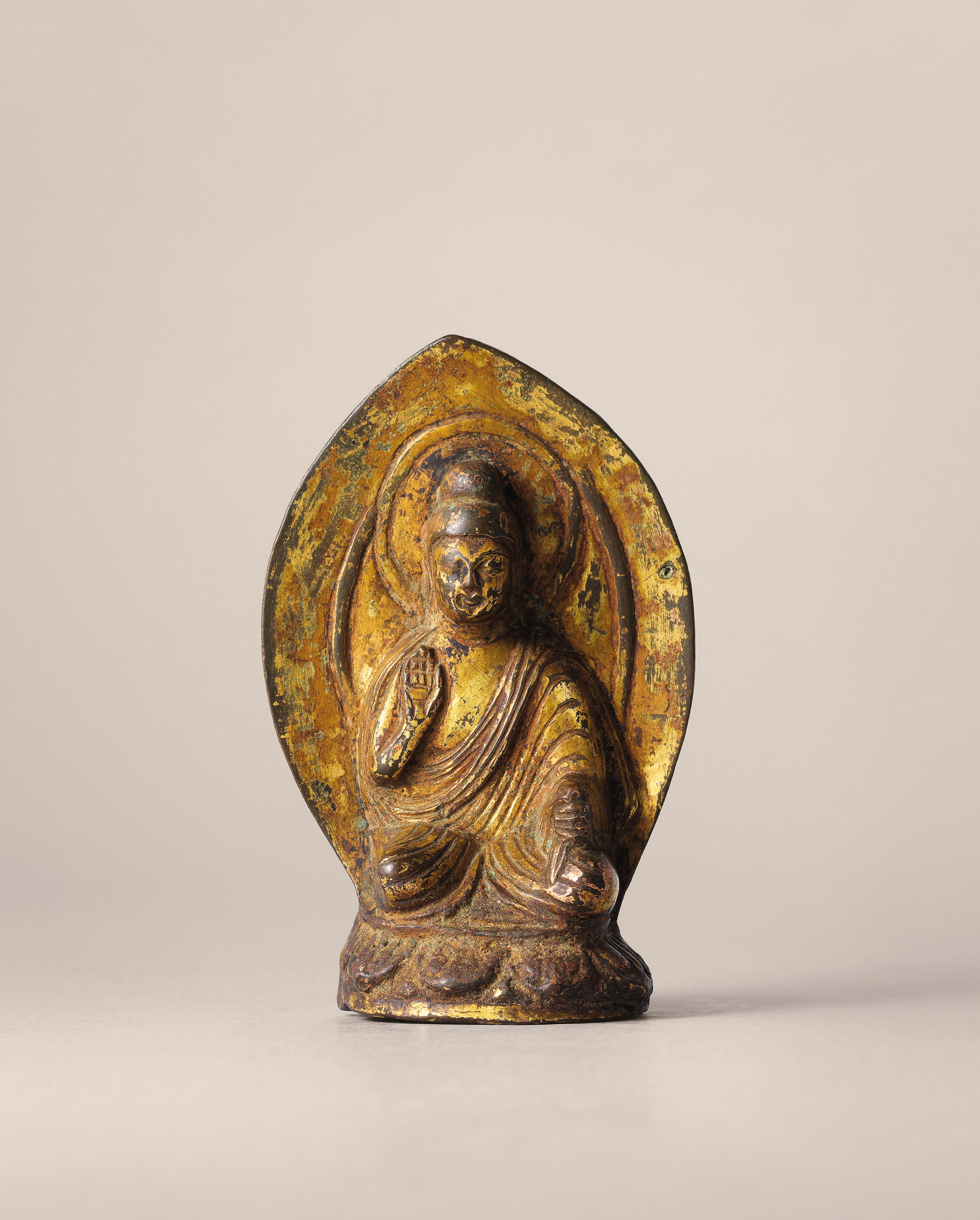
成交價 港元 1,062,500
估價 港元 200,000 – 港元 300,000
隋/唐 鎏金銅佛坐像
4 1/8 in. (10.5 cm.) high
來源 Provenance
戴潤齋舊藏,紐約蘇富比,2011 年3 月22 日,拍品276 號
J.T. Tai (1911-1992), sold at Sotheby’s New York, 22 March 2011, lot 276
A SMALL GILT-BRONZE FIGURE OF SEATED BUDDHA
SUI/TANG DYNASTY (581-907)
The figure is seated with legs crossed under a voluminous robe draped over the left shoulder. The right hand raised in abhayamudra, symbol of offering and holding the end of a scarf in the left hand resting on the corresponding knee.The figure is supported on an integral lotus flower base and surrounded by a petal-shaped body aureole, and further detailed with a circular head aureole.
4 1/8 in. (10.5 cm.) high
拍品專文
風格近似的北魏鎏金銅造像可參考一例載於金申《海外及港台藏歷代佛像:珍品紀年圖鑑》,山西,2007 年,頁430,以及日本私人舊藏一例,拍賣於紐約佳士得,2017 年9月14 日,拍品804 號(圖一)。
Lot Essay
Compare to two similar figures from the same period, one illustrated by Jin Shen in Haiwai ji Gangtai cang lidai foxiang: zhenpin jinian tujian (Catalogue of Treasures of Buddhist Sculptures in Overseas Collections Including Hong Kong and Taiwan), Shanxi, 2007, p. 430, the other from a private Japanese collection, sold at Christie’s New York, 14 September 2017, lot 804 (fig. 1).
狀況報告
– 總體品相良好,由於年代久遠,鎏金有輕微磨損,表面有微磕及撞痕,屬正常現象。
– 如圖可見,背光左側有一鑄造孔,為製造時產生。

![[临渊阁]天地一家春](https://www.antiquekeeper.ca/wp-content/uploads/2023/03/antiquekeeper_banner_image_2-4.jpg)
